Sony PM-0140 GSM/GPRS/EDGE/UMTS/HSPA/LTE mobile phone with Bluetooth, WLAN 802.11abgn, GPS/A-GPS, RFID and FM Rx User Manual Sony Ericsson Mobile Communications AB
Sony Mobile Communications Inc GSM/GPRS/EDGE/UMTS/HSPA/LTE mobile phone with Bluetooth, WLAN 802.11abgn, GPS/A-GPS, RFID and FM Rx Sony Ericsson Mobile Communications AB
Sony >
Contents
- 1. 08 manual
- 2. 08 user guide
- 3. 08 user guides
08 user guide

User guide
Xperia™ TL
LT30at
Contents
Important information..................................................................6
Android™ – what and why?.........................................................7
Applications.......................................................................................7
Getting started..............................................................................8
Assembly...........................................................................................8
Turning the phone on and off ...........................................................8
Screen lock........................................................................................9
Accounts and services.......................................................................9
Getting to know your phone......................................................11
Phone overview................................................................................11
Using the keys.................................................................................12
Battery..............................................................................................12
Using the touchscreen.....................................................................15
Using the lockscreen.......................................................................17
Home screen....................................................................................18
Accessing and using applications...................................................20
Status and notifications...................................................................22
Phone settings menu.......................................................................24
Typing text.......................................................................................24
Customising your phone..................................................................29
Memory............................................................................................32
Using a headset with your phone....................................................33
Controlling data usage.....................................................................33
Calling..........................................................................................35
Emergency calls...............................................................................35
Call handling....................................................................................35
Voicemail..........................................................................................37
Multiple calls....................................................................................37
Conference calls..............................................................................37
Call settings.....................................................................................38
Contacts .....................................................................................40
Transferring contacts to your new phone........................................40
Contacts screen overview...............................................................42
Managing your contacts..................................................................42
Communicating with your contacts.................................................44
Sharing your contacts......................................................................44
Backing up contacts........................................................................45
Messaging...................................................................................46
Using text and multimedia messaging.............................................46
2
This is an Internet version of this publication. © Print only for private use.
Text and multimedia message options............................................47
Email............................................................................................48
Using email......................................................................................48
Using email accounts.......................................................................51
Gmail™ and other Google™ services ............................................51
Google Talk™ ............................................................................53
Explore by Touch........................................................................54
Before using Explore by Touch........................................................54
Timescape™...............................................................................55
Timescape™ main view...................................................................55
Using Timescape™..........................................................................55
Timescape™ settings......................................................................57
Timescape™ Feed widget...............................................................57
Timescape™ Friends widget...........................................................58
Timescape™ Share widget..............................................................59
Getting started with Google Play™..........................................60
Downloading from Google Play™....................................................60
Clearing your application data.........................................................60
Permissions......................................................................................61
Installing applications not from Google Play™ ...............................61
Getting organised.......................................................................62
Calendar...........................................................................................62
Alarm clock......................................................................................62
Synchronising data on your phone...........................................65
Synchronising with Google™..........................................................65
Synchronising your corporate email, calendar and contacts..........66
Synchronising with Facebook™......................................................66
NFC..............................................................................................68
NFC detection area..........................................................................68
Connecting to wireless networks.............................................70
Wi-Fi® .............................................................................................70
Virtual private networks (VPNs)........................................................73
Web browser...............................................................................74
Browsing the web............................................................................74
Navigating web pages.....................................................................74
Browser Bar.....................................................................................75
Managing bookmarks......................................................................76
Managing text and images..............................................................77
Multiple windows.............................................................................77
Downloading from the web..............................................................78
Browser settings..............................................................................78
3
This is an Internet version of this publication. © Print only for private use.
Listening to music with the Walkman™ player.......................80
Protecting your hearing....................................................................80
Copying media files to your memory card ......................................80
Using the Walkman™ player ...........................................................80
Using the FM radio.....................................................................87
FM radio overview............................................................................87
Using your favourite radio channels................................................88
Making a new search for radio channels.........................................88
Switching the radio sound between devices...................................88
Switching between mono and stereo sound mode.........................88
Sharing the details of music you like on Facebook™......................89
Taking photos and recording videos........................................90
Camera controls overview...............................................................90
Using the still camera......................................................................90
Using the video camera...................................................................97
Viewing photos and videos in Album.....................................101
Album tab overview.......................................................................101
Mobile BRAVIA® Engine................................................................101
Viewing photos and videos saved in the phone ...........................101
Viewing your photos on a map......................................................105
Viewing your online albums...........................................................106
Playing video clips in Movies..................................................108
Playing your videos on other DLNA Certified™ devices...............108
Sharing content with DLNA Certified™ devices...................110
Playing files from DLNA Certified™ devices on your phone.........110
Preparing to play phone content on DLNA Certified™ devices....110
Playing phone content on other DLNA Certified™ devices...........111
Bluetooth™ wireless technology............................................112
Naming your phone.......................................................................112
Pairing with another Bluetooth™ device.......................................112
Sending and receiving items using Bluetooth™ technology.........113
Connecting your phone to a computer..................................115
Transferring and handling content using a USB cable..................115
Transferring files using Media transfer mode via Wi-Fi®...............115
Media Go™ ...................................................................................116
Connecting your phone to a TV set........................................117
Using location services to find your position........................118
Using GPS.....................................................................................118
Google Maps™..............................................................................119
Using Google Maps™ to get directions.........................................119
4
This is an Internet version of this publication. © Print only for private use.
Locking and protecting your phone.......................................120
IMEI number...................................................................................120
SIM card protection.......................................................................121
Setting a screen lock.....................................................................122
Updating your phone...............................................................125
Updating your phone wirelessly.....................................................125
Updating your phone using a USB cable connection....................125
Phone settings overview.........................................................127
Status and notification icons overview..................................129
Status icons...................................................................................129
Notification icons...........................................................................129
Application overview................................................................131
Troubleshooting.......................................................................132
My phone is not working as expected...........................................132
Resetting the phone.......................................................................132
No battery charging icon appears when phone starts charging....133
The battery performance is low.....................................................133
My wired headset does not work...................................................133
I cannot transfer content between my phone and the computer,
when using a USB cable................................................................133
Error messages..............................................................................133
Hearing Aid Compatibility........................................................135
Hearing Aid Settings......................................................................135
Hearing Aid Compatibility Information...........................................135
Hearing Aid Compatibility Rating...................................................135
Recycling your phone..............................................................136
Legal information.....................................................................137
Index..........................................................................................138
5
This is an Internet version of this publication. © Print only for private use.

Important information
Please read the Important information leaflet before you use your mobile phone.
This User guide may reference services or applications provided by third parties. Use of such
programming or services may require separate registration with the third party provider and
may be subject to additional terms of use. For applications accessed on or through a third
party Web site, please review such Web sites’ terms of use and applicable privacy policy in
advance. Sony does not warrant or guarantee the availability or performance of any third party
Web sites or offered services. Some of the services and features described in this User guide
are not supported in all countries/regions or by all networks and/or service providers in all
areas. Without limitation, this applies to the GSM International Emergency Number, 112.
Please contact AT&T to determine availability of any specific service or feature and whether
additional access or usage fees apply.
Use of certain features and applications described in this guide may require access
to the Internet. You may incur data connection charges when you connect to the
Internet from your phone. Contact your wireless service provider for more
information.
6
This is an Internet version of this publication. © Print only for private use.

Android™ – what and why?
Your Xperia smartphone from Sony runs on the Android platform. Android phones
can perform many of the same functions as a computer and you can customise them
to your own needs. For example, you can add and delete applications, or enhance
existing applications to improve functionality. On Google Play™ you can download a
range of applications and games from a constantly growing collection. You can also
integrate applications on your Android™ phone with other applications and with
online services that you use. For example, you can back up your phone contacts,
access your different email accounts and calendars from one place, keep track of
your appointments, and engage in social networking.
Your Android™ phone is pre-loaded with Google™ services. To get the most out of the
provided Google™ services, you should have a Google™ account and sign in to it when you
first start your phone. You also need to have Internet access to use many of the features in
Android™.
Applications
An application is a phone program that helps you perform a task. For example, there
are applications to make calls, take photos and download more applications.
7
This is an Internet version of this publication. © Print only for private use.
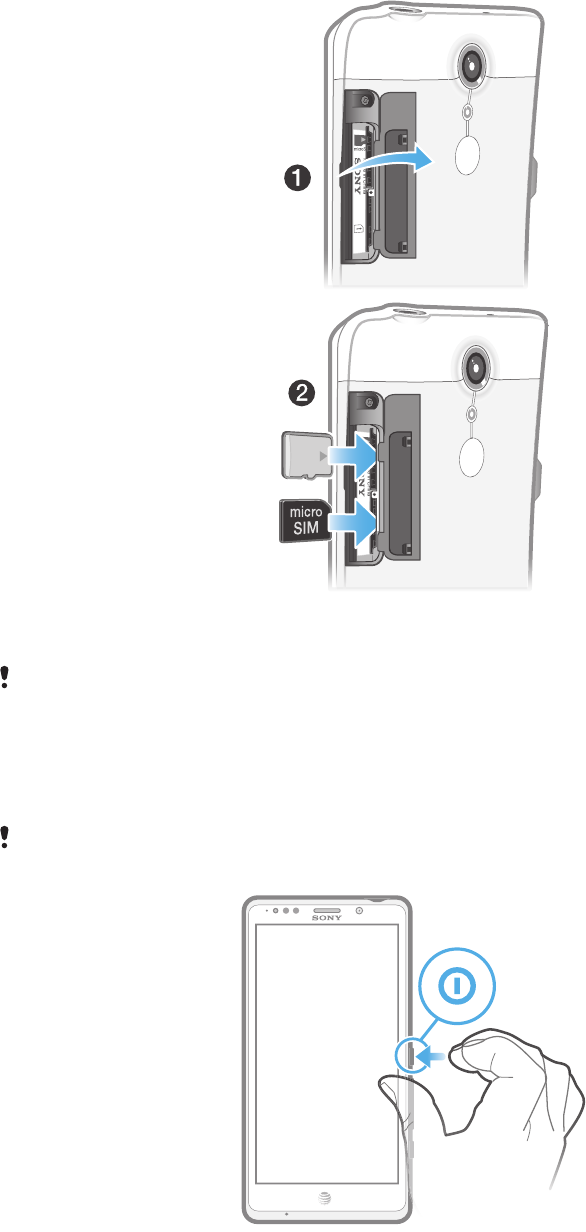
Getting started
Assembly
To insert the memory card and the micro SIM card
1Remove the cover for the memory card and the micro SIM card.
2Insert the memory card and the micro SIM card into the relevant slots.
The memory card may not be included at purchase in all markets.
Turning the phone on and off
To turn on the phone
Make sure that the battery is charged for at least 30 minutes before you turn on the phone for
the first time.
8
This is an Internet version of this publication. © Print only for private use.
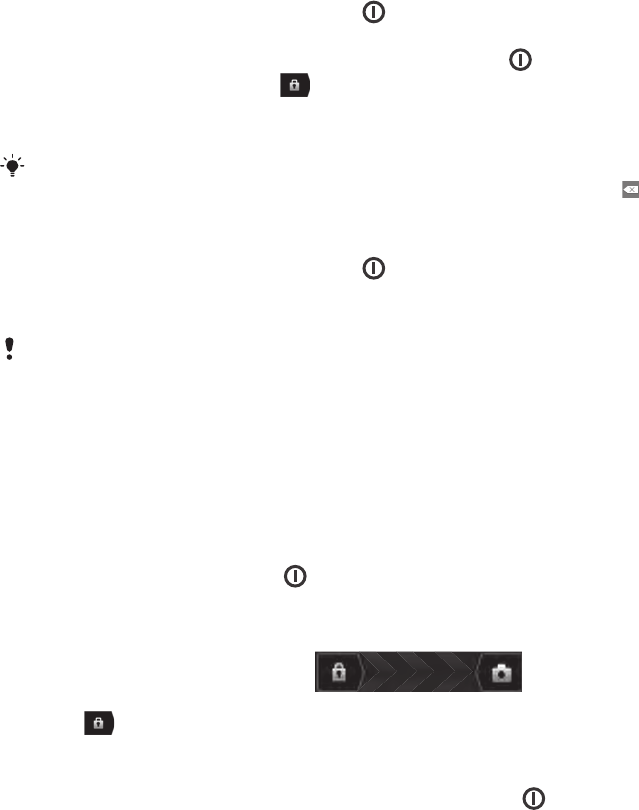
1Press and hold down the power key on the right side of the phone until the
phone vibrates.
2If your screen goes dark, briefly press the power key to activate the screen.
3To unlock the screen, drag to the right across the screen.
4Enter your SIM card PIN when requested, and select OK.
5Wait a while for the phone to start.
Your SIM card PIN is initially supplied by AT&T, but you can change it later from the Settings
menu. To correct a mistake made while entering your SIM card PIN, tap .
To turn off the phone
1Press and hold down the power key until the options menu opens.
2In the options menu, tap Power off.
3Tap OK.
It may take a while for the phone to shut down.
Screen lock
When your phone is on and left idle for a set period of time, the screen darkens to
save battery power, and locks automatically. This lock prevents unwanted actions on
the touch screen when you are not using it.
To activate the screen
•Briefly press the power key .
To unlock the screen
•Drag to the right across the screen.
To lock the screen manually
•When the screen is active, briefly press the power key .
Accounts and services
Sign in to your online service accounts from your phone and benefit from a range of
services. Combine services and get even more out of them. For example, collect
contacts from your Google™ and Facebook™ accounts and integrate them into your
phonebook, so you have everything in one place.
You can sign up to online services from your phone as well as from a computer.
When you sign up for the first time, an account is created with your user name,
password, settings and personal information. The next time you sign in, you get a
personalised view.
Google™ account
Having a Google™ account is key to using a range of applications and services with
your Android phone. You need a Google™ account, for example, to use the Gmail™
application in your phone, to chat with friends using Google Talk™, to synchronise
your phone calendar with your Google Calendar™, and to download applications and
games, music, movies and books from Google Play™.
Microsoft® Exchange ActiveSync® account
Synchronise your phone with your corporate Microsoft® Exchange ActiveSync®
account. This way, you keep your work email, contacts and calendar events with you
at all times.
9
This is an Internet version of this publication. © Print only for private use.
Facebook™ account
Facebook™ is a social networking service that connects you with friends, family and
colleagues around the world. Set up Facebook to work on your phone so that you
can stay in touch from anywhere.
10
This is an Internet version of this publication. © Print only for private use.

Getting to know your phone
Phone overview
123
456
7
8
9
10
11
12
13
14
15
16
17
18
19
20
21
11
This is an Internet version of this publication. © Print only for private use.
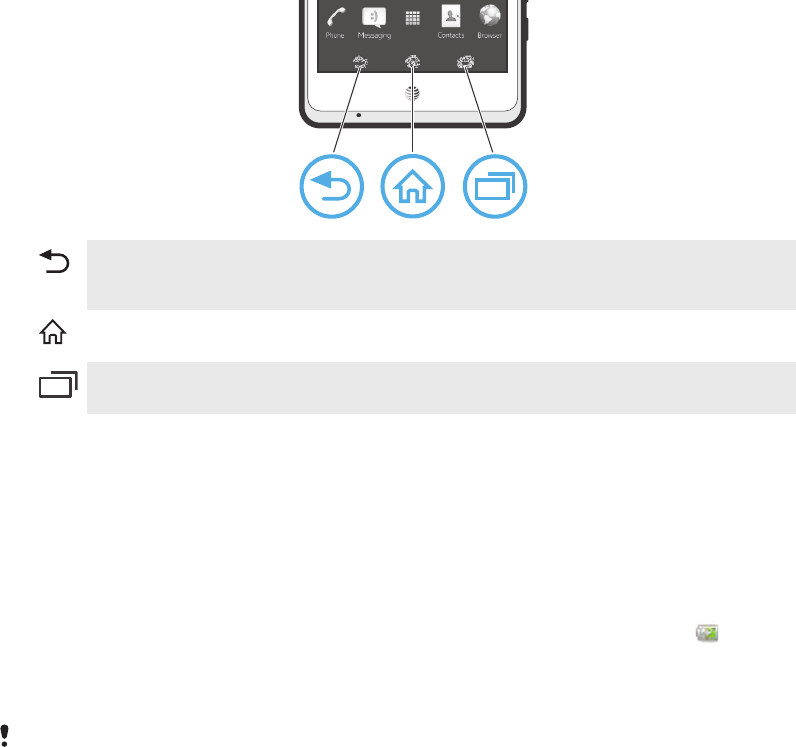
1. Notification LED
2. Light sensor
3. Proximity sensor 1
4. Proximity sensor 2
5. Ear speaker
6. Front camera lens
7. Headset connector
8. Power key
9. Volume/Zoom key
10. Camera key
11. Main microphone
12. Touchscreen
13. Second microphone
14. Camera lens
15. Camera LED light
16. NFC detection area
17. Connector for charger/USB cable
18. Speaker
19. SIM card slot
20. microSD™ card slot
21. SIM card/microSD™ card cover
Using the keys
Back
•Go back to the previous screen
•Close the on-screen keypad, a dialog box, an options menu, or the Notification panel
Home
•Go to the Home screen
Task
•Tap to open a window showing your most recently used applications and a small apps bar
Battery
Your phone has an embedded battery.
Charging the battery
Charge your phone for at least 30 minutes before you turn on the phone for the first
time. When you connect the phone charger cable to a power source, such as a USB
port or a phone charger, it may take a few minutes before the battery icon
appears on the screen. You can still use your phone while it is charging. Charging the
phone over a long period of time, for example, overnight, does not damage the
battery or the phone.
The battery will start to discharge a little after it is fully charged and then charges again after a
certain time when the phone charger is connected. This is to extend battery life and may result
in the charge status showing a level below 100 percent.
12
This is an Internet version of this publication. © Print only for private use.
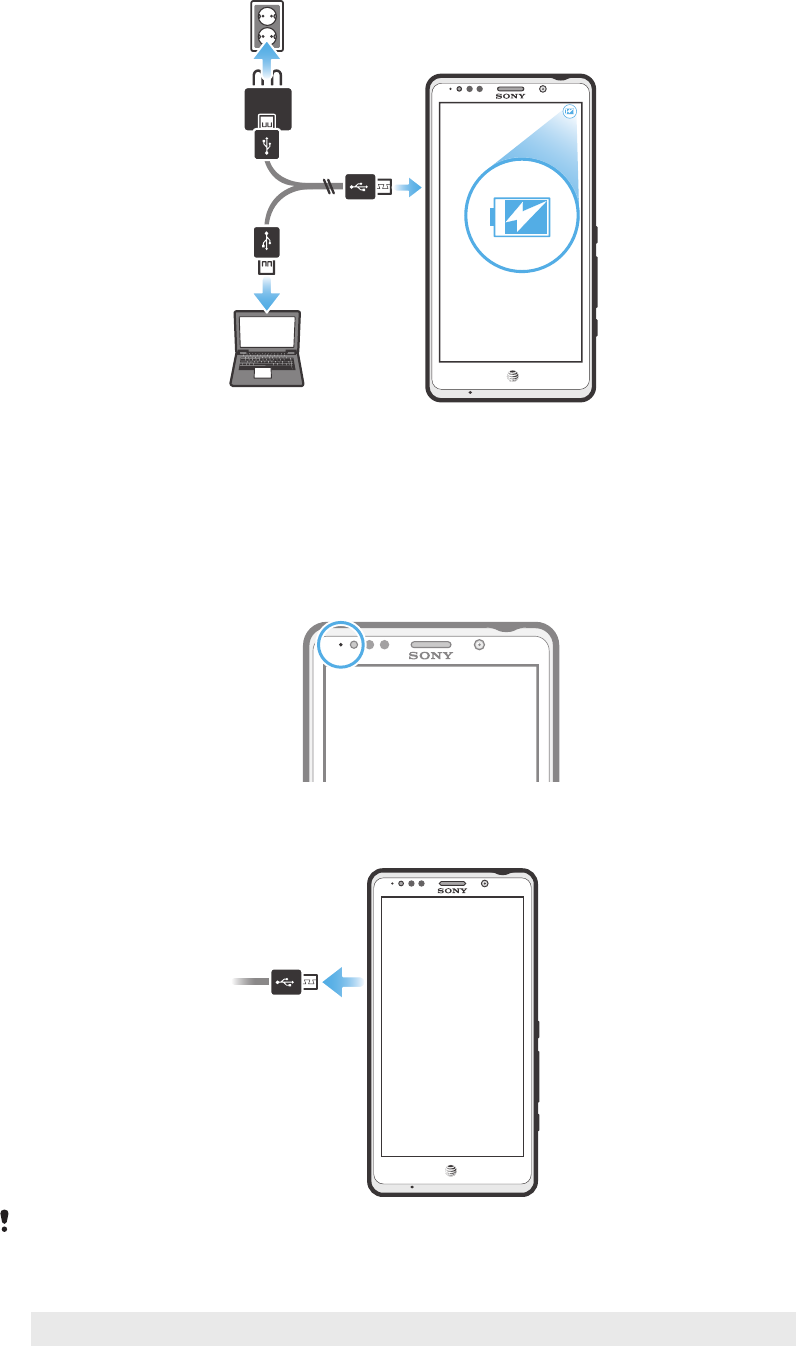
To charge the phone
1Plug the phone charger into a power outlet.
2Plug one end of the USB cable into the charger (or into the USB port of a
computer).
3Plug the other end of the cable into the micro USB port on your phone, with
the USB symbol facing up. The battery status LED lights up when charging
starts. If the battery is completely discharged, it may take a few minutes before
the LED lights up after you connect the phone charger cable to a power
source.
4When the battery status LED is green, the phone is fully charged. Disconnect
the USB cable from your phone by pulling it straight outwards. Make sure not
to bend the connector when removing the cable from the phone.
Use the charger and USB cable provided with the phone to ensure faster charging.
Battery LED status
Green The battery is fully charged
Flashing red The battery level is low
13
This is an Internet version of this publication. © Print only for private use.

Orange The battery is charging. The battery level is between low and full
To check the battery level
1From your Home screen, tap .
2Find and tap Settings > About phone > Status > Battery level.
Improving battery performance
The following tips can help you improve battery performance:
•Charge your phone often. This will not affect the lifetime of the battery.
•Downloading data from the Internet is power consuming. When you're not using the
Internet, you can save power by disabling all data connections over mobile networks.
This setting does not prevent your phone from transmitting data over other wireless
networks.
•Turn off GPS, Bluetooth™ and Wi-Fi® when you don't need these features. You can
turn them on and off more easily by adding the Quick settings widget to your Home
screen.
•Use the Power Saver feature to reduce battery consumption. You can select the
power saving mode that best suits the way you use your phone. You can also
customise the settings of each power saving mode.
•Set your synchronisation applications (used to synchronise your email, calendar and
contacts) to synchronise manually. You can also synchronise automatically, but
increase the synchronisation intervals.
•Check the battery usage menu in the phone to see which applications use the most
power. Your battery consumes more power when you use video and music streaming
applications, such as YouTube™. Some applications downloaded from Google
Play™ may also consume more power.
•Close and exit applications that you are not using.
•Lower the screen display brightness level.
•Turn off your phone or activate the Airplane mode setting if you are in an area with
no network coverage. Otherwise, your phone repeatedly scans for available
networks, and this consumes power.
•Use a Sony original handsfree device to listen to music. Handsfree devices demand
less battery power than the phone's loudspeakers.
•Keep your phone in standby whenever possible. Standby time refers to the time
during which the phone is connected to the network and is not being used.
•Disable any live wallpaper.
•Go to www.att.com/tutorials to get the latest battery performance tips for your phone
model.
To access the battery usage menu
1From your Home screen, tap .
2Find and tap Settings > Battery to see which installed applications consume
the most battery power.
To add the Data traffic widget to your Home screen
1Tap an empty area of your Home screen.
2Tap .
3Tap Tools > Data traffic.
To add the Quick settings widget to your Home screen
1Tap an empty area of your Home screen.
2Tap > Tools.
3Select the Quick settings widget.
Reducing battery consumption with Power Saver
Use pre-set power saving modes to manage power consuming applications and
reduce battery consumption. With Power Saver, you can also customise the settings
within each power saving mode to the way you use your phone.
14
This is an Internet version of this publication. © Print only for private use.

To activate a power saving mode
1From your Home screen, tap .
2Find and tap Power Saver.
3Tap the icon next to the power saving mode that you want to activate.
To deactivate a power saving mode
1From your Home screen, tap .
2Find and tap Power Saver.
3Tap the illuminated icon next to the active power saving mode to turn it off.
To change the settings for a power saving mode
1From your Home screen, tap .
2Find and tap Power Saver.
3To open the settings menu, tap the name of a power saving mode.
4Adjust the settings as desired to save power.
5Tap .
To display power saver notifications
1From your Home screen, tap .
2Find and tap Power Saver.
3Tap .
4Mark the Status bar checkbox.
Using the touchscreen
A protective plastic sheet is attached to the screen of your phone when you buy it.
You should peel off this sheet before using the touchscreen. Otherwise, the
touchscreen might not function properly.
When your phone is on and left idle for a set period of time, the screen darkens to
save battery power, and locks automatically. This lock prevents unwanted actions on
the touchscreen when you are not using it. You can also set personal locks to protect
your subscription and make sure only you can access your phone content.
Your phone screen is made from glass. Do not touch the screen if the glass is cracked or
shattered. Avoid trying to repair a damaged screen yourself. Glass screens are sensitive to
drops and mechanical shocks. Cases of negligent care are not covered by the Sony warranty
service.
To open or highlight an item
•Tap the item.
To mark or unmark options
•Tap the relevant checkbox or the switch beside the option name.
Marked checkbox
Unmarked checkbox
Switched on
Switched off
Zooming
The zoom options available depend on the application you are using.
To zoom
•When available, tap or to zoom in or out.
You may have to drag the screen (in any direction) to make the zoom icons appear.
15
This is an Internet version of this publication. © Print only for private use.
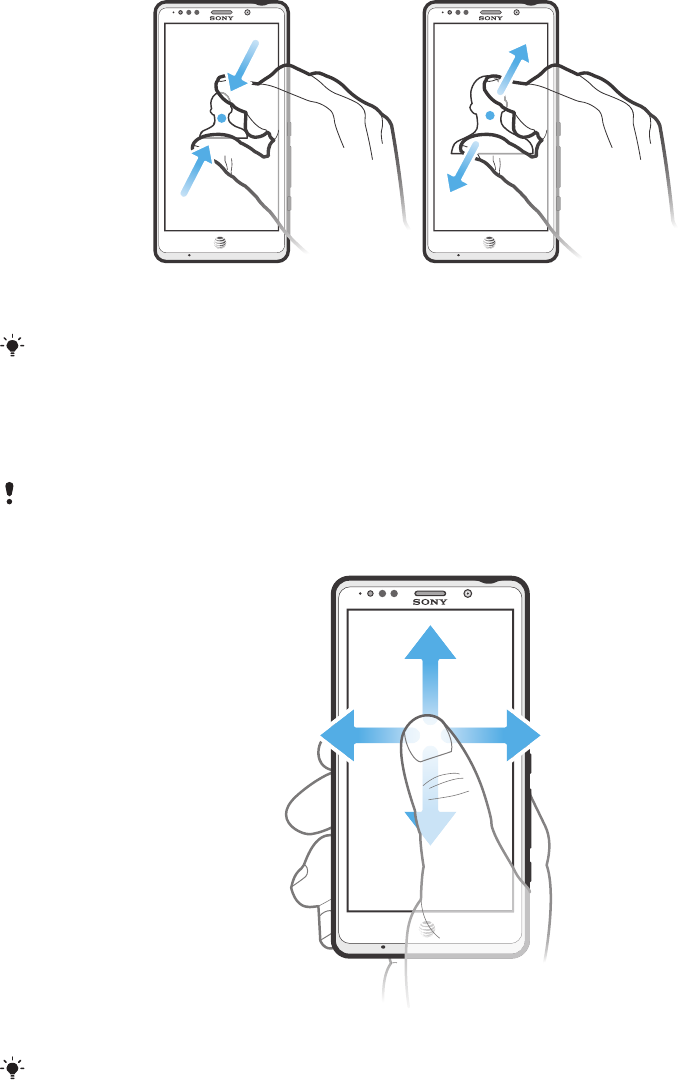
To zoom with two fingers
•Place two fingers on the screen at once and pinch them together (to zoom out)
or spread them apart (to zoom in).
Use the zoom function when viewing photos and maps, or when browsing the web.
Scrolling
Scroll by moving your finger up or down on the screen. On some web pages you can
also scroll to the sides.
Dragging or flicking will not activate anything on the screen.
To scroll
•Drag or flick your finger in the direction you want to scroll on the screen.
To scroll more quickly, flick your finger in the direction you want to go on the screen.
16
This is an Internet version of this publication. © Print only for private use.

To flick
•To scroll more quickly, flick your finger in the direction you want to go on the
screen. You can wait for the scrolling movement to stop by itself, or you can
stop it immediately by tapping the screen.
Sensors
Your phone has sensors that detect both light and proximity. The light sensor detects
the ambient light level and adjusts the brightness of the screen accordingly. The
proximity sensor turns the touch screen off when your face touches the screen. This
prevents you from unintentionally activating phone functions when you are engaged
in a call.
Using the lockscreen
On the lockscreen, you can still view notifications, for example, notifications of
missed calls and messages that arrived since the phone was last locked. You can
also control the playback of audio tracks without unlocking the screen.
To view missed calls from the lockscreen
1To activate the screen, briefly press the power key .
2Drag
to the right across the screen.
To view new text messages from the lockscreen
1To activate the screen, briefly press the power key .
2Drag
to the right across the screen.
17
This is an Internet version of this publication. © Print only for private use.
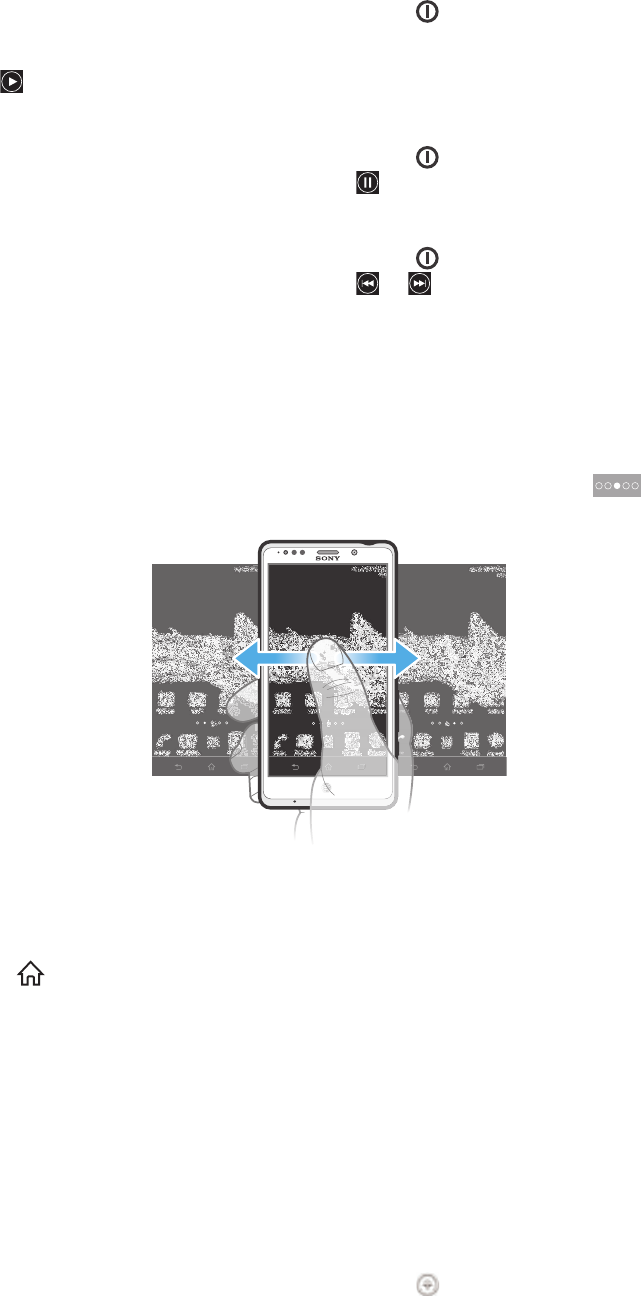
To play an audio track from the lockscreen
1To activate the screen, briefly press the power key .
2To display music player controls, place a finger on the time and date area and
flick to the left.
3Tap .
To pause an audio track from the lockscreen
1To activate the screen, briefly press the power key .
2When the music player controls appear, tap .
To change the currently playing audio track from the lockscreen
1To activate the screen, briefly press the power key .
2When the music player controls appear, tap or .
Home screen
Your phone Home screen is the equivalent of the desktop on a computer. It's your
gateway to the main features in your phone. You can customise your Home screen
with widgets, shortcuts, folders, themes, wallpaper and other items.
The Home screen extends beyond the regular screen display width, so you need to
flick left or right to view content in one of the screen's four extensions. shows
which part of the Home screen you are in.
The items in the bar at the bottom of the screen are always available for quick
access.
To go to the Home screen
•Press .
To browse the Home screen
•Flick right or left.
Widgets
Widgets are small applications that you can use directly on your Home screen. For
example, the Music player widget allows you to start playing music directly.
Some widgets are resizable, so you can expand them to view more content or shrink
them to save space on your Home screen.
To add a widget to the Home screen
1Tap an empty area on your Home screen, then tap .
2Find and tap the widget that you want to add.
18
This is an Internet version of this publication. © Print only for private use.
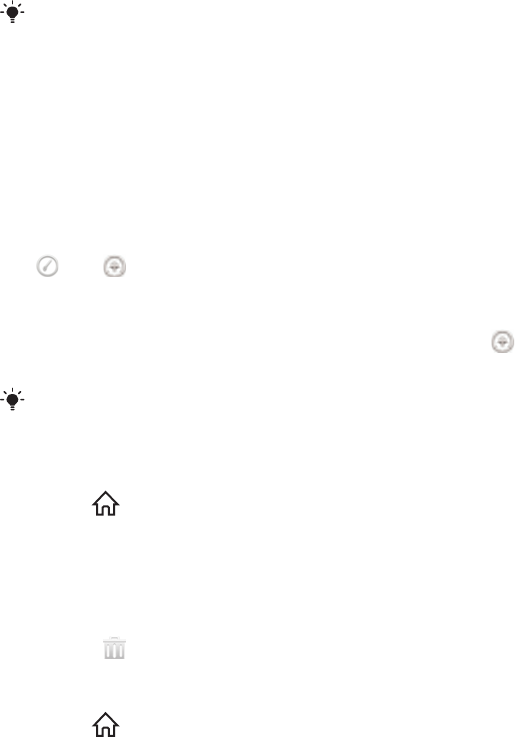
To resize a widget
1Touch and hold a widget until it magnifies and the phone vibrates, then release
the widget. If the widget can be resized, for example, the Calendar widget,
then a highlighted frame and resizing dots appear.
2Drag the dots inward or outward to shrink or expand the widget.
3To confirm the new size of the widget, tap anywhere on the Home screen.
To get an overview of all widgets on your Home screen
•Pinch on any area of your Home screen. All widgets from different parts of your
Home screen are now displayed in one view.
When all Home screen widgets are combined in one view, tap on any widget to go to the part
of the Home screen containing that widget.
Rearranging your Home screen
Customise the appearance of your Home screen and change the features that you
can access from it. Change the screen background, move items around, create
folders, and add shortcuts and widgets.
To view customisation options from the Home screen
•Tap an empty area on your Home screen. Customisation options, indicated by
and , appear at the top of your Home screen.
To add a shortcut to your Home screen
1Tap an empty area on your Home screen, then tap .
2Tap Shortcuts, then find and select a shortcut.
Add an application shortcut directly from the Application screen by touching and holding the
application.
To move an item on the Home screen
1Press to open your Home screen.
2Touch and hold an item until it becomes moveable and the phone vibrates,
then drag the item to the new location.
To delete an item from the Home screen
•Touch and hold an item until it magnifies and the phone vibrates, then drag the
item to .
To create a folder on the Home screen
1Press to open your Home screen.
2Touch and hold an application icon or a shortcut until it magnifies and the
phone vibrates, then drag and drop it on top of another application icon or
shortcut.
3Enter a name for the folder and tap Done.
To add items to a folder
•Touch and hold an item until it magnifies and the phone vibrates, then drag the
item to the folder.
To rename a folder
1Tap the folder to open it.
2Touch the folder's title bar to show the Folder name field.
3Enter the new folder name and tap Done.
Changing the background of your Home screen
Adapt the Home screen to your own style using wallpapers and different themes.
19
This is an Internet version of this publication. © Print only for private use.
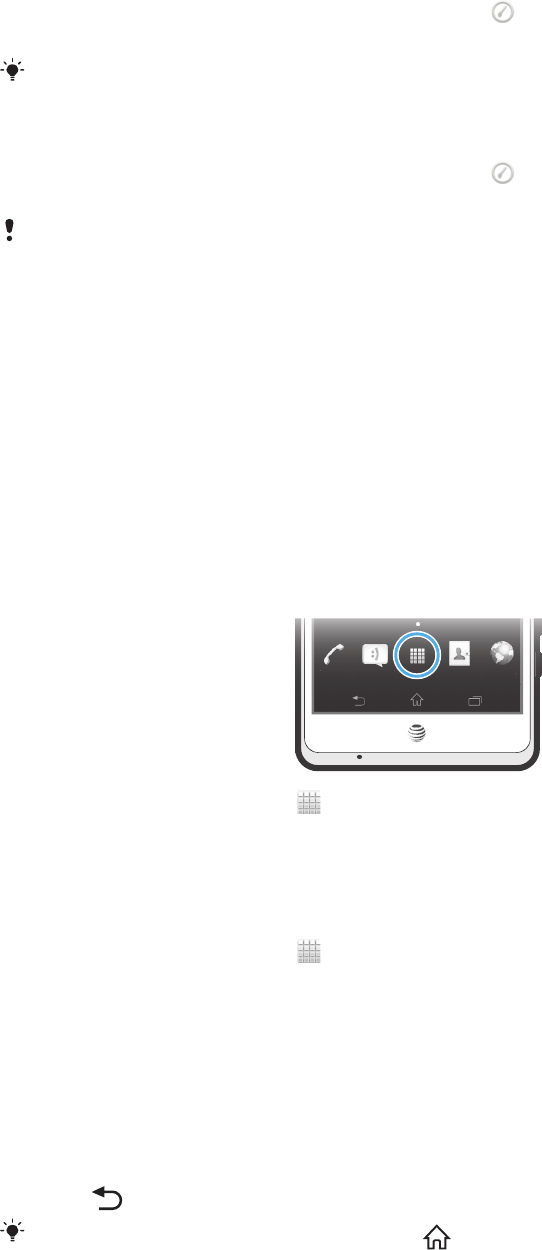
To change your Home screen wallpaper
1Tap an empty area on your Home screen, then tap .
2Tap Wallpaper and select an option.
You can use a photo you have taken, or an animation. Go to Google Play™ and other sources
to download, for example, live wallpapers that change with the changing hours of the day.
To set a theme for your Home screen
1Tap an empty area on your Home screen, then tap .
2Tap Theme and select a theme.
When you change a theme, the background also changes in some applications.
Accessing and using applications
Open applications from shortcuts on your Home screen or from the Application
screen.
Application screen
The Application screen, which you open from your Home screen, contains the
applications that come installed with your phone as well as the applications you
download.
The Application screen extends beyond the regular screen width, so you need to flick
left and right to view all content.
To open the Application screen
•From your Home screen, tap .
To browse the Application screen
•From the Application screen, flick right or left.
To create a shortcut to an application on the Home screen
1From your Home screen, tap .
2Touch and hold an application until it appears on your Home screen, then drag
it to the desired location.
Opening and closing applications
To open an application
•From your Home screen or the Application screen, tap the application.
To close an application
•Press .
Some applications are paused when you press to exit, while other applications may
continue to run in the background. In the first case, the next time you open the application,
you can continue where you left off. Remember that some applications may cause data
connection charges when they are running in the background, for example, social networking
services.
20
This is an Internet version of this publication. © Print only for private use.
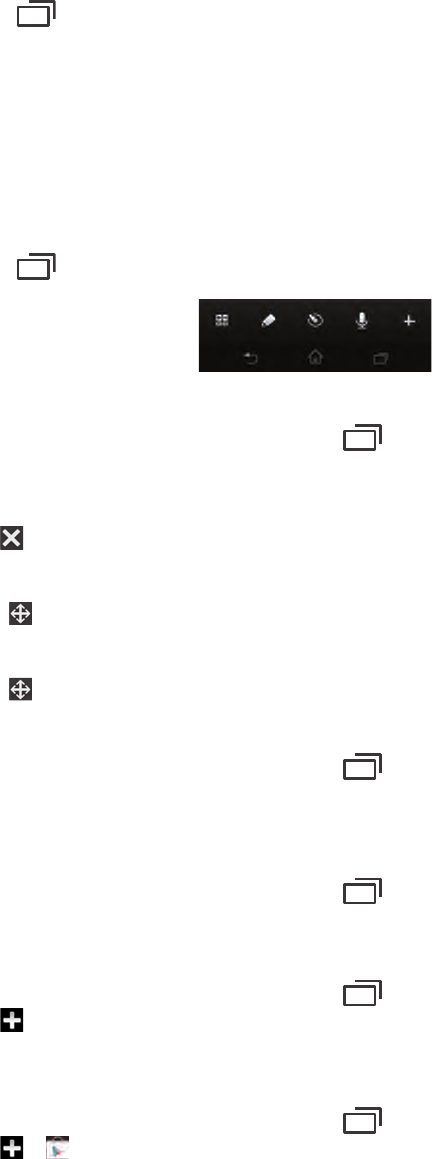
Recently used applications window
You can switch between recently used applications from this window. You can also
open small apps.
To open the recently used applications window
•Press . The recently used applications window appears on the right of the
screen.
Using small apps
From the recently used applications window, you can get quick access to several
small apps at any time using the small apps bar. A small app only takes up a small
area of your screen. So you can interact with a small app and another application at
the same time on the same screen.
To open the small apps bar
•Press . The small apps bar appears at the bottom of the screen.
To open a small app
1To make the small apps bar appear, press .
2Tap the small app that you want to open. A small app window appears.
To close a small app
•Tap on the small app window.
To move a small app
•Drag to move and drop the small app to the desired position.
To minimise a small app
•Drag to the right edge or bottom edge of the screen.
To rearrange your small apps
1To make the small apps bar appear, press .
2Touch and hold a small app and drag it to the desired position in the small
apps bar.
To remove a small app from the small apps bar
1To make the small apps bar appear, press .
2Touch and hold a small app icon and drag it away from the small apps bar.
To restore a previously removed small app
1To make the small apps bar appear, press .
2Tap > Installed small apps.
3Select the small app that you want to restore.
To download a small app
1To make the small apps bar appear, press .
2Tap > .
3Find a small app that you want to download, then follow the instructions to
complete the installation.
21
This is an Internet version of this publication. © Print only for private use.
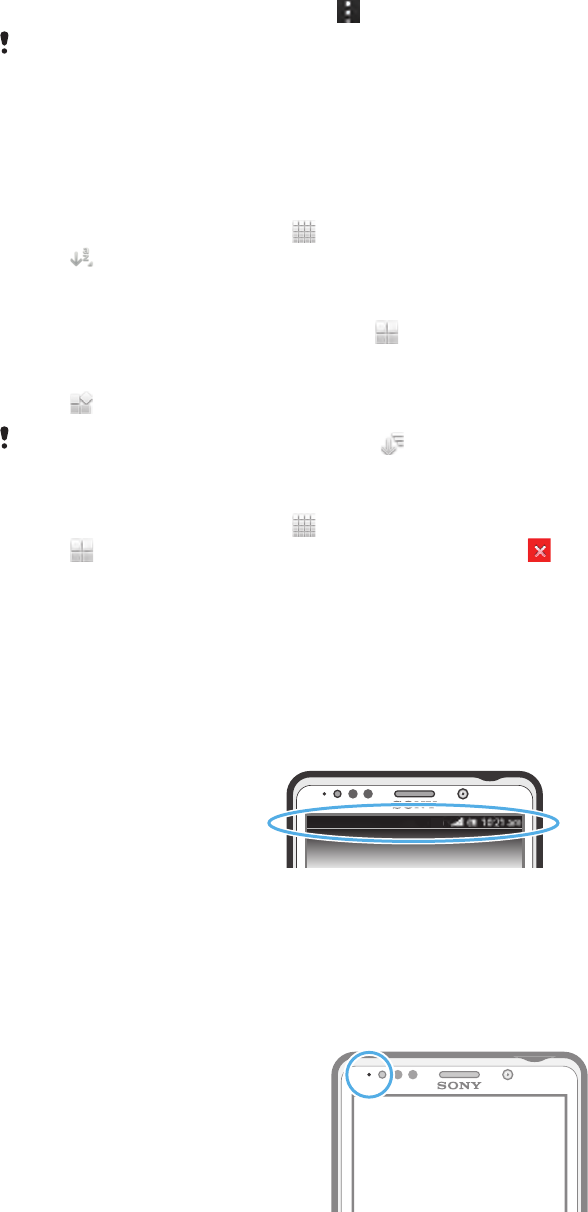
Application menu
You can open a menu at any time when you are using an application. The menu will
look different depending on which application you are using.
To open a menu in an application
•While using the application, press .
A menu is not available in all applications.
Rearranging your Application screen
Move the applications around on the Application screen according to your
preferences.
To arrange applications on the Application screen
1From your Home screen, tap to go to the Application screen.
2Tap and select an option.
To move an application on the Application screen
1Open the Application screen, then tap .
2Touch and hold an item until it magnifies and the phone vibrates, then drag the
item to the new location.
3Tap to exit edit mode.
You can only move your applications when is selected.
To uninstall an application from the Application screen
1From your Home screen, tap .
2Tap . All uninstallable applications are marked with a icon.
3Tap the application you want to uninstall, then tap OK.
Status and notifications
The status bar at the top of your screen shows what's going on in your phone. To the
left you get notifications when there is something new or ongoing. For example, new
message and calendar notifications appear here. The right side shows the signal
strength, battery status, and other information.
The status bar allows you to adjust basic settings on your phone, for example,
Wi-Fi®, Bluetooth™, data traffic, and sound. You can also open the settings menu
from the Notification panel to change other settings.
A notification light also gives you battery status information and some notifications.
For example, a flashing blue light means there is a new message or a missed call.
The notification light may not work when the battery level is low.
22
This is an Internet version of this publication. © Print only for private use.

Checking notifications and ongoing activities
You can drag down the status bar to open the Notification panel and get more
information. For example, you can use the panel to open a new message or view a
calendar event. You can also open some applications that run in the background,
such as the music player.
To open the Notification panel
•Drag the status bar downwards.
To close the Notification panel
•Drag the tab at the bottom of the Notification panel upwards.
To open a running application from the Notification panel
•Tap the icon for the running application to open it.
To dismiss a notification from the Notification panel
•Place your finger on a notification and flick left or right.
To clear the Notification panel
•From the Notification panel, tap Clear.
Setting your phone from the Notification panel
You can open the settings menu from the Notification panel to adjust basic phone
settings. For example, you can turn on Wi-Fi®.
23
This is an Internet version of this publication. © Print only for private use.
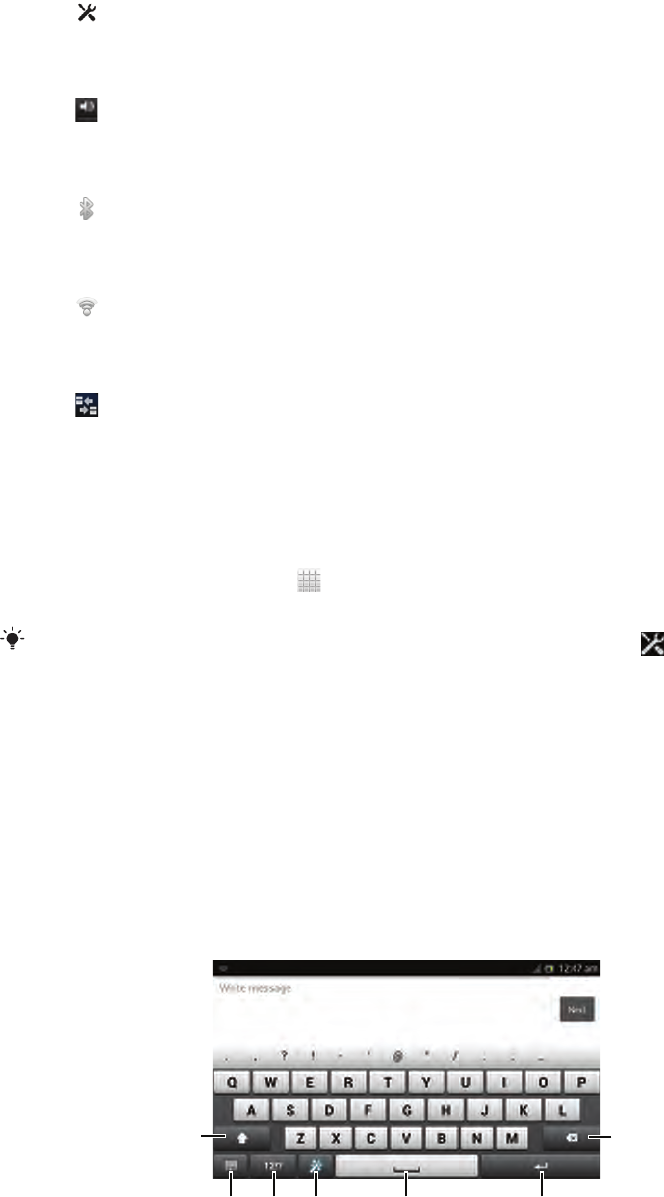
To open the phone settings menu from the Notification panel
1Drag the status bar downwards.
2Tap .
To adjust sound settings from the Notification panel
1Drag the status bar downwards.
2Tap .
To control the Bluetooth™ function from the Notification panel
1Drag the status bar downwards.
2Tap .
To control the Wi-Fi® function from the Notification panel
1Drag the status bar downwards.
2Tap .
To enable or disable data traffic from the Notification panel
1Drag the status bar downwards.
2Tap .
Phone settings menu
View and change your phone settings from the Settings menu.
To access the phone settings
1From your Home screen, tap .
2Tap Settings.
You can also drag the status bar downwards on the Home screen and tap to access the
phone settings.
Typing text
On-screen keyboard
Tap the keys of the on-screen QWERTY keyboard to enter text conveniently. Some
applications open the on-screen keyboard automatically. You can also open this
keyboard by touching a text field.
Using the on-screen keyboard
6
7
3
1
542
1Change the character case and turn on the caps lock. For some languages, this key is used to access
extra characters in the language.
2 Close the on-screen keyboard view. Note that this icon does not appear in portrait mode.
3 Display numbers and symbols.
24
This is an Internet version of this publication. © Print only for private use.
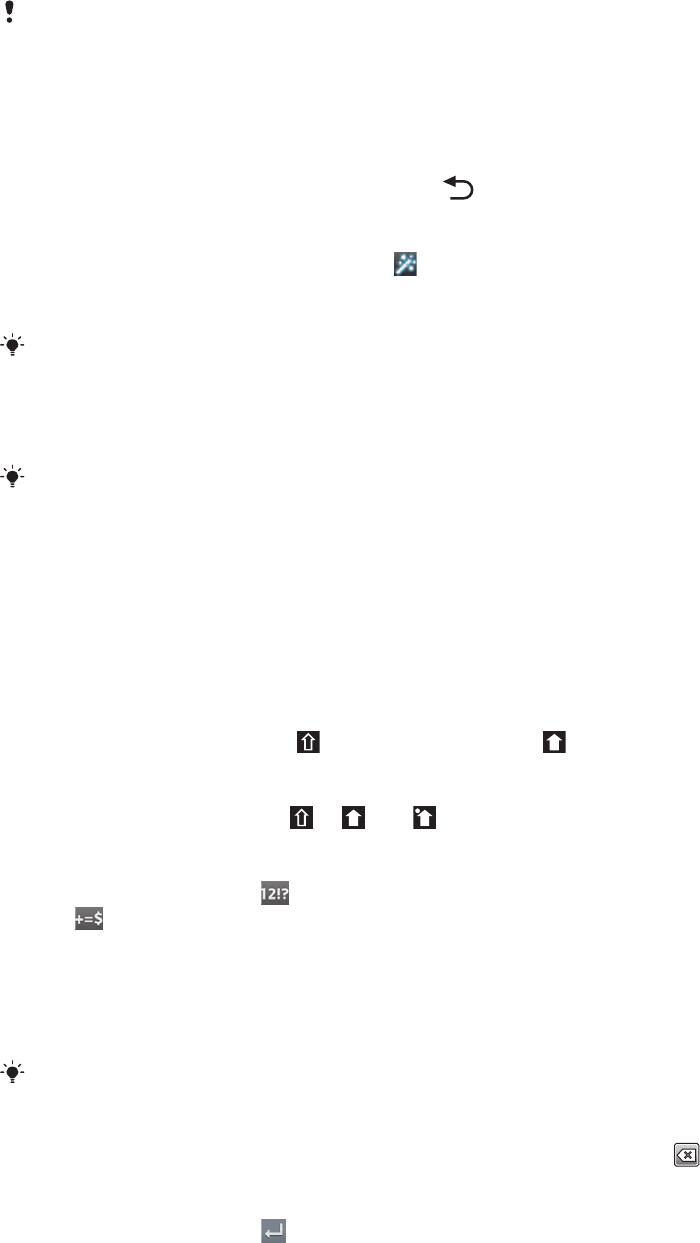
4 Personalise your keyboard. This key disappears after the keyboard is personalised.
5 Enter a space.
6 Enter a carriage return or confirm text input.
7 Delete a character before the cursor.
All illustrations are for illustration purposes only and may not accurately depict the actual
phone.
To display the on-screen keyboard to enter text
•Tap a text entry field.
To hide the on-screen keyboard
•When the on-screen keyboard is open, press .
To personalise the on-screen keyboard
1Open the on-screen keyboard, then tap .
2Follow the instructions to personalise your on-screen keyboard, for example,
mark the Smiley key checkbox.
If you don't mark the Smiley key checkbox when you personalise the on-screen keyboard, the
smiley icon will not appear.
To use the on-screen keyboard in landscape orientation
•When you enter text, turn the phone sideways.
For the keyboard to support this feature, landscape mode must be supported by the
application you are using, and your screen orientation settings must be set to automatic.
To enter text using the on-screen keyboard
1To enter a character visible on the keyboard, tap the character.
2To enter a character variant, touch and hold a regular keyboard character to
get a list of available options, then select from the list. For example, to enter
"é", touch and hold "e" until other options appear, then, while keeping your
finger pressed on the keyboard, drag to and select "é".
To shift between upper-case and lower-case letters
•Before you enter a letter, tap to switch to upper-case , or vice versa.
To turn on the caps lock
•Before you type a word, tap or until appears.
To enter numbers or symbols
•When you enter text, tap . A keyboard with numbers and symbols appears.
Tap to view more options.
To enter common punctuation marks
1When you finish entering a word, tap the space bar.
2Select a punctuation mark from the candidate bar. The selected mark is
inserted before the space.
To quickly enter a full stop, tap the space bar twice when you finish entering a word.
To delete characters
•Tap to place the cursor after the character you want to delete, then tap .
To enter a carriage return
•When you enter text, tap to enter a carriage return.
25
This is an Internet version of this publication. © Print only for private use.
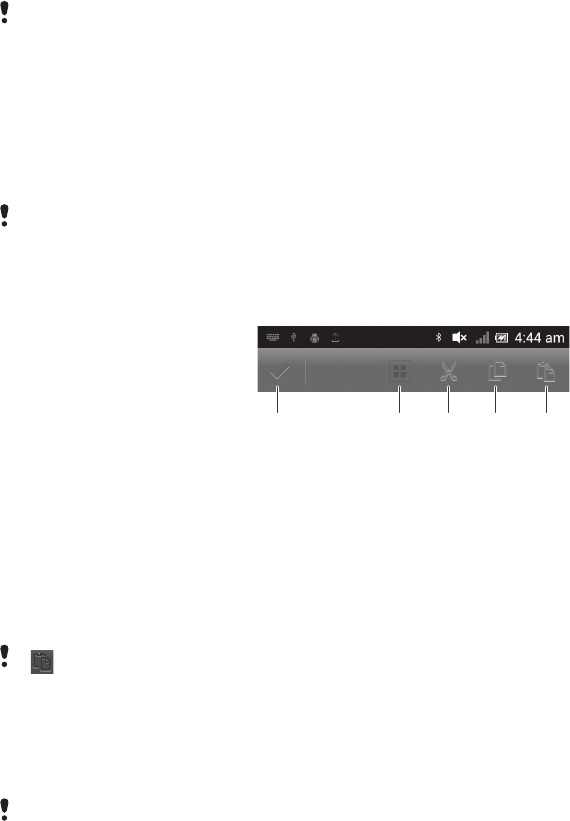
To use the magnifier
•When you enter text, tap and hold on the text field to view the text magnified
and to place the cursor where you want within the text field.
To select text
1When you enter text, double-tap within the text field.
2The word you tap gets highlighted by tabs on both sides. Drag the tabs left or
right to select more text.
To edit text in landscape orientation
1When you enter text, double-tap the text field to make Edit... appear.
2Select the text you want to work with, then tap Edit... and select an option.
To paste text from the clipboard, you can also double-tap the text field to make Paste appear,
then tap Paste.
To edit text in portrait orientation
1When you enter text, double-tap the text field to make the application bar
appear.
2Select the text you want to edit, and then use the application bar to make your
desired changes.
To paste text from the clipboard, you can also double-tap the text field to make Paste appear,
then tap Paste.
Application bar
12345
1Close the application bar
2 Select all text
3 Cut text
4 Copy text
5 Paste text
only appears when you have text stored on the clipboard.
Using the Gesture input function to write words
You can input text by sliding your finger from letter to letter on the on-screen
keyboard. You can lift your finger between words so that the phone recognises them.
Gesture input is only available when you use the on-screen keyboard.
26
This is an Internet version of this publication. © Print only for private use.
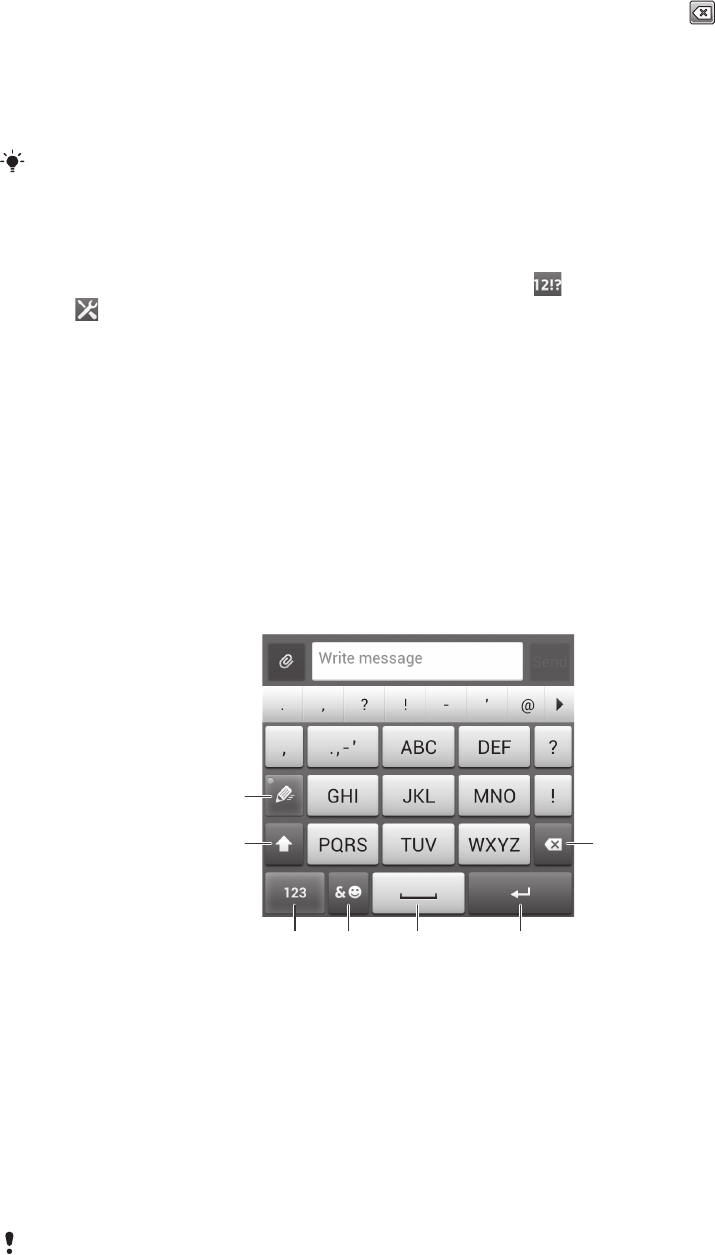
To enter text using the Gesture input function
1When you enter text using the on-screen keyboard, slide your finger from letter
to letter to trace the word you want to write. Lift up your finger when you’ve
finished entering a word.
2The phone suggests a word based on the letters you have traced. If necessary,
select the correct word in the candidate bar. To view more options, scroll right
or left in the word candidate bar. If you cannot find the desired word, tap
once to delete the entire word. Then try again to trace the word using the
Gesture input function, or tap each letter to enter the word.
3If the Space between gestures setting is activated, trace the next word that
you want to enter. If not, tap the space bar and then trace the next word you
want to enter.
To enter joined compound words when the Space between gestures setting is activated, you
may need to slide to enter the first part of the word, then tap each letter to enter the rest of
the word.
To change the Gesture input settings
1When you enter text using the on-screen keyboard, tap .
2Tap , then tap Keyboard settings.
3Tap Text input settings.
4Mark or unmark the Gesture input checkbox.
5If you want to automatically add a space between gestures without having to
tap the space bar each time, mark the Space between gestures checkbox.
Phonepad
The Phonepad is similar to a standard 12-key telephone keypad. It gives you
predictive text and multi-tap input options. You can activate the Phonepad text input
method via the keyboard settings. The Phonepad is only available in portrait
orientation.
Using the Phonepad
1
2 7
34 5 6
1Choose a text input option
2 Change the character case and turn on the caps lock
3 Display numbers
4 Display symbols and smileys
5 Enter a space
6 Enter a carriage return or confirm text input
7 Delete a character before the cursor
All illustrations are for illustration purposes only and may not accurately depict the actual
phone.
27
This is an Internet version of this publication. © Print only for private use.

To open the Phonepad for the first time
1Tap a text entry field, then tap .
2Tap , then tap Keyboard settings.
3Tap Keyboard appearance > Keyboard layout.
4Select the Phonepad.
The Phonepad can only be used in portrait mode.
To enter text using the Phonepad
•When appears in the Phonepad, tap each character key only once, even if
the letter you want is not the first letter on the key. Tap the word that appears
or tap to view more word suggestions and select a word from the list.
•When appears in the Phonepad, tap the on-screen key for the character
you want to enter. Keep pressing this key until the desired character is
selected. Then do the same for the next character you want to enter, and so
on.
To enter numbers using the Phonepad
•When the Phonepad is open, tap . A Phonepad with numbers appears.
To insert symbols and smileys using the Phonepad
1When the Phonepad is open, tap . A grid with symbols and smileys
appears.
2Scroll up or down to view more options. Tap a symbol or smiley to select it.
Keyboard and Phonepad settings
You can select settings for the on-screen keyboard and the Phonepad, such as
writing language and automatic correction.
To access the on-screen keyboard and Phonepad settings
1When you enter text using the on-screen keyboard or Phonepad, tap or
.
2Tap , then tap Keyboard settings.
To add a writing language for text input
1When you enter text using the on-screen keyboard or Phonepad, tap or
.
2Tap , then tap Keyboard settings.
3Tap Languages > Writing languages and mark the relevant checkboxes. Tap
OK to confirm.
To switch between languages, tap the input language key, for example, .
Text input settings
When entering text using the on-screen keyboard or the Phonepad, you can access a
text input settings menu that helps you set options for text prediction. For example,
you can decide how you want the phone to present word alternatives and correct
words as you type, or enable the text input application to remember new words you
write.
To change the text input settings
1When you enter text using the on-screen keyboard or the Phonepad, tap or
.
2Tap Keyboard settings > Text input settings and select the relevant settings.
28
This is an Internet version of this publication. © Print only for private use.

Entering text using voice input
When you enter text, you can use the voice input function instead of typing the
words. Just speak the words that you want to enter. Voice input is an experimental
technology from Google™, and is available for a number of languages and regions.
You must have a data connection on a mobile or Wi-Fi® network to use this service. Additional
charges may apply.
To enable voice input
1When you enter text using the on-screen keyboard or the Phonepad, tap or
.
2Tap , then tap Keyboard settings .
3Mark the Google voice typing key checkbox.
4Press to save your settings. A microphone icon appears on your on-
screen keyboard or Phonepad.
To enter text using voice input
1When you enter text, make sure that the voice input function is enabled and
that you have a working data connection.
2When appears on your on-screen keyboard or Phonepad, tap it. When the
input language key, for example, , appears, touch and hold it.
3When appears, speak to enter text or select a dictation language. When
you're finished, tap Done.
4The suggested text appears. Tap the suggested text to make the search result
list appear, then select the words you want.
Customising your phone
Adapt the phone to your needs by adjusting, for example, your personal ringtone,
phone language and your Privacy settings.
Adjusting the volume
You can adjust the ringtone volume for phone calls and notifications as well as for
music and video playback.
To adjust the ring volume with the volume key
•Press the volume key up or down.
To adjust the media playing volume with the volume key
•When playing music or watching video, press the volume key up or down.
Adjusting the sound settings
You can adjust the sound settings in your phone. For example, you can set your
phone to silent mode so that it doesn't ring when you're in a meeting.
To set the phone to silent mode
1From your Home screen, tap .
2Find and tap Settings > Sound.
3Select Silent mode, then select Mute.
You can also tap from the Phone options menu to set the phone to silent mode. To
access the Phone options menu, press and hold down the power key .
29
This is an Internet version of this publication. © Print only for private use.

To set the phone to vibrate mode
1From your Home screen, tap .
2Find and tap Settings > Sound.
3Select Silent mode, then select Vibrate.
You can also tap from the Phone options menu to set the phone to vibrate mode. To
access the Phone options menu, press and hold down the power key .
To set the phone to vibrate and ring mode
1From your Home screen, tap .
2Find and tap Settings > Sound.
3Select Silent mode, then select Off.
4Mark the Vibrate on ring checkbox.
To enhance the speaker loudness
1From your Home screen, tap .
2Find and tap Settings > Sound.
3Mark the xLOUD™ checkbox.
Time and date
You can change the time and date in your phone.
To set the date manually
1From the Home screen, tap .
2Find and tap Settings > Date & time.
3Unmark the Automatic date & time checkbox, if it is marked.
4Tap Set date.
5Adjust the date by scrolling up and down.
6Tap Set.
To set the time manually
1From your Home screen, tap .
2Find and tap Settings > Date & time.
3Unmark the Automatic date & time checkbox if it is marked.
4Tap Set time.
5Scroll up or down to adjust the hour and minute.
6If applicable, scroll up to change am to pm, or vice versa.
7Tap Set.
To set the time zone
1From your Home screen, tap .
2Find and tap Settings > Date & time.
3Unmark the Automatic time zone checkbox, if it is marked.
4Tap Select time zone.
5Select an option.
To set the date format
1From your Home screen, tap .
2Find and tap Settings > Date & time > Select date format.
3Select an option.
Ringtone settings
To set a phone ringtone
1From your Home screen, tap .
2Find and tap Settings > Sound > Phone ringtone.
3Select a ringtone.
4Tap Done.
30
This is an Internet version of this publication. © Print only for private use.

To enable touch tones
1From your Home screen, tap .
2Find and tap Settings > Sound.
3Mark the Dial pad touch tones and Touch sounds checkboxes.
To select a notification ringtone
1From your Home screen, tap .
2Find and tap Settings > Sound > Default notification.
3Select a ringtone.
4Tap Done.
Screen settings
To adjust the screen brightness
1From your Home screen, tap .
2Find and tap Settings > Display > Brightness.
3Drag the slider to adjust the brightness.
4Tap OK.
The brightness level affects your battery performance. For tips on how to improve battery
performance, see Improving battery performance on page 14.
To set the screen to vibrate
1From your Home screen, tap .
2Find and tap Settings > Sound.
3Mark the Vibrate on touch checkbox. The screen now vibrates when you tap
soft keys and certain applications.
To adjust the idle time before the screen turns off
1From your Home screen, tap .
2Find and tap Settings > Display > Sleep.
3Select an option.
To turn off the screen quickly, briefly press the power key .
To keep the screen active while the phone is charging
1From the Home screen, tap .
2Find and tap Settings > Developer options.
3Mark the Stay awake checkbox.
Phone language
You can select a language to use in your phone.
To change the phone language
1From the Home screen, tap .
2Find and tap Settings > Language & input > Language.
3Select an option.
4Tap Done.
If you select the wrong language and cannot read the menu texts, find and tap . Then select
the text beside , and select the first entry in the following menu. You can then select the
language you want.
Airplane mode
In Airplane mode, your phone's network and radio transceivers are turned off to
prevent disturbance to sensitive equipment. However, you can still play games, listen
to music, watch videos and other content, as long as all this content is saved on your
31
This is an Internet version of this publication. © Print only for private use.

memory card or internal storage. You can also be notified by alarms, if alarms are
activated.
Turning on Airplane mode reduces battery consumption.
To turn on Airplane mode
1From your Home screen, tap .
2Find and tap Settings > More….
3Mark the Airplane mode checkbox.
You can also select Airplane mode from the Phone options menu. To access the Phone
options menu, press and hold down the power key .
Memory
You can save content to a memory card, to your phone's internal storage and to the
phone memory. Music, video clips and photos are saved to the internal storage or the
memory card while applications, contacts and messages are saved to the phone
memory.
You can move some applications from the phone memory to the internal storage.
To move an application to the phone's internal storage
1From your Home screen, tap .
2Find and tap Settings > Apps.
3Select the application that you want to move to the internal storage.
4Tap Move to internal storage .
It is not possible to move some applications from the phone memory to the internal storage.
Memory card
Your phone is preloaded with a microSD™ memory card, which is used for media
content. This type of card can also be used as a portable memory card with other
compatible devices.
Higher capacity memory cards are available for purchase as optional accessories.
Safely removing the memory card
You can safely remove the memory card from your phone any time when the phone
is turned off. If you want to remove the memory card when your phone is on, you
must first unmount the memory card before you physically remove it from the phone.
This can prevent damaging the memory card or losing data stored on the memory
card.
To unmount the memory card
1From your Home screen, tap .
2Find and tap Settings > Storage > Unmount SD card.
Formatting the memory card
You can format the memory card in your phone, for example, to free up memory. This
means that you erase all data on the card.
All content on the memory card gets erased when you format it. Make sure you make backups
of everything you want to save before formatting the memory card. To back up your content,
you can copy it to your computer. For more information, refer to the chapter Connecting your
phone to a computer on page 115.
32
This is an Internet version of this publication. © Print only for private use.
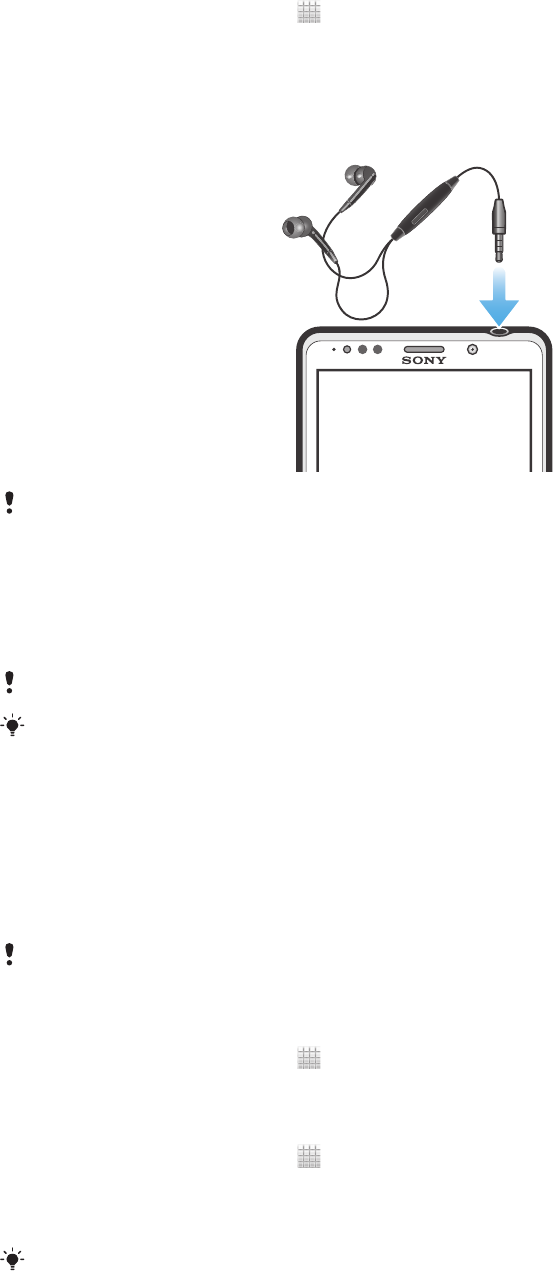
To format the memory card
1From your Home screen, tap .
2Find and tap Settings > Storage > Unmount SD card.
3After you have unmounted the memory card, tap Erase SD card.
Using a headset with your phone
Use the accessories provided with your phone, or other compatible accessories, for optimal
performance.
To use a headset
1Connect the headset to your phone.
2To answer a call, press the call handling key.
3To end the call, press the call handling key.
If a headset is not included with the phone, you may purchase one separately.
If you are listening to music, the music stops when you answer a call and resumes after you
end the call.
Controlling data usage
Keep track of and control the amount of data transferred to and from your phone
during a given period. For example, you can set data usage warnings and limits for
your phone to avoid additional charges. You can also limit the amount of data used
by individual applications.
Adjusting data usage settings can help you keep greater control over data usage but cannot
guarantee the prevention of additional charges.
To access data usage settings
1From your Home screen, tap .
2Find and tap Settings > Data usage.
To turn data traffic on or off
1From your Home screen, tap .
2Find and tap Settings > Data usage.
3To turn data traffic on or off, tap the on-off switch beside Mobile data
accordingly.
You can also turn data traffic on or off by marking or unmarking the Data enabled checkbox
under Settings > More… > Mobile networks.
33
This is an Internet version of this publication. © Print only for private use.

To set a data usage warning
1Make sure that you have turned on data traffic.
2From your Home screen, tap .
3Find and tap Settings > Data usage.
4To set the warning level, drag the lines to the desired values. You receive a
warning notification when the amount of data traffic approaches the level you
set.
To set a data usage limit
1Make sure that you have turned on data traffic.
2From your Home screen, tap .
3Find and tap Settings > Data usage.
4Mark the Set mobile data limit checkbox if it is not marked, then tap OK.
5To set the data usage limit, drag the lines to the desired values.
Once your data usage reaches the set limit, data traffic on your phone will be turned off
automatically.
To control the data usage of individual applications
1From your Home screen, tap .
2Find and tap Settings > Data usage.
3Find and tap the desired application.
4Make the necessary adjustments to change the data usage limit, restrict
background data, or restrict all data traffic for the application.
5To access more specific settings for the application, tap View app settings
and make the desired changes.
Specific settings for an application may not always be accessible.
The performance of individual applications may be affected if you change the related data
usage settings.
34
This is an Internet version of this publication. © Print only for private use.

Calling
Emergency calls
Your phone supports international emergency numbers, for example, 112 or 911. You
can normally use these numbers to make emergency calls in any country, with or
without the SIM card inserted if you are within range of a network.
To make an emergency call
1From your Home screen, tap .
2Find and Tap Phone.
3Enter the emergency number and tap Call. To delete a number, tap .
You can make emergency calls when no SIM card is inserted or when outgoing calls are
barred.
To make an emergency call while the SIM card is locked
1Tap Emergency call.
2Enter the emergency number and tap Call. To delete a number, tap .
Call handling
You can make a call by manually dialling a phone number, by tapping a number
saved in your phone's contact list, or by tapping the phone number in your call log
view. You can also use the smart dial feature to quickly find numbers from your
contact list and call logs.
To make a call by dialling
1From your Home screen, tap .
2Find and tap Phone.
3Enter the number of the recipient and tap Call. To delete a number, tap .
To make a call using smart dial
1From your Home screen, tap .
2Find and tap Phone.
3Use the dialpad to enter letters or numbers that correspond to the contact you
want to call. As you enter each letter or number, a list of possible matches
appears.
4Tap the contact you want to call.
To end a call
•Tap .
To make an international call
1From your Home screen, tap .
2Find and tap Phone.
3Touch and hold 0 until a “+” sign appears.
4Enter the country code, area code (without the first 0) and phone number, then
tap Call.
35
This is an Internet version of this publication. © Print only for private use.
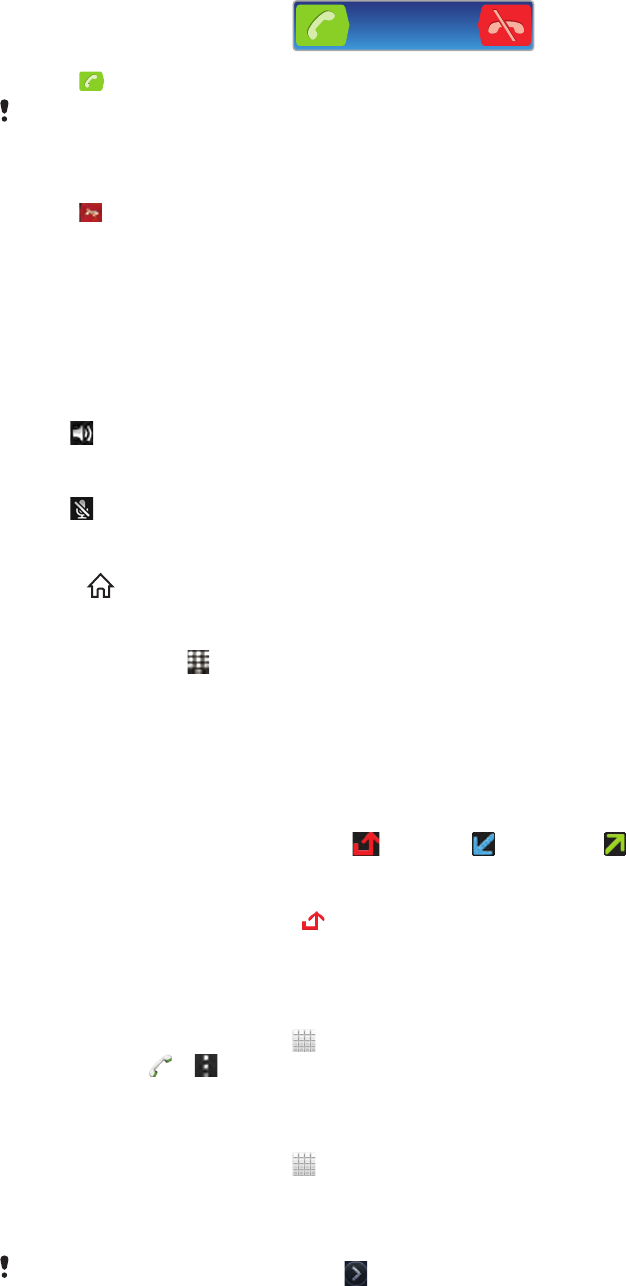
To answer a call
•Drag to the right across the screen.
If you are using regular headphones without a microphone, you have to remove the
headphones from the headset connector to be able to answer the call.
To decline a call
•Drag to the left across the screen.
To reject a second call
•When you hear repeated beeps during a call, tap Busy.
To change the ear speaker volume during a call
•Press the volume key up or down.
To turn on the loudspeaker during a call
•Tap .
To mute the microphone during a call
•Tap .
To activate the screen during a call
•Press .
To enter numbers during a call
1During a call, tap . A keypad appears.
2Enter numbers.
To mute the ringtone for an incoming call
•When you receive the call, press the volume key.
Recent calls
In the call log, you can view missed , received and dialled calls.
To view your missed calls
1When you have missed a call, appears in the status bar. Drag the status bar
downwards.
2Tap Missed call.
To show the call log
1From your Home screen, tap .
2Find and tap > .
3Tap Show call log.
To call a number from your call log
1From your Home screen, tap .
2Find and tap Phone.The call log view appears on the upper part of the screen.
3To call a number directly, tap the number. To edit a number before calling,
touch and hold the number, then tap Edit number before call.
You can also call a number by tapping > Call back.
36
This is an Internet version of this publication. © Print only for private use.

To add a number from the call log to your contacts
1From your Home screen, tap .
2Find and tap Phone.The call log view appears on the upper part of the screen.
3Touch and hold the number, then tap Add to Contacts.
4Tap the desired contact, or tap Create new contact.
5Edit the contact details and tap Done.
Voicemail
If your subscription includes an answering service, callers can leave a voicemail
message when you cannot answer a call. Usually, the voicemail number is saved on
the SIM card. If not, contact AT&T to get your voicemail number. You can then enter
the number manually.
To enter your voicemail number
1From the Home screen, tap .
2Find and tap Settings > Call settings > Voicemail settings > Voicemail
number.
3Enter your voicemail number.
4Tap OK.
To call your voicemail service
1From your Home screen, tap .
2Find and tap Phone.
3Touch and hold 1.
Multiple calls
If you have activated call waiting, you can handle multiple calls at the same time.
When it is activated, you will be notified by a beep if you receive another call.
To activate or deactivate call waiting
1From the Home screen, tap .
2Find and tap Settings > Call settings > Additional settings.
3To activate or deactivate call waiting, tap Call waiting.
To answer a second call and put the ongoing call on hold
•When you hear repeated beeps during a call, tap Answer.
To make a second call
1During an ongoing call, tap .
2Enter the number of the recipient and tap .
3If the recipient answers, the first call is put on hold.
The same procedure applies to subsequent calls.
To switch between multiple calls
•To switch to another call and put the current call on hold, tap the desired
number or contact.
To end the ongoing call and return to the next call on hold
•Tap .
Conference calls
With a conference or multiparty call, you can have a joint conversation with two or
more persons.
37
This is an Internet version of this publication. © Print only for private use.

To make a conference call
1During an ongoing call, tap .
2Dial the number of your second participant and tap .
3If the second participant answers, the first call is put on hold.
4Tap .
To add more participants, repeat steps 1 to 4.
To have a private conversation with a conference call participant
1During an ongoing conference call, tap the button showing the number of
participants. For example, tap 3 participants if there are three participants on
the call.
2Tap the name of the participant you want to talk to privately.
3To end the private conversation and return to the conference call, tap .
To release a participant from a conference call
1During an ongoing conference call, tap the button showing the number of
participants. For example, tap 3 participants if there are three participants.
2Tap next to the participant you want to release.
To end a conference call
•During the call, tap .
Call settings
Barring calls
You can bar all or certain categories of incoming and outgoing calls. When you use
call barring for the first time, you need to enter your PUK (Personal Unblocking Key)
and then a new password to activate the call barring function.
To bar incoming or outgoing calls
1From your Home screen, tap .
2Find and tap Settings > Call settings > Call barring.
3Select an option.
4Enter the password and tap Enable.
Rejecting a call with a message
You can reject a call with a predefined message. When you reject a call with such a
message, the message is automatically sent to the caller and saved on your phone.
Six messages are predefined in the phone. You can select from these predefined
messages, which can also be edited if necessary.
To reject a call with a predefined message
•Drag Reject with message upward, then select a message.
To reject a second call with a predefined message
•When you hear repeated beeps during a call, drag Reject with message
upward, then select a message.
To edit the message used to reject a call
1From your Home screen, tap .
2Find and tap Settings > Call settings > Reject call with message.
3Tap the message you want to edit, then make the necessary changes.
4When you're done, tap OK.
38
This is an Internet version of this publication. © Print only for private use.

Forwarding calls
You can forward calls, for example, to another phone number, or to an answering
service.
To forward calls
1From your Home screen, tap .
2Find and tap Settings > Call settings > Call forwarding.
3Select an option.
4Enter the number you want to forward the calls to, then tap Enable.
To turn off call forwarding
1From your Home screen, tap .
2Find and tap Settings > Call settings > Call forwarding.
3Select an option, then tap Disable.
Showing or hiding your phone number
You can select to show or hide your phone number on call recipients' devices when
you call them.
To show or hide your phone number
1From your Home screen, tap .
2Find and tap Settings > Call settings > Additional settings > Caller ID.
Fixed Dialling Numbers
If you have received a PIN2 code from AT&T, you can use a list of Fixed Dialling
Numbers (FDN) to restrict outgoing calls.
To enable or disable fixed dialling
1From your Home screen, tap .
2Find and tap Settings > Call settings > Fixed dialling numbers.
3Tap Activate fixed dialling or Deactivate fixed dialling.
4Enter your PIN2 and tap OK.
To access the list of accepted call recipients
1From your Home screen, tap .
2Find and tap Settings > Call settings > Fixed dialling numbers > Fixed
dialling numbers.
39
This is an Internet version of this publication. © Print only for private use.
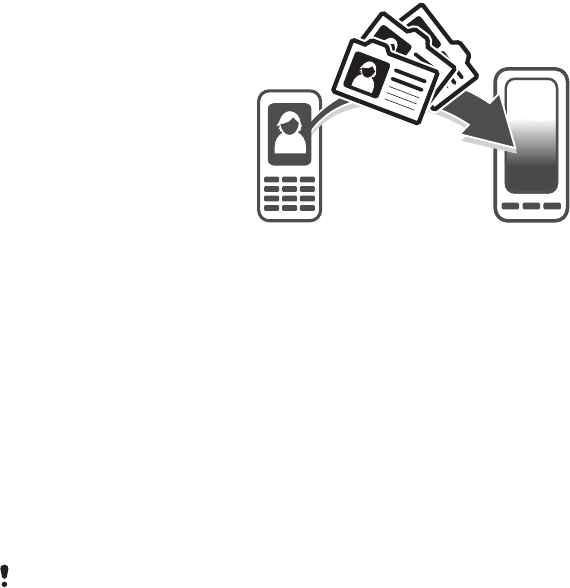
Contacts
Use the Contacts application to store and manage all your numbers, email
addresses, and other contact data in one place. Just tap on a contact to see all
communications with that contact in one easy overview.
You can add new contacts in your phone and synchronise them with contacts saved
in your Google™ account, AT&T Address book, Microsoft® Exchange ActiveSync®
account, or other accounts that support synchronisation. The Contacts application
automatically creates new entries and also helps you match data such as email
addresses with existing entries. You can also manage this process manually.
Transferring contacts to your new phone
There are several ways to transfer contacts to your new phone. Select a transfer
method that best suits your situation.
Transferring contacts using a PC
You can use a PC to transfer contacts from several phone brands, including iPhone,
Samsung, HTC and Nokia.
You need:
•An Internet-connected PC running Windows®
•A USB cable for your old phone
•A USB cable for your new Android™ phone
•Your old phone
•Your new Android™ phone
If you don't have access to all of the items listed above, go to www.sonymobile.com to find
out about other ways to transfer your contacts.
Using the PC Companion program to transfer contacts
If you are transferring contacts using a PC, use the PC Companion progam. It's free,
and the installation files are already saved on your new phone. PC Companion also
offers a range of other features, including help to update your phone software.
To install PC Companion
1New phone: Turn on your new Android™ phone and connect it to a PC using a
USB cable.
2New phone: Tap Install to install PC Companion on the PC.
3Computer: If a popup window appears, select Run Startme.exe. In the new
popup window that appears, click Install to start the installation and then follow
the instructions to complete the installation.
To transfer contacts to your new phone using PC Companion
1Make sure that PC Companion is installed on your PC.
2Open the PC Companion program on the PC, then click Contacts Setup and
follow the instructions to transfer your contacts.
40
This is an Internet version of this publication. © Print only for private use.

Transferring contacts using an Apple® Mac® computer
For detailed instructions on how to use an Apple Mac computer to transfer contacts
from your old phone, go to www.sonymobile.com.
Transferring contacts using synchronisation accounts
Your phone works with popular online synchronisation accounts such as Google
Sync™, Microsoft® Exchange ActiveSync®or Facebook™. If you have synced the
contacts in your old phone or your computer with an online account, you can transfer
your contacts to your new phone using that account. For more detailed information
about synchronisation, see Synchronising data on your phone on page 65.
To synchronise your phone contacts with a synchronisation account
1From your Home screen, tap , then tap .
2Press , then tap Settings > Accounts & sync.
3To set up a synchronisation account, tap Add account and follow the on-
screen instructions. If you have already set up a synchronisation account and
you want to sync with that account, tap the account, press , and tap Sync
now.
Transferring contacts from a SIM card
To import contacts from a SIM card
1From your Home screen, tap , then tap .
2Press , then tap Import contacts > SIM card.
3If you have set up a synchronisation account, you can choose to add the SIM
card contacts under that account. Or you can choose to only use these
contacts in the phone. Select your desired option.
4To import an individual contact, find and tap the contact. To import all
contacts, tap Import all.
Transferring contacts from a memory card
To import contacts from a memory card
1From your Home screen, tap , then tap .
2Press , then tap Import contacts > SD card.
3If you have set up a synchronisation account, you can add the imported
memory card contacts under that account. Or you can choose to only use the
imported contacts in the phone. Select your desired option.
4If you have more than one vCard file on the SD card, a list appears showing
different batches of phone contacts, with the corresponding dates for when
they were created. Select the batch you want to import.
Receiving contacts from other devices
To receive contact data sent using Bluetooth™ technology
1Make sure you have the Bluetooth™ function turned on and your phone set to
visible. If not, then you cannot receive data from other devices.
2When you are asked to confirm whether you want to receive the file, tap
Accept.
3Drag down the Notification panel and tap the file you received to import the
contact data.
To receive contacts sent using a messaging service
41
This is an Internet version of this publication. © Print only for private use.
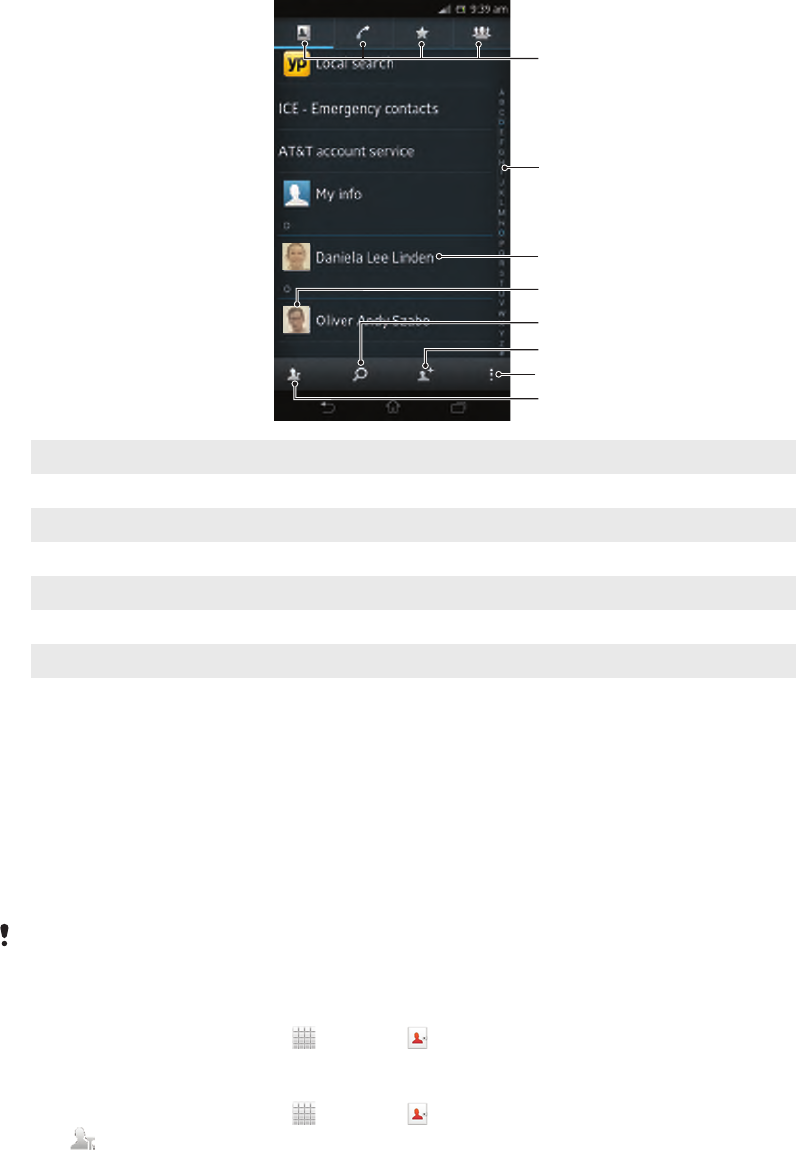
1When you receive a new text message, multimedia message, or email
message, open the message.
2The received contact data appears as a vCard attachment. Tap, or touch and
hold the vCard file to open a menu so you can save the contact data.
Contacts screen overview
3
2
5
6
7
8
1
4
1 Shortcut tabs
2 Alphabetical index for browsing contacts
3 Tap a contact to view its details
4 Tap a contact thumbnail to access the quick contact menu
5 Search for contacts
6 Create a contact
7 Open more options
8 Filter contacts
Managing your contacts
You can create, edit and synchronise your contacts in a few simple steps. You can
select contacts saved in different accounts and manage how you display them in the
phone.
If you synchronise your contacts with more than one account, you can join contacts
in your phone to avoid duplicates.
Some synchronisation services, for example, some social networking services, do not allow
you to edit contact details.
To view your contacts
•From your Home screen, tap , then tap . Your contacts are listed here.
To select which contacts to display in the Contacts application
1From your Home screen, tap , then tap .
2Tap .
3In the list that appears, mark and unmark the desired options. If you have
synchronised your contacts with a synchronisation account, that account
appears in the list. To further expand the list of options, tap the account.
4When you are finished, tap OK.
42
This is an Internet version of this publication. © Print only for private use.

To add a contact
1From your Home screen, tap , then tap .
2Tap .
3If you have synchronised your contacts with one or more accounts, select the
account to which you want to add this contact, or tap Phone contact if you
only want to use this contact in your phone.
4Enter or select the desired information for the contact.
5When you are finished, tap Done.
If you add a plus sign and the country code before a contact phone number, you can use the
number when you make calls from other countries.
To edit a contact
1From the Home screen, tap , then tap .
2Touch and hold the contact you want to edit, then tap Edit contact.
3Edit the desired information. When you are finished, tap Done.
To associate a picture with a contact
1From your Home screen, tap , then tap .
2Touch and hold the contact you want to edit, then tap Edit contact.
3Tap and select the desired method for adding the contact picture.
4When you have added the picture, tap Done.
You can also add a picture to a contact directly from the Album application.
To view your communication with a contact
1From the Home screen, tap , then tap .
2Tap the contact you want to view.
3To view your communication with the contact for different media, tap or flick
through the filter items at the bottom of the screen.
To delete contacts
1From your Home screen, tap , then tap .
2Press , then tap Delete contacts.
3Mark the contacts you want to delete, or tap Mark all if you want to delete all
contacts.
4Tap Delete > OK.
To edit contact information about yourself
1From your Home screen, tap , then tap .
2Touch and hold Myself at the top of the contact list, then tap Edit contact.
3Enter the new information or make the changes you want.
4When you are done, tap Done.
Avoiding duplicate entries in the Contacts application
If you synchronise your contacts with a new account or import contact information in
other ways, you could end up with duplicate entries in the Contacts application. If this
happens, you can join such duplicates to create a single entry. And if you join entries
by mistake, you can separate them again later.
To link contacts
1From your Home screen, tap , then tap .
2Touch and hold the contact you want to link with another contact, then tap
Link contact.
3From the list that appears, tap the contact whose information you want to join
with the first contact, then tap OK to confirm. The information from the first
contact is merged with the second contact, and the first contact is no longer
displayed in the Contacts list.
43
This is an Internet version of this publication. © Print only for private use.

To separate linked contacts
1From your Home screen, tap , then tap .
2Touch and hold the linked contact you want to edit, then tap Edit contact.
3Tap Unlink contact.
4Tap OK.
Favourites
You can mark contacts as favourites so that you can get quick access to them from
the Contacts application.
To mark or unmark a contact as a favourite
1From the Home screen, tap , then tap .
2Tap the contact you want to add to or remove from your favourites.
3Tap .
To view your favourite contacts
1From your Home screen, tap , then tap .
2Tap .
Groups
You can assign contacts to groups to get quicker access to them from within the
Contacts application.
To assign a contact to a group
1In the Contacts application, touch and hold the contact that you want to assign
to a group.
2Tap Edit contact, then tap the bar directly under Assign to group.
3Mark the checkboxes for the groups to which you want to add the contact,
then tap Done.
4Tap Done.
Communicating with your contacts
To search for a contact
1From your Home screen, tap , then tap .
2Tap and enter the first few letters of the contact name in the Search field.
All contacts beginning with those letters appear.
The quick contact menu
Tap a contact's thumbnail to view quick communication options for a particular
contact. Options include calling the contact, sending a text or multimedia message,
and starting a chat using the Google Talk™ application.
For an application to appear as an option in the quick contact menu, you may need to set up
the application in your phone and be logged in to the application. For example, you need to
start the Gmail™ application and enter your login details before you can use Gmail™ from the
quick contact menu.
Sharing your contacts
To send your business card
1From your Home screen, tap , then tap .
2Tap My info.
3Press , then tap Send contact > OK.
4Select an available transfer method and follow the on-screen instructions.
44
This is an Internet version of this publication. © Print only for private use.

To send a contact
1From your Home screen, tap , then tap .
2Tap the contact whose details you want to send.
3Press , then tap Send contact > OK.
4Select an available transfer method and follow the on-screen instructions.
To send several contacts at once
1From your Home screen, tap , then tap .
2Press , then tap Send contacts.
3Mark the contacts you want to send, or select all if you want to send all
contacts.
4Tap Send, then tap OK to confirm.
5Select an available transfer method and follow the on-screen instructions.
Backing up contacts
You can use a memory card, a SIM card or an online synchronisation tool such as
Microsoft® Exchange ActiveSync® to back up contacts.
To export all contacts to a memory card
1From your Home screen, tap , then tap .
2Press , then tap Back up contacts > SD card.
3Tap OK.
To export contacts to a SIM card
1From your Home screen, tap , then tap .
2Press , then tap Back up contacts > SIM card.
3Mark the contacts you want to export, or tap Mark all if you want to export all
your contacts.
4Tap Back up.
5Select Add contacts if you want to add the contacts to existing contacts on
your SIM card, or select Replace all contacts if you want to replace the
existing contacts on your SIM card.
When you export contacts to a SIM card, not all information may get exported. This is due to
memory limitations on SIM cards.
45
This is an Internet version of this publication. © Print only for private use.

Messaging
Using text and multimedia messaging
You can send and receive text messages from your phone using SMS (Short
Message Service). If your subscription includes MMS (Multimedia Messaging
Service), you can also send and receive messages that contain media files, for
example, pictures and videos. The number of characters you can send in a single text
message varies depending on the operator and the language you use. If you exceed
the character limit, then all your single messages are linked together and sent as one
message. You are charged for each single text message you send. When you view
your messages, they appear as conversations, which means that all messages to and
from a particular person are grouped together.
To create and send a message
1From your Home screen, tap , then find and tap .
2Tap .
3Tap , then select the desired recipients from the Contacts list. If the recipient
is not listed as a contact, enter the contact's number manually and tap .
4When you are finished adding recipients, tap Done.
5Tap Write message and enter your message text.
6If you want to add a media file, tap and select an option.
7To send the message, tap Send.
If you exit a message before sending, you are prompted with options to save the message as
a draft, discard the message, or cancel the exit.
To read a received message
1From your Home screen, tap , then find and tap .
2Tap the desired conversation.
3If the message is not yet downloaded, tap and hold the message, then tap
Download message.
You can also open messages from the status bar when appears there. Just drag down the
bar and tap the message.
To reply to a message
1From your Home screen, tap , then find and tap .
2Tap the conversation containing the message.
3Enter your reply and tap Send.
To forward a message
1From your Home screen, tap , then find and tap .
2Tap the conversation containing the message you want to forward.
3Touch and hold the message you want to forward, then tap Forward message.
4Tap , then select a recipient from the Contacts list. If the recipient is not
listed as a contact, enter the contact's number manually and tap .
5When you are finished adding recipients, tap Done.
6Edit the message, if necessary, and tap Send.
In step 4, you can also tap To and enter the recipient's phone number manually.
To delete a message
1From your Home screen, tap , then find and tap .
2Tap the conversation containing the message you want to delete.
3Touch and hold the message you want to delete, then tap Delete message >
Delete.
46
This is an Internet version of this publication. © Print only for private use.

To delete conversations
1From your Home screen, tap , then find and tap .
2Tap , then tap Delete several.
3Mark the checkboxes for the conversations you want to delete, then tap
Delete.
To save a sender's number
1From your Home screen, tap , then find and tap .
2Tap > Save.
3Select an existing contact, or tap Create new contact and select Phone
contact or SIM contact.
4Edit the contact information and tap Done.
To call a message sender
1From your Home screen, tap , then find and tap .
2Tap a conversation.
3Tap the recipient name or number at the top of the screen.
4If the recipient is saved in your contacts, tap the phone number that you want
to call. If you have not saved the recipient in your contacts, tap .
To save a file contained in a message you receive
1From your Home screen, tap , then find and tap .
2Tap the conversation you want to open.
3If the message has not been downloaded yet, tap and hold the message, then
tap Download message.
4Touch and hold the file you want to save, then select the desired option.
To star a message
1From your Home screen, tap , then find and tap .
2Tap the conversation you want to open.
3In the message you want to star, tap .
4To unstar a message, tap .
To view starred messages
1From your Home screen, tap , then find and tap .
2Press , then tap Starred messages.
3All starred messages appear in a list.
To search for messages
1From your Home screen, tap , then find and tap .
2Press , then tap Search.
3Enter your search keywords, then tap Go.
Text and multimedia message options
To change your message notification settings
1From your Home screen, tap , then find and tap .
2Press , then tap Settings.
3To set a notification sound, tap Notification tone and select an option.
4For other notification settings, check or uncheck the relevant checkboxes.
To view messages saved on the SIM card
1From your Home screen, tap , then find and tap .
2Press , then tap Settings > SIM messages.
47
This is an Internet version of this publication. © Print only for private use.

Email
Use the Email application in your phone to send and receive emails through your
regular email account or through your corporate account. Or you can do both. Your
phone can handle several email accounts at the same time. You can set up these
accounts to run through one combined inbox, or through separate inboxes. Note that
emails you receive to your Gmail™ account can be accessed in the phone from both
the Email and the Gmail™ applications.
Your corporate Microsoft® Outlook® email messages have to be stored on a
Microsoft® Exchange server for the functionality described above to work. See Synchronising
your corporate email, calendar and contacts on page 66 for more information.
To set up an email account in your phone
1From your Home screen, tap .
2Find and tap .
3Enter your email address and password, then tap Next.
4If the settings for the email account cannot be downloaded automatically,
complete the setup manually. If necessary, contact your email service provider
for detailed settings. For corporate email setup on your phone, select
Exchange Active Sync as the account type.
5When you are prompted, enter a name for your email account, so that it is
easily identifiable. The same name shows in the emails you send from this
account. When you are finished, tap Next.
You can set up more than one email account. See To add an extra email account in your
phone on page 51.
Using email
To create and send an email message
1From your Home screen, tap , then find and tap Email.
2If you are using several email accounts, tap at the top of the screen and
select the account you want to send the message from, then tap .
3Tap To and start typing the recipient's address. Matches are displayed in a
dynamic list. Tap the relevant match or continue typing the complete email
address. To add more recipients, enter a comma ( , ) or a semicolon ( ; ) and
start typing another name. To delete a recipient, tap .
4To select an email address saved in your contacts, tap , then find and mark
the checkbox next to a recipient field. To add more than one recipient, mark
the checkboxes for the desired recipients. When you are finished, tap Done.
5Tap Subject and enter the email subject.
6To attach a file, tap . Select the type of file, then tap the file you want to
attach from the list that appears.
7In the message area, enter your message text.
8To set a priority level, press , then tap Set priority and select an option.
9To add Cc/Bcc fields, press , then tap Show Cc/Bcc.
10 To send the email, tap .
To receive email messages
1From your Home screen, tap .
2Find and tap Email.
3If you are using several email accounts, tap at the top of the screen and
select the account that you want to check. If you want to check all your email
accounts at once, tap Combined view.
4To download new messages, press , then tap Refresh.
If you have set up a corporate email account, you can set the check frequency to Automatic
(Push).
48
This is an Internet version of this publication. © Print only for private use.

To read your email messages
1From your Home screen, tap .
2Find and tap Email.
3If you are using several email accounts, tap at the top of the screen and
select the account you want to check. If you want to check all your email
accounts at once, tap Combined view.
4In the email inbox, scroll up or down and tap the email you want to read.
To use the email preview pane
1From your Home screen, tap , then find and tap Email.
2If you are using several email accounts, tap and select the account you
want to check. If you want to check all your email accounts at once, tap
Combined view.
3Hold your phone horizontally. The email preview pane appears.
4Scroll up or down in the email inbox and tap the email you want to read. The
email opens in the preview pane. To view more information about the email,
tap the downward arrow next to the sender's name. In the body text field,
pinch two fingers together, or spread them apart, to zoom out or in.
5To view the email in fullscreen format, tap the split bar (located between the
email list and email body) accordingly. In fullscreen format, use the leftward
and rightward arrows to read your previous or next message.
6To return to the inbox view, tap the split bar accordingly.
Before using the preview pane, activate it in the preview pane settings.
To hide the preview pane, hold your phone vertically, or change the preview pane settings.
To change email preview pane settings
1From your Home screen, tap , then find and tap Email.
2Press , then tap Settings.
3Tap General > Preview pane, then select an option.
To view an email message attachment
1From your Home screen, tap .
2Find and tap Email.
3Find and tap the email message containing the attachment you want to view.
Emails with attachments are identified by .
4Find the attachment in the email body, then tap View or Save next to it.
To save a sender's email address to your contacts
1From your Home screen, tap .
2Find and tap Email.
3Find and tap a message in your email inbox.
4Tap the name of the sender.
5Tap OK.
6Select an existing contact, or tap Create new contact and select Phone
contact or SIM contact.
7Edit the contact information, then tap Done.
To reply to an email message
1From your Home screen, tap .
2Find and tap Email.
3In your email inbox, find and tap the message you want to reply to, then tap
.
4Enter your reply, then tap .
49
This is an Internet version of this publication. © Print only for private use.

To forward an email message
1From your Home screen, tap .
2Find and tap Email.
3In your email inbox, find and tap the message you want to forward, then tap
.
4Tap To and enter the recipient's email address manually, or tap to select a
recipient from your contacts.
5Enter your message text, then tap .
To delete an email message
1From your Home screen, tap .
2Find and tap Email.
3In your email inbox, find and tap the message you want to delete, then tap .
4Tap Yes.
To sort your emails
1From your Home screen, tap .
2Find and tap Email.
3If you are using several email accounts, tap at the top of the screen and
select the account that you want to check. If you want to check all your email
accounts at once, tap Combined view.
4Press , then tap Sort.
5Select a sorting option.
To search for emails
1From your Home screen, tap . Then find and tap Email.
2If you are using several email accounts and want to check just one account,
tap at the top of the screen and select the account name. Press , then
tap Search.
3Enter your search text, then tap Go on your keyboard.
4The search result appears in a list sorted by date. Tap the email you want to
open.
To change search options, tap and select a different option.
To manage your email in batches
1From your Home screen, tap , then find and tap Email.
2If you are using several email accounts, tap at the top of the screen and
select the account that you want to check. If you want to check all your email
accounts at once, tap Combined view.
3Mark the checkboxes for the emails that you want to select.
4When you are finished, tap one of the buttons at the bottom of the screen to,
for example, mark the selected emails as read or unread, or delete the selected
emails.
To view all folders for one email account
1From your Home screen, tap . Then find and tap Email.
2Tap at the top of the screen and select the account you want to check, then
tap again and select Show all folders to view all the folders in this account.
To change the inbox check frequency
1From your Home screen, tap .
2Find and tap Email.
3Press , then tap Settings.
4Select the account for which you want to change the inbox check frequency.
5Tap Inbox check frequency and select an option.
50
This is an Internet version of this publication. © Print only for private use.

To set an Out of Office auto-reply in an Exchange Active Sync account
1From your Home screen, tap , then find and tap Email.
2Press , then tap Settings.
3Select the EAS (Exchange Active Sync) account for which you want to set an
Out of Office auto-reply.
4Tap Out of office.
5Tap beside Out of office so that changes to .
6If needed, mark the Set time range checkbox and set the time range for the
auto reply.
7Enter your Out of Office message in the body text field.
8Tap OK to confirm.
Using email accounts
To add an extra email account in your phone
1From your Home screen, tap .
2Find and tap Email.
3Tap at the top of the screen, then tap Add account.
4Enter the email address and password, then tap Next. If the settings for the
email account cannot be downloaded automatically, complete the setup
manually.
5When prompted, enter a name for your email account so that it is easily
identifiable. The same name shows in the emails you send from this account.
6When you are finished, tap Next.
To set an email account as your default account
1From your Home screen, tap .
2Find and tap Email.
3Press , then tap Settings.
4Select the account you want to use as the default account for composing and
sending emails.
5Mark the Default account checkbox. The inbox of the default account appears
every time you open the email application.
If you only have one email account, this account is automatically the default account.
To remove an email account from your phone
1From your Home screen, tap .
2Find and tap Email.
3Press , then tap Settings.
4Select the account you want to remove.
5Tap Delete account > OK.
Gmail™ and other Google™ services
If you have a Google™ account, you can use the Gmail™ application in your phone
to read, write and organise email messages. After you set up your Google™ account
to work in the phone, you can also chat to friends using the Google Talk™
application, synchronise your phone calendar application with your Google
Calendar™, and download applications and games from Google Play™.
The services and features described in this chapter may not be supported in all countries or
regions, or by all networks and/or service providers in all areas.
51
This is an Internet version of this publication. © Print only for private use.

To set up a Google™ account in your phone
1From your Home screen, tap .
2Find and tap Settings > Accounts & sync > Add account > Google.
3Follow the registration wizard to create a Google™ account, or sign in if you
already have an account. Your phone is now ready to use with Gmail™ ,
Google Talk™ and Google Calendar™.
You can also sign in or create a Google™ account from the setup guide the first time you start
your phone. Or you can go online and create an account at www.google.com/accounts.
To open the Gmail™ application
1From the Home screen, tap .
2Find and tap Gmail .
52
This is an Internet version of this publication. © Print only for private use.

Google Talk™
You can use Google Talk™ instant messaging in your phone to chat with friends who
also use this application.
To start Google Talk™
1From your Home screen, tap .
2Find and tap Talk.
To reply to an instant message with Talk
1When someone contacts you on Talk, appears in the status bar.
2Drag the status bar downwards, then tap the message and begin to chat.
53
This is an Internet version of this publication. © Print only for private use.

Explore by Touch
Use the Explore by Touch function to navigate the phone without having to look at
the screen. When the Explore by Touch function is turned on, an automated voice
tells you what your finger is touching on the screen. This function is primarily
designed to help blind or visually impaired users to use the phone.
Before using Explore by Touch
Before you can turn on the Explore by Touch function, you must first turn on the
TalkBack service.
To turn on the TalkBack service
1From your Home screen, tap .
2Find and tap Settings > Accessibility > TalkBack.
3Drag the slider to the right.
To turn on the Explore by Touch function
1Make sure that the TalkBack service is turned on.
2From your Home screen, tap .
3Find and tap Settings > Accessibility > Explore by Touch.
4Drag the slider to the right.
If the TalkBack service is not turned on, the Explore by touch function is not available.
To navigate your phone using the Explore by Touch function
1Explore your screen using one finger. Tap once to hear what your finger is
touching on the screen.
2Tap twice to open an application, menu, or other option.
3To change screens and scroll within lists, drag or flick two fingers in the
direction you want to scroll on the screen.
This function changes the way your screen responds to touch. Before using it, tap Tutorial to
get more information.
54
This is an Internet version of this publication. © Print only for private use.
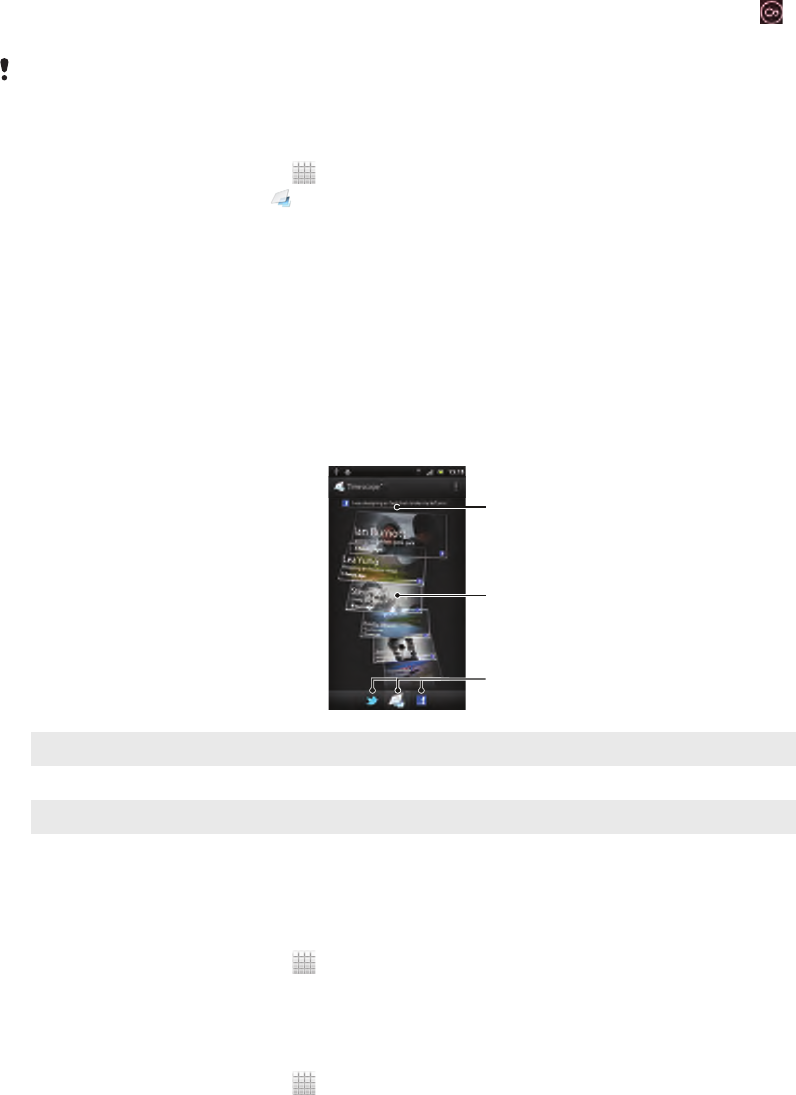
Timescape™
Timescape™ collects all your communications into one integrated view. Events such
as Facebook™ or Twitter™ updates appear as tiles in a chronological flow on the
screen. Browse the files to get a snack-size preview of events before choosing to
open them and view the full content. Timescape™ also features an infinite button
that gives you access to a range of content about the item you are currently viewing.
The services and features described in this chapter may not be supported in all countries or
regions, or by all networks and/or service providers in all areas.
To start Timescape™
1From your Home screen, tap .
2Find and tap Timescape™ .
3If you are starting Timescape™ for the first time, tap the tile in the welcome
screen to set up Timescape.
4Tap the Services screen to log in to social networking services such as
Facebook™ or Twitter™, or to search for Timescape-related extensions in
Google Play™.
5If you do not want to log in to any social networking accounts or search
Google Play™, tap Done.
Timescape™ main view
2
1
3
1Shows your most recent update to a social networking service
2 Timescape™ tiles displayed in chronological order
3 Timescape™ event filter
Using Timescape™
To scroll through tiles in Timescape™
1From your Home screen, tap .
2Find and tap Timescape™.
3Flick up or down to scroll through the tiles.
To preview a tile in Timescape™
1From your Home screen, tap .
2Find and tap Timescape™.
3Scroll to the tile you want to preview, and then tap it.
55
This is an Internet version of this publication. © Print only for private use.

Timescape™ event filter overview
All events
Updates from your Twitter™ contacts
Updates from your Facebook™ contacts
More events appear in the Timescape™ event filter if you have installed other Timescape
services.
To filter the events displayed in Timescape™
1From your Home screen, tap .
2Find and tap Timescape™.
3Tap or flick through the filter icons.
To refresh the main view in Timescape™
•When the Timescape™ event filter is set to show all events, press , then tap
Refresh.
When you refresh the main view, your phone may connect to the Internet to update
information from web service accounts that you have linked to Timescape™.
To log in to Facebook™ or Twitter™ from Timescape™
1From your Home screen, tap .
2Find and tap Timescape™.
3Press , then tap Settings > Set up services.
4Tap the service you want to log in to.
5Enter your login details.
When you have logged in to a web service, you can update your status or view updates from
the web service in Timescape™.
To update your Facebook™ or Twitter™ status in Timescape™
1From your Home screen, tap .
2Find and tap Timescape™.
3Tap > Update status.
4Tap the service for which you want to update your status. If you are not signed
in to the service, you need to sign in before proceeding. When you have
selected the desired service, tap Continue.
5Tap the text field and enter your new status, then tap Post.
To log out of Facebook™ or Twitter™ from Timescape™
1From your Home screen, tap .
2Find and tap Timescape™.
3Press , then tap Settings > Set up services.
4Tap the service you want to log out of.
Your account information gets deleted when you log out.
Downloading new services for Timescape™
You can perform an extension search in Google Play™ and download new services
for Timescape™. Such services include applications and plug-ins that add extra
features to Timescape. For example, you can download applications that update
Timescape with your activities on various social networking sites.
56
This is an Internet version of this publication. © Print only for private use.

To download and install new services for Timescape™
1From your Home screen, tap .
2Find and tap Timescape™.
3Press , then tap Settings > Set up services > Extension search.
4If you don't have a Google account set up on your phone, follow the on-screen
instructions to add one. Otherwise, you are directed straight to Google Play™.
5In Google Play™, select a service to download from the list that appears, then
follow the instructions to download and install it.
You can delete installed Timescape services the same way you delete any other installed
application.
To view an event in Timescape™
1From the Home screen, tap .
2Find and tap Timescape™.
3Scroll to and tap the tile for the desired event so it appears in preview mode.
Then tap the tile again.
The infinite button in Timescape™
When you tap a tile, the infinite button appears in the upper right corner. If the tile
is connected to a contact, you can access related content by tapping the infinite
button.
To view all communication with a contact in Timescape™
1From your Home screen, tap .
2Find and tap Timescape™.
3Tap a tile for an event related to a contact.
4Tap . All communication with the contact appears.
5Tap or flick the filter items at the bottom of the screen to view communication
with the contact through other media.
Timescape™ settings
To access Timescape™ settings
1From the Home screen, tap .
2Find and tap Timescape™.
3Press , then tap Settings.
To schedule web service content updates in Timescape™
1From your Home screen, tap .
2Find and tap Timescape™.
3Press , then tap Settings > Update mode.
4Tap the desired option. If you select Manual, no automatic updates get
scheduled.
Timescape™ Feed widget
The Timescape™ Feed widget shows all your recent Timescape™ events in one
view. Within the widget area, you can drag down to get the most recent updates or
flick up or down to view the full content of every event. You can also tap an event to
view its content in fullscreen format or react to it using comments, likes and retweets.
57
This is an Internet version of this publication. © Print only for private use.
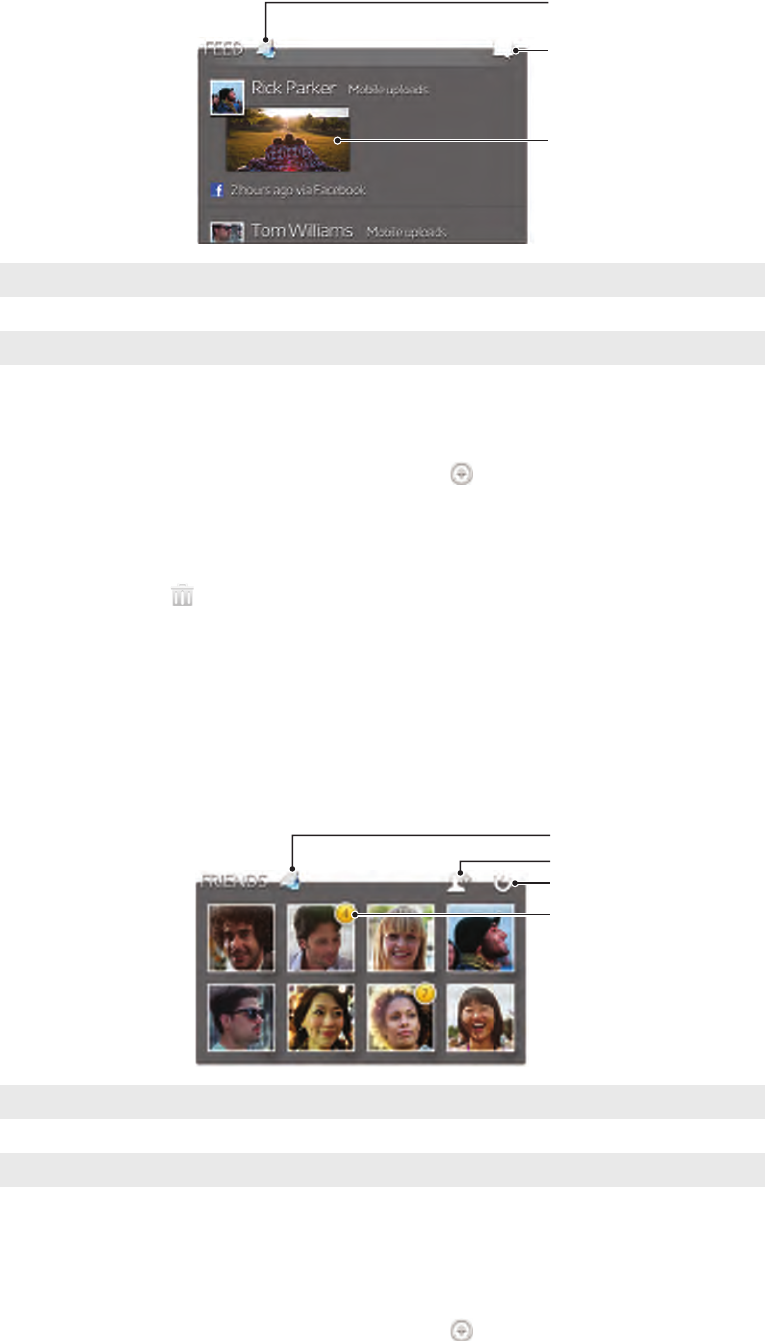
Timescape™ Feed widget view
1
2
3
1 Shortcut to the Timescape™ main view
2 Shortcut to update status
3 Most recent online event
To add the Timescape™ Feed widget to your Home screen
1Make sure that there is enough free space for the new widget on your Home
screen.
2Tap an empty area of your Home screen, then tap .
3Find and tap Timescape™ Feed.
To remove the Timescape™ Feed widget from your Home screen
1From your Home screen, touch and hold the Timescape™ Feed widget.
2Drag the widget to .
Timescape™ Friends widget
The Timescape™ Friends widget notifies you of the latest social networking activities
related to you and your friends. You can view all activities and communicate with
your friends using comments, likes and retweets.
Timescape™ Friends widget view
1
3
4
2
1Shortcut to the Timescape™ main view
2 Select different friends to follow. This icon only appears when all the slots are full.
3 Tap to refresh the view
4 Activity indicator – indicates updates to feeds
To add the Timescape™ Friends widget to your Home screen
1Make sure that there is enough free space for the new widget on your Home
screen.
2Tap an empty area of your Home screen, then tap .
3Find and tap Timescape™ Friends.
58
This is an Internet version of this publication. © Print only for private use.
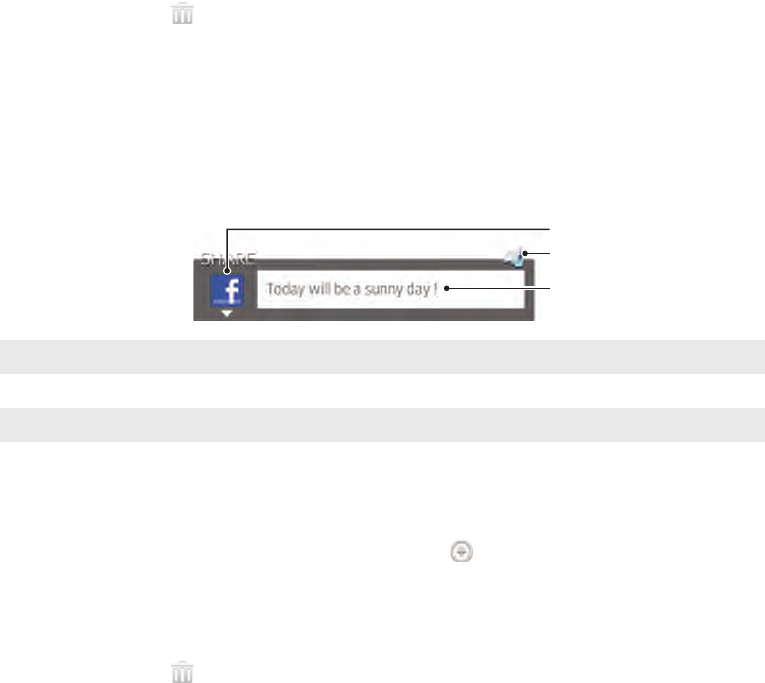
To remove the Timescape™ Friends widget from your Home screen
1From your Home screen, touch and hold the Timescape™ Friends widget.
2Drag the widget to .
Timescape™ Share widget
Share your status through one of the services that you have logged into from your
phone. For example, you can post updates on Facebook™ or Twitter™.
Timescape™ Share widget view
1
2
3
1 Icon showing the service currently used to send posts
2 Shortcut to the Timescape™ main view
3 Enter new posts here
To add the Timescape™ Share widget to your Home screen
1Make sure that there is enough free space for the new widget on your Home
screen.
2Tap an empty area of your Home screen, then tap .
3Find and tap Timescape™ Share.
To remove the Timescape™ Share widget from your Home screen
1From your Home screen, touch and hold the Timescape™ Share widget.
2Drag the widget to .
59
This is an Internet version of this publication. © Print only for private use.

Getting started with Google Play™
Open Google Play™ and enter a world of applications and games. You can browse
these applications and games through different categories. You can also rate an
application or game and send feedback on it.
To use Google Play™, you need to have a Google™ account. See To set up a
Google™ account in your phone on page 52.
Google Play™ may not be available in all countries or regions
To open Google Play™
1From the Home screen, tap .
2Find and tap Play Store.
Downloading from Google Play™
You can download all kinds of applications from Google Play™, including free
applications.
Before you download applications
Before you start downloading from Google Play™, make sure that you have a
working Internet connection.
Also, remember that you might incur data traffic charges when you download content
to your phone. Contact your operator for more information.
To download a free application
1In Google Play™, find an item you wish to download by browsing categories,
or by using the search function.
2Tap the item to view its details, and follow the instructions to complete the
installation.
To download a paid application
1In Google Play™, find an item you wish to download by browsing categories,
or by using the search function.
2Tap the item to view its details, and follow the instructions in your phone to
complete your purchase.
To open a downloaded application
1In Google Play™, press , then tap My Apps.
2Tap the downloaded application.
You can also access downloaded applications from the Application screen.
Clearing your application data
You may sometimes need to clear data for an application. This might happen if, for
example, the application memory becomes full, or you want to clear high scores for a
game. You might also want to erase incoming email, text and multimedia messages
in some applications.
To clear all cache for an application
1From your Home screen, tap .
2Find and tap Settings.
3Tap Apps.
4Tap the application for which you want to clear all cache.
5Tap Clear cache.
It is not possible to clear the cache for some applications.
60
This is an Internet version of this publication. © Print only for private use.

To delete an installed application
1From your Home screen, tap .
2Find and tap Settings.
3Tap Apps.
4Select the application that you want to delete.
5Tap Uninstall.
It is not possible to delete some preinstalled applications.
Permissions
Some applications need to access parts of your phone to be able to work properly.
For example, a navigation application needs permissions to send and receive data
traffic, and access your location. Some applications might misuse their permissions
by stealing or deleting data, or reporting your location. Make sure you only install and
give permissions to applications you trust.
To view permissions of an application
1From your Home screen, tap .
2Find and tap Settings.
3Tap Apps.
4Tap the desired application.
5Scroll down to view the relevant details under Permissions.
Installing applications not from Google Play™
Installing applications of unknown or unreliable origin can damage your phone. By
default, your phone is set to block such installations. However, you can change this
setting and allow installations from unknown sources.
Sony does not warrant or guarantee the performance of any third-party applications or content
transferred via download or other interface to your phone. Similarly, Sony is not responsible for
any damage or reduced performance of your phone attributable to the transfer of third-party
content. Only use content from reliable sources. Contact the content provider if you have any
questions or concerns.
To allow the installation of applications not from Google Play™
1From your Home screen, tap .
2Find and tap Settings > Security.
3Mark the Unknown sources checkbox.
61
This is an Internet version of this publication. © Print only for private use.

Getting organised
Calendar
Your phone has a calendar for managing your time schedule. If you have a Google™
account, you can also synchronise your phone calendar with your web calendar. See
Synchronising data on your phone on page 65.
To set the calendar view
1From your Home screen, tap , then find and tap Calendar.
2Press and select an option.
To view multiple calendars
1From your Home screen, tap , then find and tap Calendar.
2Press , then tap My calendars.
3Select the calendars you want to view.
To create a calendar event
1From your Home screen, tap , then tap Calendar.
2Tap .
3Enter the name, time, location and description for the event.
4If desired, select another option under Repetition.
5Select a reminder for the event. To add a new reminder for the event, tap .
6Tap Save.
When the appointment time approaches, your phone plays a short sound to remind you. Also,
appears in the status bar.
To view a calendar event
1From your Home screen, tap , then tap Calendar.
2Tap the event you want to view.
To change the calendar settings
1From your Home screen, tap , then tap Calendar.
2Press , then tap Settings.
3Tap the setting you want to change, then edit as desired.
Alarm clock
Use your phone as an alarm clock and select any sound in your phone as your alarm
signal. The alarm does not sound if your phone is turned off. But it does sound when
your phone is set to silent mode.
To open the alarm clock
1From your Home screen, tap .
2Find and tap Alarm & clock.
To set a new alarm
1From your Home screen, tap .
2Find and tap Alarm & clock.
3Tap Add alarm.
4Adjust the time by scrolling up and down.
5If desired, edit other alarm settings.
6Tap Done.
62
This is an Internet version of this publication. © Print only for private use.

To edit an existing alarm
1From your Home screen, tap .
2Find and tap Alarm & clock.
3Tap the alarm you want to edit.
4Scroll up or down to adjust the time.
5If desired, edit other alarm settings.
6Tap Done.
The alarm time format displayed is the same as the format you select for your general time
settings, for example, 12-hour or 24-hour.
To deactivate an alarm
1From your Home screen, tap .
2Find and tap Alarm & clock.
3Tap next to the alarm you want to deactivate.
To activate an existing alarm
1From your Home screen, tap .
2Find and tap Alarm & clock.
3Tap next to the alarm you want to activate.
To delete an alarm
1From your Home screen, tap .
2Find and tap Alarm & clock.
3Touch and hold the alarm you want to delete.
4Tap Delete alarm, then tap Yes.
To set the ringtone for an alarm
1From your Home screen, tap .
2Find and tap Alarm & clock.
3Tap the alarm you want to edit.
4Tap Advanced alarm settings and unmark the Style settings checkbox.
5Tap Alarm sound and select an option.
6Tap Done, then tap Done.
To set a recurring alarm
1From your Home screen, tap .
2Find and tap Alarm & clock.
3Tap the alarm you want to edit.
4Tap Repeat.
5Mark the checkboxes for the desired days, then tap OK.
6Tap Done.
To set the title for an alarm
1From your Home screen, tap .
2Find and tap Alarm & clock.
3Tap the alarm you want to edit.
4Tap Advanced alarm settings, then tap the Alarm text field and enter a name
for the alarm.
5Tap Done.
To activate the vibrate function for an alarm
1From your Home screen, tap .
2Find and tap Alarm & clock.
3Tap the alarm you want to edit.
4Tap Advanced alarm settings, then mark the Vibrate checkbox.
5Tap Done.
63
This is an Internet version of this publication. © Print only for private use.

To set alarms to sound when the phone is in silent mode
1From your Home screen, tap .
2Find and tap Alarm & clock, then tap to select an alarm.
3Tap Advanced alarm settings, then mark the Alarm in silent mode checkbox.
4Tap Done.
To snooze an alarm when it sounds
•Tap Snooze - min.
To turn off an alarm when it sounds
•Slide to the right.
64
This is an Internet version of this publication. © Print only for private use.

Synchronising data on your phone
You can sync contacts, email, calendar events, and other information with your
phone from multiple email accounts, synchronisation services and other kinds of
accounts, depending on the applications installed on your phone. Synchronising your
phone with other information sources is an easy and practical way to stay up to date.
You can:
•access your Gmail™ , Google Calendar™, Google™ contacts, Google™ Chrome™
bookmarks and other Google services you use.
•access your corporate email, contacts and calendar applications.
•access your Facebook™ contacts, calendar, albums and other services you use.
Synchronising with Google™
Synchronise your phone with different Google™ services to keep your information up
to date, regardless of which device you're using your Google™ account from. For
example, you can synchronise your contacts, Gmail™, calendar and web browser
data.
To set up a Google™ account in your phone for automatic synchronisation
1From your Home screen, tap .
2Tap Settings > Accounts & sync.
3Make sure that synchronisation is turned on so that applications can
synchronise data automatically.
4Tap Add account > Google.
5Follow the registration wizard to create a Google™ account, or sign in if you
already have an account.
6Tap Next.
7Tap your newly created Google™ account, then tap the items you want to
synchronise.
To synchronise manually with your Google™ account
1From the Home screen, tap .
2Tap Settings > Accounts & sync.
3Tap the Google™ account you want to synchronise.
4Press , then tap Sync now.
To synchronise an application with a Google™ account
1From your Home screen, tap .
2Tap Settings > Accounts & sync.
3Tap the Google™ account that you want to synchronise with. A list appears of
applications that can be synchronised with the Google account.
4Tap the application that you want to synchronise with the selected Google
account.
To synchronise the web browser data with Google™ Chrome™
1From your Home screen, tap .
2Tap Settings > Accounts & sync.
3Tap the Google™ account that you want to synchronise with, then tap Sync
Browser.
To remove a Google™ account from your phone
1From your Home screen, tap .
2Tap Settings > Accounts & sync.
3Tap the Google™ account you want to remove from the accounts list.
4Press , then tap Remove account.
5Tap Remove account again to confirm.
65
This is an Internet version of this publication. © Print only for private use.

Synchronising your corporate email, calendar and contacts
Access your corporate email messages, calendar appointments and contacts directly
from your phone. View and manage them just as easily as you would from a
computer. After setup, you can find your information in the Email, Calendar and
Contacts applications.
For you to access the functionality described above, your corporate information must be
stored on a Microsoft® Exchange server.
To set up corporate email, calendar and contacts in your phone
1From your Home screen, tap .
2Tap Settings > Accounts & sync.
3Make sure that synchronisation is turned on so that your data synchronises
automatically according to the sync interval you set.
4Tap Add account > Corporate.
5Enter your corporate email address and password.
6Tap Next. Your phone begins to retrieve your account information. If a failure
occurs, contact your corporate network administrator for more information
such as the domain name and Exchange server address.
7Tap OK to allow your corporate server to control your phone.
8Select what data you want to sync with the phone, such as contacts and
calendar entries.
9If desired, activate the device administrator to allow your corporate server to
control certain security features in your phone. For example, allow your
corporate server to set password rules and set storage encryption.
10 When the setup is done, you can enter a name for the corporate account so
that it can be easily identified.
To edit the setup of corporate email, calendar and contacts
1From your Home screen, tap .
2Tap Settings > Accounts & sync and select your corporate account.
3Tap Account settings, then tap the corporate account that you want to edit.
4Change the desired settings.
To set a synchronisation interval for a corporate account
1From your Home screen, tap .
2Tap Settings > Accounts & sync and select your corporate account.
3Tap Account settings, then tap the corporate account for which you want to
set a synchronisation level.
4Tap Inbox check frequency and select an interval option.
To remove a corporate account from your phone
1From your Home screen, tap .
2Tap Settings > Accounts & sync, then tap your corporate account.
3Press , then tap Remove account.
4Tap Remove account again to confirm.
Synchronising with Facebook™
There are two ways to use Facebook™ on your phone. You can use the standard
Facebook application to access your online Facebook account, or you can
synchronise your Facebook account with your phone and get direct access to
Facebook content from a range of other applications. For example, you can make
Facebook posts from Timescape™ and access your Facebook contacts, photos and
calendar entries from related applications in the phone, such as the Calendar
application. To synchronise your phone with Facebook, you must first set up a
Facebook integration account -- a solution developed by Sony to enable easy
integration.
66
This is an Internet version of this publication. © Print only for private use.

To set up a Facebook™ integration account on your phone
1From your Home screen, tap .
2Tap Settings > Accounts & sync.
3Make sure that synchronisation is turned on so that applications can
synchronise data automatically.
4Tap Add account > Sony™ Facebook integration.
5Follow the on-screen instructions to create a Facebook™ integration account,
or sign in if you already have an account.
You can also set up a Facebook™ integration account on your phone by marking the
Facebook integration checkbox under Settings > Xperia™ > Sony™ Facebook integration.
To synchronise manually with your Facebook™ integration account
1From your Home screen, tap .
2Tap Settings > Accounts & sync.
3Tap the Sony™ Facebook integration account.
4Press , then tap Sync now.
To remove a Facebook™ integration account from your phone
When you remove a Facebook™ integration account from your phone, the associated online
Facebook account is not deleted and you can still access it from a computer.
1From your Home screen, tap .
2Tap Settings > Accounts & sync.
3Tap the Sony™ Facebook integration account.
4Press , then tap Remove account.
5Tap Remove account again to confirm.
67
This is an Internet version of this publication. © Print only for private use.
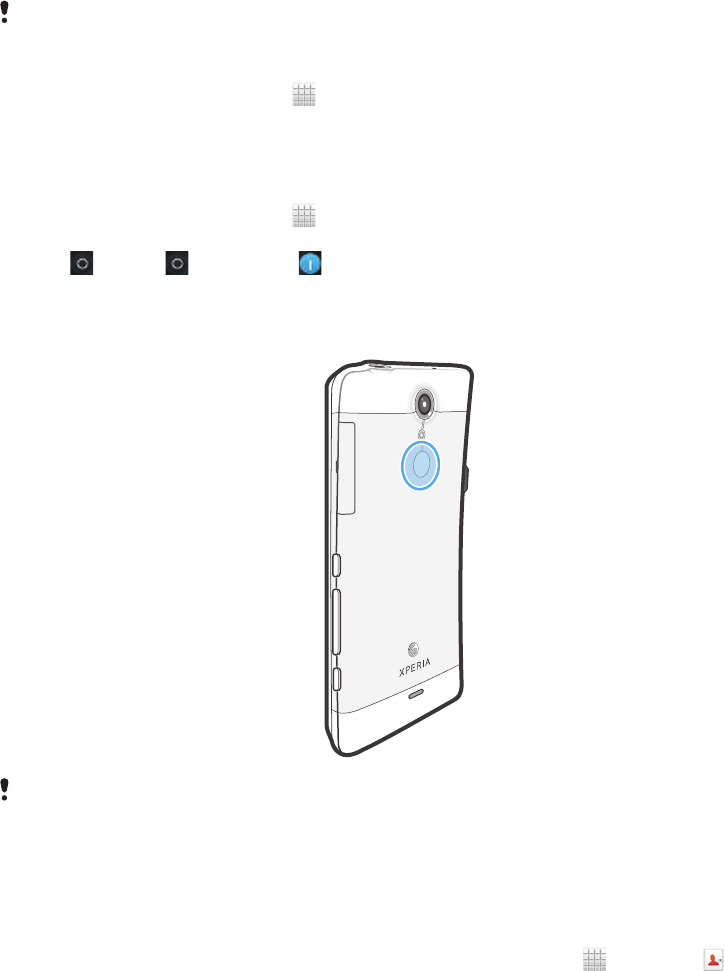
NFC
NFC (Near Field Communication) is a short-range wireless technology that lets you
exchange data with other devices, including a web page address, a music file, a
contact, or a link to an application on Google Play™. Using NFC, you can also scan
special tags that give you more information about a product or service.
To scan or share a tag, you have to hold the NFC detection area of your phone right
over the tag or next to the NFC detection area of the other device. The maximum
reading distance is about one centimetre, which helps prevent unauthorised
communications.
NFC may not be available in all countries and/or regions.
To turn on the NFC function
1From your Home screen, tap .
2Find and tap Settings > More….
3Mark the NFC checkbox.
To turn on the Android Beam function
1From your Home screen, tap .
2Find and tap Settings > More… > Android Beam.
3Tap so that changes to .
NFC detection area
The location of the NFC detection area is not the same on all phones. When sharing data with
another phone using NFC, refer to the User guide of the other phone for more information.
To share a contact with another phone using NFC
1Make sure that both your phone and the receiving phone have the NFC
function and the Android Beam function turned on, and that both phone
screens are active.
2To view contacts in your phone, go to your Home screen, tap , then tap .
3Tap the contact that you want to share.
4Hold your phone and the receiving phone back to back so that the NFC
detection area of each phone touches the other. When the phones connect,
they vibrate and play a short sound. A thumbnail of the contact appears.
5Tap the thumbnail to start the transfer.
6When the transfer is done, the contact information is displayed on the screen
of the receiving phone and is also saved on the receiving phone.
68
This is an Internet version of this publication. © Print only for private use.

To share a music file with another phone using NFC
1Make sure that both your phone and the receiving phone have the NFC
function and the Android Beam™ function turned on, and that both phone
screens are active.
2To open the music player, go to your Home screen, then tap Media > . If
is not displayed, tap , then find and tap .
3Tap the MY MUSIC tab to open the music library.
4Select a music category and browse to the track you want to share.
5Tap the track to play it. You can then tap to pause the track. The transfer
works whether the track is playing or paused.
6Hold your phone and the receiving phone back to back so that the NFC
detection area of each phone touches the other. When the phones connect,
they vibrate and play a short sound. A thumbnail of the track appears.
7Tap the thumbnail to start the transfer.
8When the transfer is done, the music file plays immediately on the receiving
phone. At the same time, the file is saved on the receiving phone.
You might not be able to copy, send or transfer copyright-protected items.
To share a photo or video with another phone using NFC
1Make sure that both your phone and the receiving phone have the NFC
function and the Android Beam function turned on, and that both phone
screens are active.
2To view photos and videos in your phone, go to your Home screen, tap ,
then find and tap Album.
3Tap the photo or video that you want to share.
4Hold your phone and the receiving phone back to back so that the NFC
detection area of each phone touches the other. When the phones connect,
they vibrate and play a short sound. A thumbnail of the photo or video
appears.
5Tap the thumbnail to start the transfer.
6When the transfer is done, the photo or video is displayed on the screen of the
receiving phone. At the same time, the item is saved on the receiving phone.
To share a web address with another phone using NFC
1Make sure that both your phone and the receiving phone have the NFC
function and the Android Beam function turned on, and that both phone
screens are active.
2From your Home screen, tap .
3To open the web browser, find and tap .
4Load the web page that you want to share.
5Hold your phone and the receiving phone back to back so that the NFC
detection area of each phone touches the other. When the phones connect,
they vibrate and play a short sound. A thumbnail of the web page appears.
6Tap the thumbnail to start the transfer.
7When the transfer is done, the web page is displayed on the screen of the
receiving phone.
Scanning NFC tags
Your phone can scan various kinds of NFC tags. For example, it can scan embedded
tags on a poster, on a billboard advertisement, or beside a product in a retail store.
You can receive additional information, such as a web address, or a phone number.
To scan an NFC tag
1Make sure that your phone has the NFC function turned on and that the screen
is active.
2Place your phone over the tag so that the phone's NFC detection area touches
it. Your phone scans the tag and displays the content collected. Tap the
content of the tag to open it.
3To open the tag, tap it.
4To save the tag and return to the previous screen, tap Done.
69
This is an Internet version of this publication. © Print only for private use.

Connecting to wireless networks
You can access the Internet wirelessly from your phone using Wi-Fi® technology.
This way you can browse the web and access cheaper call and data rates. You can
also share media files over the same Wi-Fi® network with other DLNA Certified™
devices, for example, TVs, computers and tablets.
If your company or organisation has a virtual private network (VPN), you can connect
to this network with your phone. You can use a VPN to access intranets and other
internal services at your company.
Wi-Fi®
Using Wi-Fi® technology you can access the Internet wirelessly with your phone. To
access the Internet using a Wi-Fi® connection, you first need to search for and
connect to an available Wi-Fi® network. The signal strength of the Wi-Fi® network
may differ depending on your phone's location. Moving closer to the Wi-Fi® access
point may increase the signal strength.
Before using Wi-Fi®
Your device has Wi-Fi® turned on by default. To browse the Internet using a Wi-Fi®
connection, you need to search for and connect to an available Wi-Fi® network and
then open the Internet browser. The signal strength of the Wi-Fi® network may differ
depending on your phone's location. Move closer to the Wi-Fi® access point to
increase the signal strength.
To turn on Wi-Fi®
1From your Home screen, tap .
2Find and tap Settings.
3Tap beside Wi-Fi so that changes to . The phone scans for available
Wi-Fi® networks.
It may take a few seconds before Wi-Fi® is enabled.
To turn on AT&T Wi-Fi® auto connect
1From the Home screen, tap .
2Find and tap Settings > Wi-Fi.
3Tap , then tap Advanced.
4Mark the AT&T Wi-Fi auto connect checkbox.
Your device is pre-configured to connect to an AT&T Wi-Fi® hotspot when you are within
range.
To connect to a Wi-Fi® network
1From the Home screen, tap .
2Find and tap Settings.
3Make sure that the Wi-Fi® function is on. Tap Wi-Fi.
4Available Wi-Fi® networks are displayed. The available networks may be open
or secured. Open networks are indicated by and secured networks are
indicated by next to the Wi-Fi® network name.
5Tap a Wi-Fi® network to connect to it. If you are trying to connect to a secure
Wi-Fi® network, you are asked to enter a password. is displayed in the
status bar once you are connected.
Your phone remembers Wi-Fi® networks you connect to. The next time you come within reach
of a previously connected Wi-Fi® network, your phone automatically connects to it.
In some locations, open Wi-Fi® networks require you to log in to a web page before you can
get access to the network. Contact the relevant Wi-Fi® network administrator for more
information.
70
This is an Internet version of this publication. © Print only for private use.

To connect to another Wi-Fi® network
1From your Home screen, tap .
2Find and tap Settings > Wi-Fi. Detected Wi-Fi® networks are displayed.
3Tap another Wi-Fi® network to connect to it.
To scan for Wi-Fi® networks manually
1From your Home screen, tap .
2Find and tap Settings > Wi-Fi.
3Tap Scan. The phone scans for Wi-Fi® networks and displays available
networks in a list.
4Tap a Wi-Fi® network in the list to connect to it.
To add a Wi-Fi® network manually
1From the Home screen, tap .
2Find and tap Settings > Wi-Fi.
3Tap Add network.
4Enter the Network SSID for the network.
5Tap the Security field to select a security type.
6If required, enter a password.
7Tap Save.
Contact your Wi-Fi® network administrator to get the Network SSID name and password.
Advanced Wi-Fi® settings
Before you add a Wi-Fi® network manually, you need to turn on the Wi-Fi® setting in
your phone.
Wi-Fi® network status
When you are connected to a Wi-Fi® network or when there are Wi-Fi® networks
available in your vicinity, it is possible to see the status of these Wi-Fi® networks.
You can also enable the phone to notify you whenever an open Wi-Fi® network is
detected.
To enable Wi-Fi® network notifications
1Turn on Wi-Fi®, if it is not already on.
2From your Home screen, tap .
3Find and tap Settings > Wi-Fi.
4Press .
5Tap Advanced.
6Mark the Network notification checkbox.
To view detailed information about a connected Wi-Fi® network
1From the Home screen, tap .
2Find and tap Settings > Wi-Fi.
3Tap the Wi-Fi® network that you are currently connected to. Detailed network
information is displayed.
Wi-Fi® sleep policy
By adding a Wi-Fi® sleep policy, you can specify when to switch from Wi-Fi to
mobile data.
If you are not connected to a Wi-Fi® network, the phone uses mobile data connection to
access the Internet (if you have set up and enabled a mobile data connection in your phone).
71
This is an Internet version of this publication. © Print only for private use.

To add a Wi-Fi® sleep policy
1From the Home screen, tap .
2Find and tap Settings > Wi-Fi.
3Press .
4Tap Advanced.
5Tap Keep Wi-Fi on during sleep.
6Select an option.
Wi-Fi Direct™
Use Wi-Fi Direct™ to connect to other devices directly, without joining a traditional
home, office or hotspot network. For example, you can enable your phone to be
connected directly to a computer so that you can access content from your phone on
the computer. The devices that you share content with must have Wi-Fi Direct™
certification.
To turn on Wi-Fi Direct™
1From your Home screen, tap .
2Find and tap Settings > More….
3Mark the Wi-Fi Direct checkbox.
Wi-Fi® and Wi-Fi Direct™ cannot be turned on at the same time. Wi-Fi Direct™ gets turned off
automatically when you turn on Wi-Fi®, and vice versa.
Sharing your phone’s mobile data connection
You can share your phone’s mobile data connection with a single computer using a
USB cable. This process is called USB tethering. You can also share your phone’s
data connection by turning your phone into a portable Wi-Fi® hotspot. At a given
time, a maximum of eight hot spot clients can connect to the portable Wi-Fi hotspot.
You must have a tethering data plan to be able to use this feature. Contact AT&T for more
information.
When your phone is sharing its data connection, the following icons may appear in
the status bar or in the Notification panel:
USB tethering is active
Portable Wi-Fi® hotspot is active
Both USB tethering and portable hotspot are active
To share your phone’s data connection using a USB cable
1Deactivate all USB cable connections to your phone.
2Using the USB cable that came with your phone, connect your phone to a
computer.
3From your Home screen, tap .
4Find and tap Settings > More… > Tethering & portable hotspot.
5Mark the USB tethering checkbox. The phone starts sharing its mobile
network data connection with the computer over the USB connection. An
ongoing notification appears in the status bar and the Notification panel.
6Unmark the USB tethering checkbox, or disconnect the USB cable to stop
sharing your data connection.
You cannot share your phone’s data connection and SD card over a USB cable at the same
time. For more information, see Connecting your phone to a computer on page 115.
You may need to prepare your computer to establish a network connection via USB cable. Go
to android.com/tether to get the most current information.
72
This is an Internet version of this publication. © Print only for private use.

To share your phone’s data connection as a portable Wi-Fi® hotspot
1From the Home screen, tap .
2Find and tap Settings > More… > Tethering & portable hotspot.
3Tap Portable Wi-Fi hotspot settings > Configure Wi-Fi hotspot.
4Enter the Network SSID for the network. Tap the Security field to select a
security type.
5If required, enter a password.
6Tap Save.
7Mark the Portable Wi-Fi hotspot checkbox. The phone starts broadcasting its
Wi-Fi® network name (SSID).
8Unmark the Portable Wi-Fi hotspot checkbox when you want to stop sharing
your data connection via Wi-Fi®.
To rename or secure your portable hotspot
1From the Home screen, tap .
2Find and tap Settings > More… > Tethering & portable hotspot.
3Make sure the Portable Wi-Fi hotspot checkbox is marked.
4Tap Portable Wi-Fi hotspot settings > Configure Wi-Fi hotspot.
5Enter the Network SSID for the network.
6Tap the Security field and select a security type.
7If required, enter a password.
8Tap Save.
Virtual private networks (VPNs)
Use your phone to connect to virtual private networks (VPNs), which allow you to
access resources inside a secured local network from outside the actual network. For
example, VPN connections are commonly used by corporations and educational
institutions for users who need to access intranets and other internal services when
they are outside of the internal network, for example, when they are travelling.
VPN connections can be set up in many ways, depending on the network. Some
networks may require you to transfer and install a security certificate in your phone.
See Connecting your phone to a computer on page 115 for more information on how
to transfer content to your phone. For detailed information on how to set up a
connection to your virtual private network, please contact the network administrator
of your company or organisation.
To add a virtual private network
1From your Home screen, tap .
2Find and tap Settings > More… > VPN.
3Tap Add VPN network.
4Select the type of VPN to add.
5Enter your VPN settings.
6Tap Save.
To connect to a virtual private network
1From your Home screen, tap .
2Find and tap Settings > More… > VPN.
3In the list of available networks, tap the VPN that you want to connect to.
4Enter the required information.
5Tap Connect.
To disconnect from a virtual private network
1Drag the status bar downwards.
2Tap the notification for the VPN connection to turn it off.
73
This is an Internet version of this publication. © Print only for private use.
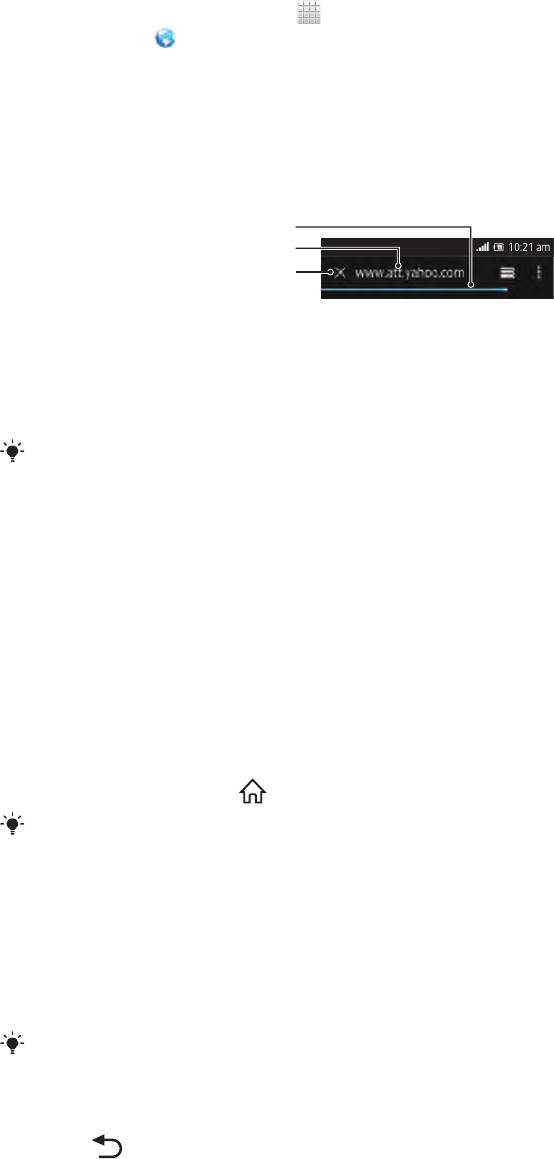
Web browser
Use your web browser to view and navigate web pages, add pages as bookmarks,
and save pages for offline viewing. You can open up to 16 windows at the same time
and switch among them easily. You can also request the desktop version of a web
page if you don't want to view the mobile version.
To open the web browser
1From your Home screen, tap .
2Find and tap .
Browsing the web
Search and address bar
Use the search and address bar to browse the web.
1
2
3
1View the download progress of the current web page
2 Enter a search word to search for a web page, or enter a web page address to load a web page
3 Cancel the download of the current web page
Sometimes the search and address bar is not displayed after a web page finishes
downloading. It appears again if you flick downwards on the screen.
To go to a web page
1Tap the search and address text field to activate the keypad.
2Enter a web address.
3Tap Go.
To search a web page
1Tap the search and address text field to activate the keypad.
2Enter a search word.
3Tap Go.
To exit the web browser
•While browsing, press .
When you open the browser again, even after restarting the phone, the browser appears
exactly as it did before you exited. For example, the same number of windows will be open.
Navigating web pages
To select a link
•To select a link in a web page, tap the link. The selected link gets highlighted,
and the web page starts to load after you release your finger.
If you select a link by mistake before releasing your finger, you can drag your finger away from
the link to deselect it.
To go to the previous page while browsing
•Press .
74
This is an Internet version of this publication. © Print only for private use.

To zoom in or out on a web page
Use one of the following methods to zoom in or out on a web page:
•Double-tap to zoom in on the web page, or double-tap again to zoom out.
•Touch an area of the page with two fingers at once and spread them apart to
zoom in, or pinch them together to zoom out.
To reload the current web page
1Flick downwards on the screen to make appear.
2Press , then tap Refresh.
To save a web page for offline viewing
1Flick downwards on the screen to make appear.
2Press .
3Tap Save for offline reading. You are directed to the Saved pages tab, where
you can view all saved web pages.
To view a previously saved web page
1When the browser is open, flick downwards on the screen to make the search
and address bar appear.
2Tap next to the search and address bar.
3Tap , then tap the Saved pages tab.
4Find and select a web page that you want to view.
To load the live version of an offline web page
1When an offline web page is open, flick downwards on the screen to make
appear.
2Press , then tap Go live.
To request the desktop version of a web page
1While browsing the web page, flick downwards on the screen to make
appear.
2Press , then tap Request desktop site.
Once you choose to view the desktop version of a web page in a window, any other web
pages that you view later in the same window will also show their desktop versions. Tap
Request desktop site again to change the setting back.
To share a link to the current web page
1Flick downwards on the screen to make appear.
2Press , then tap Share page.
3Select an available transfer method, then follow the on-screen instructions.
To close a browser window
1When the browser is open, flick downwards on the screen to make the search
and address bar appear.
2Tap next to the search and address bar. A list of all open windows appears.
3Tap in the window you want to close, or flick the window left or right off the
screen to close it.
Browser Bar
Your web browser features an integrated Browser Bar. Use the Browser Bar to
quickly access your favourite websites and services, to create shortcuts, and to share
content with others.
75
This is an Internet version of this publication. © Print only for private use.
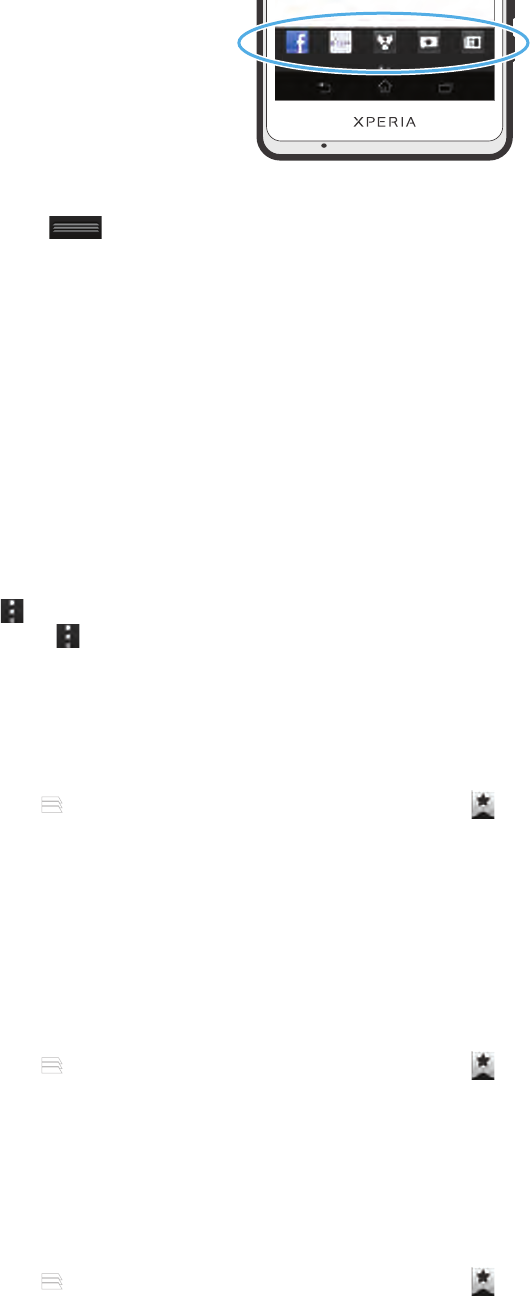
To open the Browser Bar
•Drag at the bottom of the browser window upwards.
To close the Browser Bar
•Drag the Browser Bar downwards.
Managing bookmarks
Bookmarks let you access your favourite and frequently visited web pages quickly.
You can add bookmarks directly from your phone browser. You can also synchronise
your phone browser with Google Chrome™ bookmarks that you have synchronised
to your Google account using a computer. See To synchronise the web browser data
with Google™ Chrome™ on page 65. Some bookmarks may be pre-installed on your
phone.
To bookmark a web page
1While you are viewing the web page, flick downwards on the screen to make
appear.
2Press , then tap Save to bookmarks.
3If desired, edit the bookmark.
4When you're done, tap OK.
To open a bookmark
1When the browser is open, flick downwards on the screen to make the search
and address bar appear.
2Tap next to the search and address bar, then tap . The names of any
accounts that you have synchronised with Google Chrome™ are displayed.
Bookmarks that you have saved directly on the phone are listed under the
Local account.
3To show an account's bookmarks, tap the account. All bookmarks in the
account are displayed.
4To open a bookmark, tap it.
To edit a bookmark
1When the browser is open, flick downwards on the screen to make the search
and address bar appear.
2Tap next to the search and address bar, then tap .
3Touch and hold a bookmark.
4In the menu that appears, tap Edit bookmark.
5Edit the bookmark as desired.
6When you're done, tap OK.
To add a bookmarked web page to your Home screen
1When the browser is open, flick downwards on the screen to make the search
and address bar appear.
2Tap next to the search and address bar, then tap .
3Tap and hold a bookmark that you want to add to your Home screen.
4In the menu that appears, tap Add shortcut to home.
76
This is an Internet version of this publication. © Print only for private use.

To share a bookmark
1When the browser is open, flick downwards on the screen to make the search
and address bar appear.
2Tap , then tap .
3Tap and hold a bookmark that you want to share.
4In the menu that appears, tap Share link, then select a share option.
To delete a bookmark
1When the browser is open, flick downwards on the screen to make the search
and address bar appear.
2Tap next to the search and address bar, then tap .
3Touch and hold a bookmark.
4In the menu that appears, tap Delete bookmark to delete the selected
bookmark.
To bookmark a previously visited web page
1When the browser is open, flick downwards on the screen to make the search
and address bar appear.
2Tap next to the search and address bar, then tap .
3Tap the History tab, then tap one of the down arrows to view a list of
previously visited web pages.
4Tap beside the web page that you want to add as a bookmark.
5If desired, edit more detailed information such as the name and location of the
bookmark.
6When you're done, tap OK.
Managing text and images
To find text within a web page
1When you are viewing a web page, flick downwards on the screen to make
appear.
2Press , then tap Find on page.
3Enter your search text. Characters that match your search get highlighted on
the web page.
4Tap the up or down arrows to go to the previous or next highlighted item.
5Tap to close the search bar.
To copy text from a web page
1Touch and hold part of the text you want to copy until it becomes highlighted.
Tabs appear at each end of the selection. Drag the tabs accordingly to select
all the text that you want to copy.
2Tap .
3To paste text into an email, text message or multimedia message, touch and
hold the text field in the relevant application and tap Paste in the menu that
appears.
If the text that you want to copy is part of a link to another web page, a menu appears in which
you need to tap Select text before you can continue.
To save an image from a web page
1On the active web page, touch and hold the desired image until a menu
appears.
2Tap Save image.
Multiple windows
Your browser can run up to 16 different windows at the same time. You can, for
example, log in to your webmail in one window and read the daily news in another.
You can easily switch from one window to another. If you want to browse the web
77
This is an Internet version of this publication. © Print only for private use.

with more privacy, you can use the incognito tab to open a window that saves no
personal information or cookies while you’re connected through it.
To open a new browser window
1When the browser is open, flick downwards on the screen to make the search
and address bar appear.
2Tap next to the search and address bar, then tap .
To open an incognito window
1When the browser is open, flick downwards on the screen to make the search
and address bar appear.
2Tap next to the search and address bar.
3Press , then tap New incognito tab.
To open a link in a new browser window
1Touch and hold a link until a menu appears.
2Tap Open in new tab.
To switch between browser windows
1When the browser is open, flick downwards on the screen to make the search
and address bar appear.
2Tap next to the search and address bar.
3Scroll up and down to browse a list of all open windows.
4Tap the window that you want to switch to.
Downloading from the web
You can download applications and content when you browse the web using the web
browser in your phone. Usually you have to touch a download link for the desired file
and the download then starts automatically.
To view your downloaded files
1From your Home screen, tap .
2Find and tap .
To cancel an ongoing download
1When your phone starts downloading a file, drag down the status bar and tap
the file you are downloading.
2Mark the checkbox beside the downloading file that you want to cancel.
3Tap .
Browser settings
You can change the browser settings and customise your browser view. For
example, you can change the size of the text displayed to suit your needs, or you can
clear cache, cookies, browser history, and other data linked to the websites you visit.
To access your browser settings
1When the browser is open, flick downwards on the screen to make appear.
2Press , then tap Settings.
To change the text size on web pages
1When the browser is open, flick downwards on the screen to make appear.
2Press , then tap Settings > Accessibility.
3Adjust the text size settings as desired.
78
This is an Internet version of this publication. © Print only for private use.

To clear the cache memory from your phone
1When the browser is open, flick downwards on the screen to make appear.
2Press , then tap Settings > Privacy & security.
3Tap Clear cache, then tap OK to confirm.
To clear your browser cookies
1When the browser is open, flick downwards on the screen to make appear.
2Press , then tap Settings > Privacy & security.
3Tap Clear all cookie data, then tap OK to confirm.
To clear your browser history
1When the browser is open, flick downwards on the screen to make appear.
2Press , then tap Settings > Privacy & security.
3Tap Clear history, then tap OK to confirm.
Auto-fitting web pages
Your browser has an auto-fit option which makes it easier to read large web pages
with lots of text and images, such as news pages. When this option is enabled, your
browser automatically refits images and columns of text on the screen when you
double-tap the screen directly after zooming with your fingers. If auto-fit is disabled,
you may need to scroll sideways to read a full sentence.
To auto-fit web pages
1When the browser is open, flick downwards on the screen to make appear.
2Press , then tap Settings > Advanced > Auto-fit pages.
Auto-filling text
Auto-filling allows you to automatically enter data such as names and addresses on
various web forms, so you don’t have to enter the same information repeatedly on
different web pages.
To create text for auto-filling
1When the browser is open, flick downwards on the screen to make appear.
2Press , then tap Settings > General.
3Mark the Form auto-fill checkbox, if it is not already marked.
4Tap Auto-fill text, then enter text that you want to use for auto-filling on web
forms, for example, your name and address.
5When you're done, tap Save.
Plug-in settings
You can adjust how a plug-in functions on a web page. For example, you can enable
plug-ins to get optimal visual effect when you view a web page. Alternatively, to
increase browsing speed, you can configure your browser to only run plug-ins on
demand, or you can disable plug-ins completely.
To enable plug-ins on demand
1When the browser is open, flick downwards on the screen to make appear.
2Press , then tap Settings > Advanced > Enable plug-ins.
3Tap On demand.
You may need to restart your browser for the setting to take effect.
79
This is an Internet version of this publication. © Print only for private use.

Listening to music with the Walkman™
player
Get the most out of your Walkman™ player. Listen to and organise music, audio
books and podcasts that you have transferred to your memory card from a computer,
or purchased and downloaded from online stores.
To make content easily available to the Walkman™ player, you can use the
Media Go™ application. Media Go™ helps transfer music content between a
computer and a phone. For more information, see Connecting your phone to a
computer on page 115.
Protecting your hearing
Listening to the Walkman™ player or other media players at excessive volume or for
a prolonged period of time can damage your hearing, even when the volume is at a
moderate level. To alert you to such risks, a volume level warning appears when the
volume is too high, and after the Walkman™ player is used for over 20 hours.
To turn off the volume level warning
•When appears, tap OK to dismiss the warning.
Every time you restart your phone, the media volume is automatically set to moderate level.
Copying media files to your memory card
You can copy all your favourite media content from a computer to your phone and
then play or view this content on your phone. Media content can include music,
photos and videos. The easiest way to transfer files is with a USB cable. After you
connect the phone and computer using the USB cable, you can use the file manager
application on the computer or the Media Go™ application to transfer the files.
See Connecting your phone to a computer on page 115 for more general information
about connecting your phone to a computer and transfering files.
Using the Walkman™ player
To play audio content
1From your Home screen, tap , then find and tap .
2Tap MY MUSIC to open the music library.
3Select a music category and browse to the track that you want to open.
4Tap a track to play it.
80
This is an Internet version of this publication. © Print only for private use.
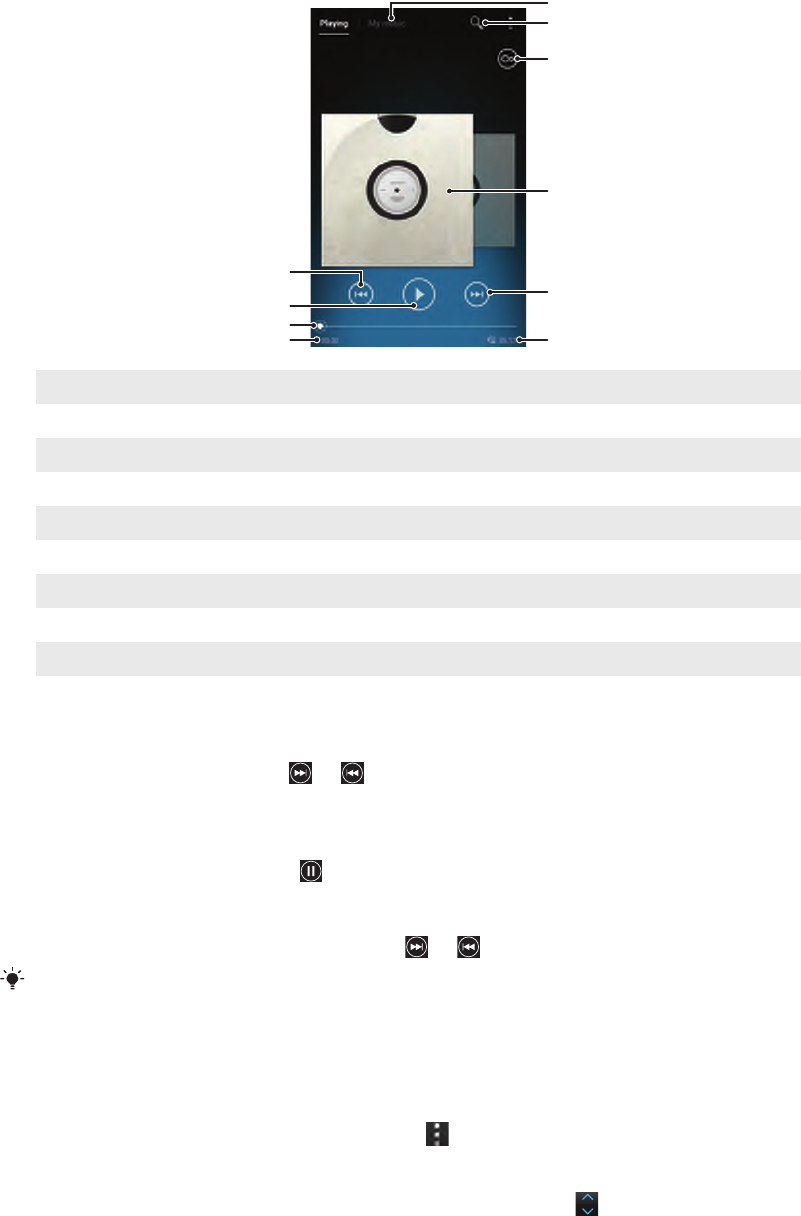
Walkman™ player overview
10
4
1
3
5
8
67
2
9
Track name
Artist name
album name
1 Browse the music on your memory card
2 Search all tracks saved on your phone's internal storage
3 Tap the infinite button to find related information online and plug-ins on Google Play™
4 Album art (if available)
5 Go to the next track in the current play queue, or fast forward
6 Total time length of the track
7 Elapsed time of current track
8 Progress indicator – drag the indicator or tap along the line to fast forward or rewind
9 Play/Pause button
10 Go to the previous track in the current play queue, or rewind
To change tracks
•When a track is playing, tap or .
•When a track is playing, swipe the album art left or right.
To pause a track
•In the Walkman™ player, tap .
To fast forward and rewind music
•In the Walkman™ player, touch and hold or .
You can also drag the progress indicator marker right or left.
To adjust the audio volume
•When the Walkman™ player is playing a track, press the volume key.
To improve the sound quality using the equalizer
1When the Walkman™ player is open, press .
2Tap Sound enhancements.
3If you want to adjust the sound manually, drag the frequency band buttons up
or down. If you prefer to adjust the sound automatically, tap and select a
style.
81
This is an Internet version of this publication. © Print only for private use.

To turn on the Surround sound
1When the Walkman™ player is open, press .
2Tap Sound enhancements > > More > Headphone surround.
3Select a setting.
4Tap OK.
To view the current play queue
•While a track is playing in the Walkman™ player, tap the album art and then
tap .
To minimise the Walkman™ player
•When the Walkman™ player is playing, press to go to the previous screen,
or press to go to the Home screen. The Walkman™ player stays playing in
the background.
To return to the Walkman™ player when it is playing in the background
1While a track is playing in the background, drag the status bar downwards to
open the Notification panel.
2Tap the track title to open the Walkman™ player.
Alternatively, you can press and hold and then tap to return to the Walkman™ player.
To delete a track
1Open the Walkman™ player library and browse to the track that you want to
delete.
2Touch and hold the track title, then tap Delete.
You can delete albums and artists in the same way.
To share a track
1When browsing your tracks in the Walkman™ player library, touch and hold a
track title.
2Tap Send.
3Select an available transfer method, and follow the on-screen instructions.
You can also share albums and playlists in the same way.
You might not be able to play copyright-protected items. Please verify that you have
necessary rights in material that you intend to share.
To recommend a track on Facebook™
1While the track is playing in the Walkman™ player, tap the album art.
2Tap to show that you "Like" the track on Facebook™. If desired, add a
comment in the comments field.
3Tap Share to send the track to Facebook™. If the track is received
successfully, you will get a confirmation message from Facebook™.
Visualizer
The Visualizer adds visual effects to your music tracks as you play them. The effects
for each track are based on the characteristics of the music. They change, for
example, in response to changes in the music’s loudness, rhythm and frequency
level. You can also change the background theme.
To turn on the Visualizer
1In the Walkman™ player, press .
2Tap Visualiser.
Tap to switch to full screen view.
82
This is an Internet version of this publication. © Print only for private use.
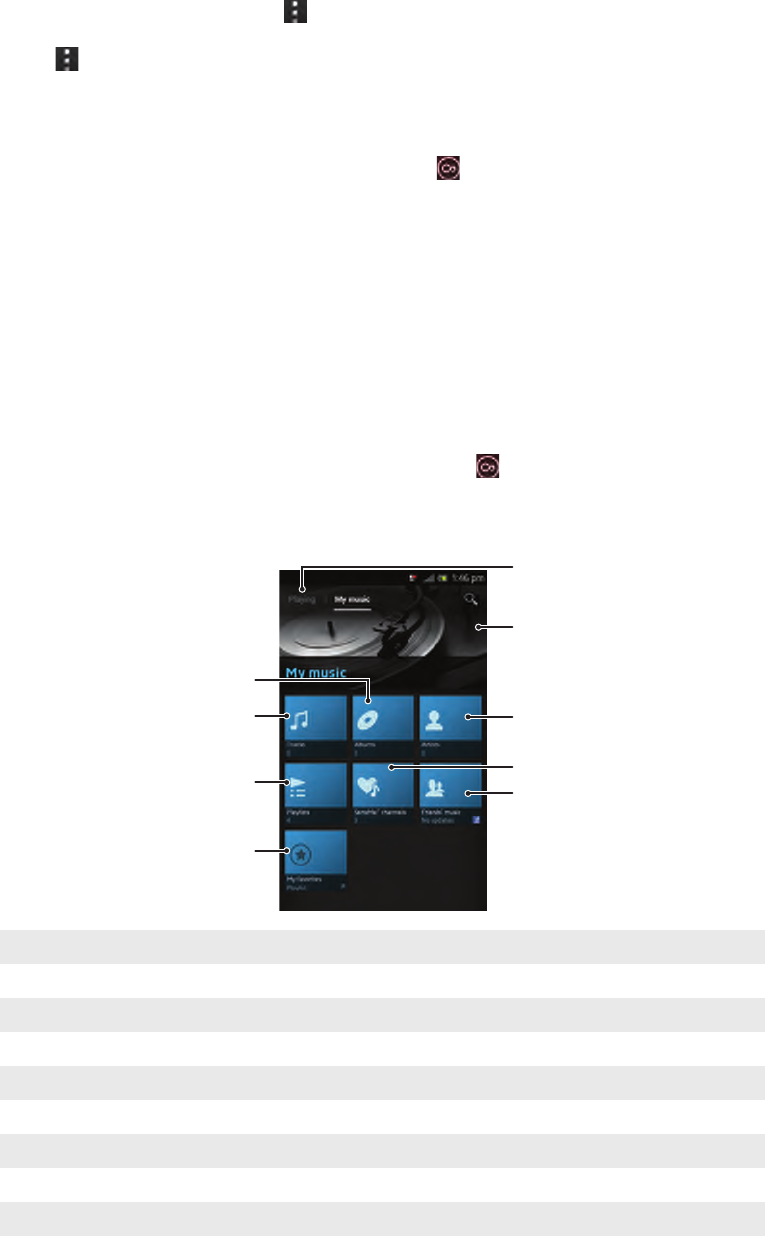
To change the background theme
1In the Walkman™ player, press .
2Tap Visualiser.
3Press > Theme and select a theme.
Discovering related audio content
In the Walkman™ player, you can discover audio content that is related to the artist
you are listening to by tapping the infinite button .
You can also search for audio content related to a particular artist while you are
browsing the Walkman™ player. The Walkman™ player searches for and lists the
following types of results:
•Music videos on YouTube™
•Artist info on Wikipedia™
•Lyrics on Google
•Karaoke videos on YouTube™
•Extension searches on the web
•Content from the PlayNow™ service
To search for related content using the infinite button
•When a track is playing in the Walkman™ player, tap .
Overview of My music
3
1
2
6
4
7
8
5
9
1Go back to the current track
2 Picture of the currently playing artist (if available)
3 Browse your music by artist
4 Categorise your music using SensMe™ channels
5 Collect links to music and related content that you and friends have shared using online services
6 Browse your favourite playlists
7 Browse all playlists
8 Browse audio by track
9 Browse by album
Using My music to organise your tracks
Tap the My Music tab in the Walkman™ player to get an overview of all the tracks
you've saved to your phone's memory card. In My Music you can manage your
albums and playlists, create shortcuts, and arrange music by mood and tempo.
83
This is an Internet version of this publication. © Print only for private use.

To add a music track as a shortcut
1In the Walkman™ player, tap MY MUSIC.
2Tap , , or , then browse to the track that you want to save as a
shortcut.
3Touch and hold the track title.
4Tap Add as shortcut. The shortcut now appears in the My music main view.
To rearrange shortcuts
1In the Walkman™ player, tap MY MUSIC.
2Touch and hold a shortcut until it magnifies and the phone vibrates, then drag
the item to a new location.
To delete a shortcut
1In the Walkman™ player, tap MY MUSIC.
2Touch and hold a shortcut until it magnifies and the phone vibrates, then drag
the item to .
You can't delete the following tabs: Tracks, Albums, Artists, Playlists, Music Unlimited,
Friends' music and SensMe™ channels.
To update your music with the latest information
1In the Walkman™ player, tap MY MUSIC, then press .
2Tap Download music info > Start. Your phone searches online and downloads
the latest available album art and track information for your music.
The SensMe™ channels application gets activated when you download music information.
Categorising your music using SensMe™ channels
The SensMe™ channels application helps you arrange your music by mood and
tempo. SensMe™ groups all your tracks into several categories, or channels, so you
can select music that matches your mood or suits the time of day.
To enable the SensMe™ channels application
1In the Walkman™ player, tap MY MUSIC.
2Press , then tap Download music info.
This application requires a mobile or Wi-Fi® network connection.
Using the Friends' music application to share music
The Friends’ music application collects links to music and music-related content that
you and your friends have shared using online services such as Facebook™,
YouTube™, Spotify™, last.fm™, izlesene™ and Pandora™. You may need to sign in
to the relevant online service before you can use it.
Some online services may not be available in all countries or regions.
To manage music from your friends
1In the Walkman™ player, tap MY MUSIC > Friends' music > Recent.
2Tap an item to open it, then work on it as desired.
3Tap to show that you "Like" the track on Facebook™. If desired, add a
comment in the comments field.
To view your shared music
1In the Walkman™ player, tap MY MUSIC > Friends' music > My shares.
2Scroll to an item you want to open, then tap it. All comments about the item, if
any, are displayed.
84
This is an Internet version of this publication. © Print only for private use.

Playing music in random order
You can play tracks in playlists in random order. A playlist can be, for example, a
playlist you have created yourself or an album.
To play tracks in random order
1In the Walkman™ player, tap MY MUSIC.
2Tap and navigate to an album, or tap and browse to a playlist.
3Open the album or playlist by tapping its name.
4Tap to turn on Shuffle mode.
To turn off shuffle mode
1When tracks are playing in random order, press .
2Tap Shuffle mode > Shuffle off.
Playlists
The Walkman™ player automatically creates Smart playlists on the playlist tab in
the Walkman™ player library. You can also create your own playlists from the music
that is saved on your phone's memory card.
In addition, you can install the Media Go™ application on a computer and use it to
copy playlists from the computer to your phone's memory card. For more
information, see Connecting your phone to a computer on page 115.
To create your own playlists
1In the Walkman™ player, tap MY MUSIC.
2To add an artist, album or a track to a playlist, touch and hold the name of the
artist or the title of the album or track.
3In the menu that opens, tap Add to playlist > Create new playlist.
4Enter a name for the playlist and tap OK.
To add tracks to a playlist
1When browsing the Walkman™ player library, touch and hold the name of the
artist or the title of the album or track you want to add.
2Tap Add to playlist.
3Tap the name of the playlist to which you want to add the artist, album or
track. The artist, album or track is added to the playlist.
To play your own playlists
1In the Walkman™ player, tap MY MUSIC.
2Tap .
3Under Playlists, tap a playlist.
4Tap a track to play it.
To remove a track from a playlist
1In a playlist, touch and hold the title of the track you want to delete.
2Tap Delete from playlist.
To delete a playlist
1In the Walkman™ player, tap MY MUSIC, then select Playlists.
2Touch and hold the playlist you want to delete.
3Tap Delete.
4Tap Delete again to confirm.
You cannot delete default playlists.
Walkman™ player widget
The Walkman™ player widget is a miniature application that gives you direct access
to the Walkman™ player from your Home screen. You need to add this widget to
your Home screen before you can use it.
85
This is an Internet version of this publication. © Print only for private use.

To add the Walkman™ player widget to your Home screen
1Tap an empty area on your Home screen, then tap .
2Find and tap WALKMAN to add.
86
This is an Internet version of this publication. © Print only for private use.
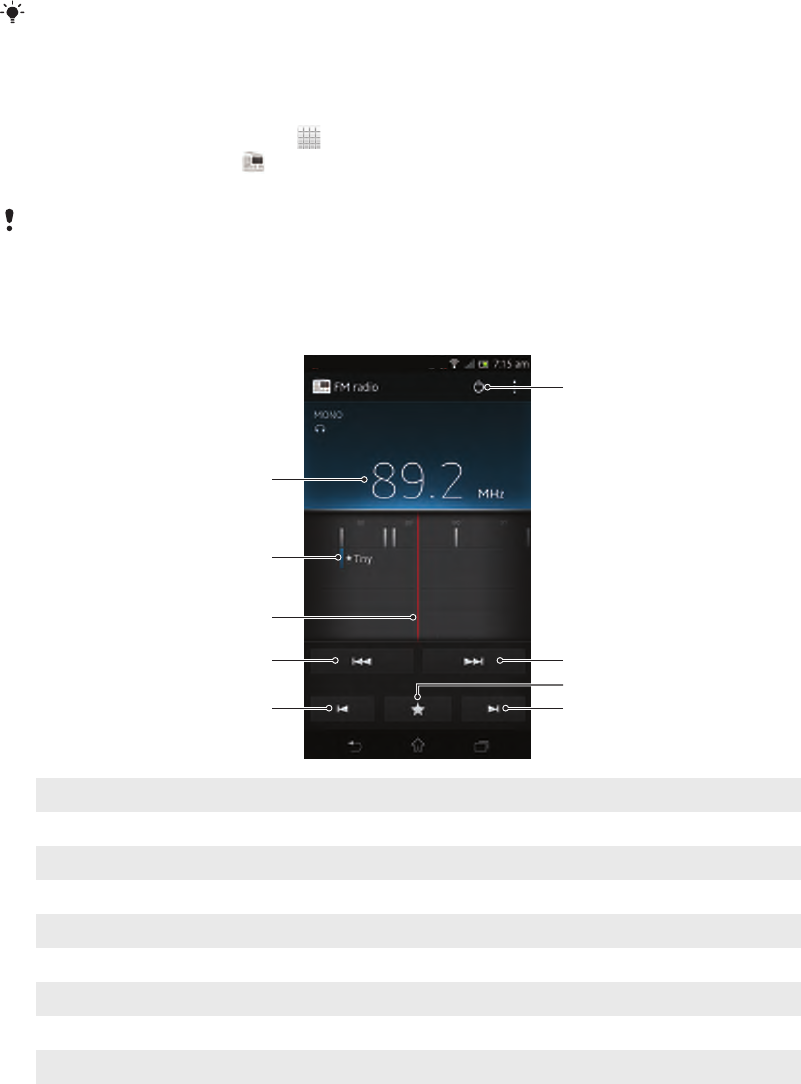
Using the FM radio
The FM radio in your phone works like any FM radio. For example, you can browse
and listen to FM radio stations and save them as favourites. You must connect a
wired headset or headphones to the phone before you can use the radio. This is
because the headset or headphones act as an antenna. After one of these devices is
connected, you can then switch the radio sound to the phone speaker, if desired.
When you open the FM radio, available channels appear automatically. If a channel has RDS
information, it appears a few seconds after you start listening to the channel.
To start the FM radio
1Connect a headset or a set of headphones to your phone.
2From your Home screen, tap .
3Find and tap FM radio . The available channels appear as you scroll
through the frequency band.
When you start the FM radio, available channels appear automatically. If a channel has RDS
information, it appears a few seconds after you start listening to the channel.
FM radio overview
9
8
6
1
2
5
4
3
7
1Tuned frequency
2 A saved favourite channel
3 Tuning dial
4 Move down the frequency band to search for a channel
5 Move down the frequency band to the next favourite channel
6 Move up the frequency band to the next favourite channel
7 Save or remove a channel as a favourite
8 Move up the frequency band to search for a channel
9 Radio on/off button
To move between radio channels
•Flick your finger left or right along the frequency band.
•Drag the tuning dial right or left.
87
This is an Internet version of this publication. © Print only for private use.

Using your favourite radio channels
You can save the radio channels you most frequently listen to as favourites. By using
favourites you can quickly return to a radio channel.
To save a channel as a favourite
1When the radio is open, navigate to the channel that you want to save as a
favourite.
2Tap , then select .
3Enter a name for the channel, then press Save.
To remove a channel as a favourite
1When the radio is open, tap .
2Tap next to the channel that you want to remove.
3Tap Delete.
To move between favourite channels
•When the radio is open, tap or .
To move between favourites, you must first save at least two channels as favourites.
Making a new search for radio channels
If you have moved to a new location or the reception has improved in your current
location, you can start a new scan for radio channels.
Any favourites you have saved are not affected by a new scan.
To start a new search for radio channels
1When the radio is open, press .
2Tap Search for channels. The radio scans the whole frequency band, and all
available channels are displayed.
Switching the radio sound between devices
You can listen to the radio through a wired headset or through wired headphones.
Once either device is connected, you can switch the sound to the phone speaker, if
desired.
To switch the radio sound to the phone speaker
1When the radio is open, press .
2Tap Play in speaker.
To switch the sound back to the wired headset or headphones, press and tap Play in
headphones.
Switching between mono and stereo sound mode
You can listen to your FM radio in either mono or stereo mode. In some situations,
switching to mono mode can reduce noise and improve sound quality.
To switch between mono and stereo sound mode
1When the radio is open, press .
2Tap Enable stereo sound.
3To listen to the radio in mono sound mode again, press and tap Force
mono sound.
88
This is an Internet version of this publication. © Print only for private use.

Sharing the details of music you like on Facebook™
When you listen to music using the FM Radio, you can share details of tracks you like
on Facebook. You need to be a Facebook user and must be logged in to Facebook.
To share details of music you like on Facebook™
1When the FM radio is playing a music track that you want to share, find and
tap .
2Add a comment in the comment field, if desired.
3Tap Share to send details of the track to Facebook.
4Tap Cancel to return to the FM radio application.
5Once you have posted a track to your Facebook account, a confirmation
message appears on the FM radio screen.
will not appear on the FM radio screen if you are not logged in to Facebook.
89
This is an Internet version of this publication. © Print only for private use.
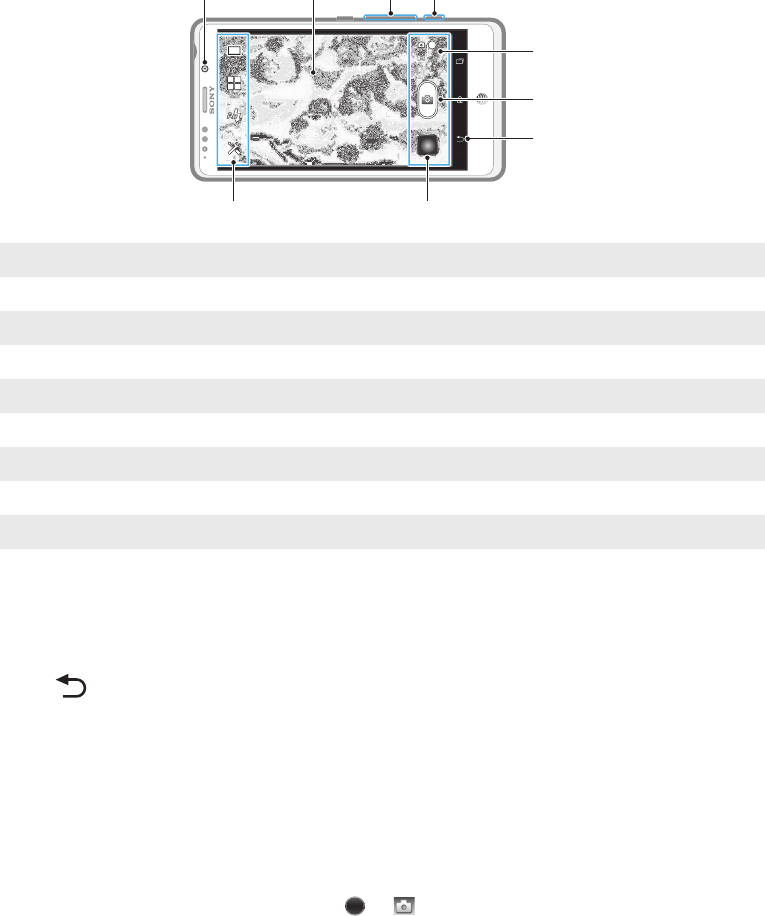
Taking photos and recording videos
Your phone camera is equipped with the highly sensitive Exmor R™ sensor, which
helps you capture sharp photos and videos even in low lighting conditions. With your
phone camera, you can take regular 2D photos. Send your photos and videos to
friends as multimedia messages, or upload them to a web service. Your phone also
has a front camera, which is useful for self-portraits.
Camera controls overview
2
78 19
6
5
4
3
1 Camera key – Activate the camera/Take photos/Record videos
2 Switch between still and video camera
3 Take photos or record video clips
4 Go back a step or exit the camera
5 View photos and videos
6 Camera setting icons
7 Front camera
8 Main camera screen
9 Zoom in or out
To open the camera
•When the screen is active, press and hold down the camera key.
To close the camera
•Press from the main camera screen.
Using the still camera
There are three ways to take photos with the still camera. You can press the camera
key, tap the on-screen camera button, or touch a spot on the screen.
To take a photo using the camera key
1Activate the camera.
2If the still camera is not selected, drag to .
3Press the camera key halfway down to activate auto-focus.
4When the focus frame or frames are green, press the camera key fully down.
90
This is an Internet version of this publication. © Print only for private use.

To take a photo by touching the screen
1Activate the camera.
2If the still camera is not selected, drag to .
3To display all settings, tap .
4Tap Capturing method and select Touch capture if it is not already selected.
5Point the camera towards the subject.
6To activate auto focus, touch and hold a spot on the screen. When the focus
frame turns green, lift your finger to take the photo.
Be careful not to touch , or other icons when touching the screen to take a photo.
To take a photo by tapping the on-screen button
1Activate the camera.
2If the still camera is not selected, drag to .
3To display all settings, tap .
4Tap Capturing method and select On-screen button if it is not already
selected.
5Point the camera towards the subject.
6Tap the on-screen button . The photo is taken as soon as you release your
finger.
To take a self-portrait using the front camera
1Activate the camera.
2If the still camera is not selected, drag to .
3Tap the icon on the top left of the screen, then select Front camera.
4To display all settings, tap .
5To take the photo, press the camera key. The photo is taken as soon as you
release your finger.
To use the zoom function
•When the camera is open, press the volume key up or down to zoom in or out.
To use the still camera flash
1When the camera is open, tap .
2Tap Flash, and select your desired flash setting.
3Take the photo.
To view your photos and videos
1Open the camera, then tap a thumbnail at the bottom of the screen to open a
photo or video.
2Flick left or right to view your photos and videos. Videos are identified by .
In step 1, you can also flick the thumbnails from right to left and then select the one you want
to view.
To delete a photo
1Open the photo you want to delete.
2Tap .
Face detection
You can use face detection to bring an off-centre face into focus. The camera
automatically detects up to five faces, indicated by white frames. A yellow frame
shows which face has been selected for focus. Focus is set to the face closest to the
camera. You can also tap one of the frames to select which face should be in focus.
91
This is an Internet version of this publication. © Print only for private use.

To turn on face detection
1Activate the camera.
2If the still camera is not selected, drag to .
3Tap the icon on the top left, then select Normal.
4To display all settings, tap .
5Tap Focus mode > Face detection.
To take a photo using face detection
1When the camera is open and Face detection turned on, point the camera at
your subject. Up to five faces can be detected, and each detected face is
framed.
2Press the camera key halfway down. A green frame shows which face is in
focus.
3To take the photo, press the camera key fully down.
Smile detection
Smile detection allows you to capture a face just as it smiles. The camera detects up
to five faces and selects one face for smile detection and auto focus. A green frame
shows which face is selected. When the selected face smiles, the camera
automatically takes a photo.
To turn on smile detection
1Activate the camera.
2If the still camera is not selected, drag to .
3To display all settings, tap .
4Tap Smile detection and select a smile level.
To take a photo using smile detection
1When the camera is open and Smile detection is turned on, point the camera
at your subject. Each detected face is framed in the viewfinder (not more than
five faces).
2The camera selects which face to focus on.
3The face selected appears inside a green frame and the photo is taken
automatically.
4If no smile is detected, press the camera key to take the photo manually.
Adding the geographical position to your photos
Turn on geotagging to add the approximate geographical location (a geotag) to
photos when you take them. The geographical location is determined either by
wireless networks (mobile or Wi-Fi® networks) or GPS technology.
When appears on the camera screen, geotagging is turned on but the
geographical position has not been found. When appears, geotagging is turned on
and the geographical location is available, so your photo can get geotagged. When
neither of these two symbols appears, geotagging is turned off.
To turn on geotagging
1Activate the camera.
2If the still camera is not selected, drag to .
3Tap , then tap Geotagging > On.
4Tap OK to agree to enable GPS and/or wireless networks.
5Check the options you want to select under Location services.
6After you confirm your settings, press to return to the camera screen.
7If appears on the camera screen, your location is available and your photo
can get geotagged. If not, check your GPS and/or wireless network
connection.
92
This is an Internet version of this publication. © Print only for private use.

Using still camera settings
To adjust the still camera settings
1Activate the camera.
2If the still camera is not selected, drag to .
3Tap one of the settings icons on the left of the screen.
4To display all settings, tap .
5Select the setting you want to adjust, then edit as desired.
To customise the still camera settings panel
1When the camera is open, tap to display all settings.
2Touch and hold the setting you want to move and drag it to the desired
position.
If you drag the setting outside of the settings panel, the change is cancelled.
Still camera settings overview
Scene recognition
Normal
Front camera
Select the front camera if you want to take self-portrait photos.
Sweep Panorama
Use this setting to take wide-angle, panoramic photos. Just press the camera key and move the
camera steadily from one side to the other.
Focus mode
The focus function controls which part of a photo should be sharp. When continuous
autofocus is on, the camera keeps adjusting focus so that the area within the white
focus frame stays sharp.
Single auto focus
The camera automatically focuses on the selected subject. Continuous autofocus is on. Touch and
hold the camera screen until the white focus frame turns green, indicating that the focus is set. The
photo is taken when you release your finger.
Multi auto focus
The focus is automatically set on several areas of the image. Touch and hold the camera screen
until the white focus frame turns green, indicating that the focus is set. The photo is taken when
you release your finger. Continuous autofocus is off.
Face detection
The camera automatically detects up to five human faces, indicated by frames on the camera
screen. The camera automatically focuses on the nearest face. You can also select which face to
focus on by tapping it on the screen. Touch and hold the camera screen until the white focus frame
turns green, indicating that the focus is set. The photo is taken when you release your finger. Face
detection cannot be used for all scene types. Continuous autofocus is on.
Touch focus
Touch a specific area on the camera screen to set the area of focus. Continuous autofocus is off.
Touch and hold the camera screen until the white focus frame turns green, indicating that the focus
is set. The photo is taken when you release your finger.
This setting is only available in Normal capturing mode.
Exposure value
Determine the amount of light in the photo you want to take. A higher value indicates an increased
amount of light.
This setting is only available in Normal capturing mode.
93
This is an Internet version of this publication. © Print only for private use.

Image stabiliser
When taking a photo, it can be difficult to hold the phone steady. The stabiliser helps
you by compensating for small movements of the hand.
Metering
This function automatically determines a well-balanced exposure by measuring the
amount of light striking the image you want to capture.
Centre
Adjust the exposure to the centre of the image.
Average
Calculate the exposure based on the amount of light striking the whole image.
Spot
Adjust the exposure in a very small part of image you want to capture.
This setting is only available in Normal capturing mode.
White balance
The white balance setting adjusts the colour balance according to the lighting
conditions.
Auto
Adjust the colour balance automatically to the lighting conditions.
Incandescent
Adjusts the colour balance for warm lighting conditions, such as under light bulbs.
Fluorescent
Adjust the colour balance for fluorescent lighting.
Daylight
Adjust the colour balance for sunny outdoor conditions.
Cloudy
Adjust the colour balance for a cloudy sky.
This setting is only available in Normal capturing mode.
Scenes
Use the Scenes feature to quickly set up the camera for common situations using
pre-programmed scenes. The camera determines a number of settings for you to fit
the selected scene, ensuring the best possible photo.
Off
The Scenes feature is off and photos can be taken manually.
Portrait
Use for portrait photos. Settings are optimised to give slightly softer skin tones.
Landscape
Use for landscape photos. The camera focuses on distant objects.
Night scene
Use when taking photos at night or in poorly lit environments. Due to long exposure time, the
camera must be held still or placed on a stable surface.
Night portrait
Use for portrait photos at night or in poorly lit environments. Due to long exposure time, the
camera must be held still or placed on a stable surface.
Beach and snow
Use in bright environments to avoid underexposed photos.
Sports
Use for photos of fast-moving objects. Short exposure time minimises motion blurring.
94
This is an Internet version of this publication. © Print only for private use.

Party
Use for indoor photos in poorly lit environments. This scene picks up indoor background lighting or
candlelight. Due to long exposure time, the camera must be held still or placed on a stable surface.
Document
Use for photos of text or drawings. Gives the photo increased, sharper contrast.
This setting is only available in Normal capturing mode.
ISO
You can reduce image blurring caused by dark conditions or moving subjects by
increasing the ISO sensitivity.
Auto
Sets the ISO sensitivity automatically.
100
Sets the ISO sensitivity to 100.
200
Sets the ISO sensitivity to 200.
400
Sets the ISO sensitivity to 400.
800
Sets the ISO sensitivity to 800.
This setting is only available in Normal capturing mode.
Flash
Use the flash to take photos when lighting conditions are poor or when there is a
backlight.
Auto
The camera automatically determines if the lighting conditions require the use of a flash.
Fill flash
Use this setting when the background is brighter than the subject. This removes unwanted dark
shadows.
Off
The flash is turned off. Sometimes photo quality can be better without the flash, even if lighting
conditions are poor. Taking a good photo without using the flash requires a steady hand. Use the
self-timer to avoid blurred photos.
Red-eye reduction
Reduces the red colour of eyes when taking a photo.
Resolution
Choose between several picture sizes and aspect ratios before taking a photo. A
photo with a higher resolution requires more memory.
13 MP 4:3
13 megapixel picture size with 4:3 aspect ratio. Suitable for photos you want to view on non-
widescreen displays or print in high resolution.
10 MP 16:9
10 megapixel picture size with 16:9 aspect ratio. A high resolution widescreen format. Has a higher
resolution than full HD. Suitable for photos you want to view on widescreen displays.
2MP 4:3
2 megapixel picture size with 4:3 aspect ratio. Suitable for photos you want to view on non-
widescreen displays.
2MP 16:9
2 megapixel picture size with 16:9 aspect ratio. Suitable for photos you want to view on
widescreen displays.
95
This is an Internet version of this publication. © Print only for private use.

Self-timer.
With the self-timer you can take a photo without holding the phone. Use this function
to take self-portraits, or group photos where everyone can be in the photo. You can
also use the self-timer to avoid shaking the camera when taking photos.
On (10 s.)
Set a 10-second delay from when you tap the camera screen until the photo is taken.
On (2 s.)
Set a 2-second delay from when you tap the camera screen until the photo is taken.
Off
The photo is taken as soon as you tap the camera screen.
Smile detection
Use the smile detection function to determine what kind of smile the camera reacts to
before taking a photo.
Geotagging
Tag photos with details of where you took them.
On
When geotagging is turned on, the approximate geographical location is added to photos when you
take them. To use geotagging, you must enable location features from the Settings menu.
See Using location services to find your position on page 118.
For geotags to be added to a photo, the location must be determined before you take the photo.
Your location is determined when appears on the camera screen. When the phone is searching
for your position, appears.
Off
When geotagging is turned off, you cannot view the location where you took a photo.
Capturing method
Select the method you use to take photos.
On-screen button
Take a photo by tapping the on-screen button on the camera screen. The photo is taken as soon as
you release your finger.
Touch capture
Identify a particular focus area by touching the camera screen with your finger. The photo is taken
as soon as you release your finger. This applies only when focus mode is set to touch focus.
Camera key only
Take a photo only using the hardware camera key. The photo is taken as soon
as you release your finger.
Quick launch
Quick launch settings let you activate the camera from sleep mode by pressing and
holding down the camera key.
Launch and capture
By pressing and holding down the camera key, the first photo is captured immediately after the
camera is launched from sleep mode.
Launch only
By pressing and holding down the camera key, the camera is launched from sleep mode.
Off
While the phone is in sleep mode, the camera cannot be launched, even when you press and hold
down the camera key.
96
This is an Internet version of this publication. © Print only for private use.
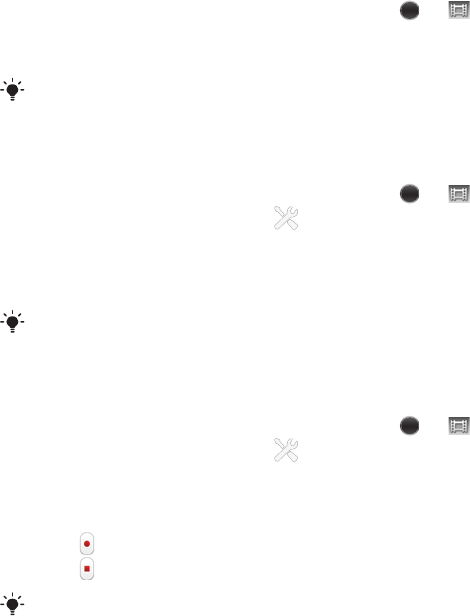
Tips on using the camera
Rule of thirds
Don’t place your subject in the middle of the frame. By placing it a third of the way in,
you achieve a better result.
Hold it steady
Avoid blurry photos by holding the camera steady. Try to steady your hand by leaning
it against a solid object.
Get closer
By getting as close as possible to your subject, you can fill the camera screen view
with your subject.
Consider variety
Think about different angles, and move towards the subject. Take some vertical
photos. Try different positions.
Use a plain background
A plain background helps highlight your subject.
Keep your lens clean
Mobile phones are used in all kinds of weather and places, and carried in pockets
and bags. This results in the camera lens becoming dirty and covered with
fingerprints. Use a soft cloth to clean the lens.
Using the video camera
To record a video using the camera key
1Activate the camera.
2If the video camera is not selected, drag to .
3To start recording a video, press the camera key.
4To stop recording, press the camera key again.
Shoot your videos in landscape orientation to get the best results.
To record a video by tapping the screen
1Activate the camera.
2If the video camera is not selected, drag to .
3To display all settings, tap .
4Tap Capturing method > Touch capture if it is not already selected.
5Tap the camera screen to start recording.
6Tap the camera screen to stop recording.
Shoot your videos in landscape orientation to get the best results.
To record a video by tapping the on-screen button
1Activate the camera.
2If the video camera is not selected, drag to .
3To display all settings, tap .
4Tap Capturing method, then select On-screen button if it is not already
selected.
5Point the camera towards the subject.
6Tap to start recording.
7Tap to stop recording.
Shoot your videos in landscape orientation to get the best results.
97
This is an Internet version of this publication. © Print only for private use.

To play recorded videos
1Activate the camera.
2If the video camera is not selected, drag to .
3Tap the thumbnails on the bottom of the screen.
4Flick left or right to browse all photo and video files. Videos are identified by
.
5Tap to play a video.
6To stop playing the video, tap or .
You can also flick the thumbnails from right to left to find the file that you want to play.
To delete a recorded video
1Browse to the video that you want to delete.
2Tap .
Using video camera settings
To adjust video camera settings
1Activate the camera.
2If the video camera is not selected, drag to .
3Tap one of the settings icons on the left of the screen.
4To display all settings, tap .
5Select the setting you want to adjust, then make your changes.
To customise the video camera settings panel
1When the video camera is open, tap to display all settings.
2Touch and hold the setting that you want to move, then drag it to the desired
position.
If you drag the setting outside of the settings panel, the change is cancelled.
Video camera settings overview
Scenes
The Scenes feature helps you to quickly set up the camera for common situations
using pre-programmed scenes. The camera determines a number of settings for you
to fit the selected scene, ensuring the best possible video.
Off
The Scenes feature is off and you can shoot videos manually.
Portrait
Use for portrait videos. Settings are optimised to give slightly softer skin tones.
Landscape
Use for videos of landscapes. The camera focuses on distant objects. When Landscape is
selected, focus mode is changed to Single auto focus.
Night
When turned on, light sensitivity is increased. Use in poorly lit environments. Videos of fast-moving
objects may get blurred. Hold your hand steady, or use a support. Turn off night mode when
lighting conditions are good, to improve the video quality.
Beach and snow
Use in bright environments to avoid underexposed videos.
Sports
Use for videos of fast-moving objects. Short exposure time minimises motion blurring.
Party
Use for indoor videos in poorly lit environments. This scene picks up indoor background lighting or
candlelight. Videos of fast-moving objects may get blurred. Hold your hand steady, or use a
support.
98
This is an Internet version of this publication. © Print only for private use.

Photo light
Use the light to record videos when lighting conditions are poor or when there is a
backlight.
On
Off
Sometimes the video quality can be better without a light, even if lighting conditions are poor.
Capturing method
Select the method you use to record a video.
On-screen button
Record a video by using the on-screen button on the camera screen.
Touch capture
Identify a particular focus area by touching the camera screen with your finger.
Camera key only
Record a video by using only the hardware camera key.
Focus mode
The focus setting controls which part of a video should be sharp. When continuous
autofocus is on, the camera keeps adjusting focus so that the area within the white
focus frame stays sharp.
Single auto focus
The camera automatically focuses on the selected subject. Continuous autofocus is on.
Face detection
The camera automatically detects up to five human faces, indicated by frames on the screen. The
camera automatically focuses on the nearest face. You can also select which face to focus on by
tapping it on the screen. When you tap the camera screen, a green frame shows which face is
selected and in focus. Face detection cannot be used for all scene types. Continuous autofocus is
on.
Video resolution
Adjust the video resolution for different formats.
Full HD
Full HD (Full High Definition) format with 16:9 aspect ratio. 1920×1080 pixels.
HD 720p
HD (High Definition) format with 16:9 aspect ratio. 1280×720 pixels.
VGA
VGA format with 4:3 aspect ratio. 640x480 pixels.
Multimedia message
Record videos suitable for sending in multimedia messages. The recording time of this video
format is limited to fit in a multimedia message.
Self-timer
With the self-timer you can record a video without holding the phone. Use it to record
group videos where everyone can be in the video. You can also use the self-timer to
avoid shaking the camera when recording videos.
On (10 s.)
Set a 10-second delay from when you tap the camera screen until the video begins to record.
On (2 s.)
Set a 2-second delay from when you tap the camera screen until the video begins to record.
Off
The video begins to record as soon as you tap the camera screen.
99
This is an Internet version of this publication. © Print only for private use.

Exposure value
This setting allows you to determine the amount of light in the image you capture. A higher value
indicates an increased amount of light.
White balance
The white balance setting adjusts the colour balance according to the lighting
conditions.
Auto
Adjust the colour balance automatically to the lighting conditions.
Incandescent
Adjusts the colour balance for warm lighting conditions, such as under light bulbs.
Fluorescent
Adjust the colour balance for fluorescent lighting.
Daylight
Adjust the colour balance for sunny outdoor conditions.
Cloudy
Adjust the colour balance for a cloudy sky.
Image stabiliser
When recording a video, it can be difficult to hold the phone steady. The stabiliser
helps you by compensating for small movements of the hand.
Microphone
Select whether to pick up the surrounding sound when recording videos.
Shutter sound
Choose to turn on or turn off the shutter sound when you record a video.
100
This is an Internet version of this publication. © Print only for private use.

Viewing photos and videos in Album
Use Album to view photos and play videos that you’ve taken with your phone
camera, or to view similar content that you've downloaded or copied to the memory
card. You can add geotags to your photos and videos, and then view them on a
world map. In Album, you can also view photos and videos that you've uploaded to
an online service, for example, to a Picasa™ web album or to Facebook™.
From Album, you can also share your favorite photos and videos with friends via
using Bluetooth™ wireless technology, email, messaging and various online services.
And you can perform basic editing tasks on photos and set them as wallpaper or
contact pictures. For more information, see Connecting your phone to a computer on
page 115.
Album tab overview
The following tabs are available in Album:
•Pictures – view all photos and videos saved to the memory card.
•Maps – view your geotagged photos and video clips on a world map.
•Online – view your online albums.
Mobile BRAVIA® Engine
Sony's Mobile BRAVIA® Engine technology improves the viewing quality of photos
and videos after you take them, giving you clearer, sharper and more natural images.
Mobile BRAVIA Engine is turned on by default, but you can turn it off if you want to
reduce battery consumption.
To turn off Mobile BRAVIA® Engine
1From your Home screen, tap .
2Find and tap Settings > Display.
3Unmark the Mobile BRAVIA Engine checkbox if it is already marked.
To open Album
1From your Home screen, tap .
2Find and tap Album.
If the screen orientation does not change automatically when you turn the phone sideways,
mark the Auto-rotate screen checkbox under Settings > Display.
Viewing photos and videos saved in the phone
In the grid view of the Pictures tab in Album, you can view the thumbnails of photos
and videos. You can also go to the list view of all albums and find content in each
folder.
101
This is an Internet version of this publication. © Print only for private use.
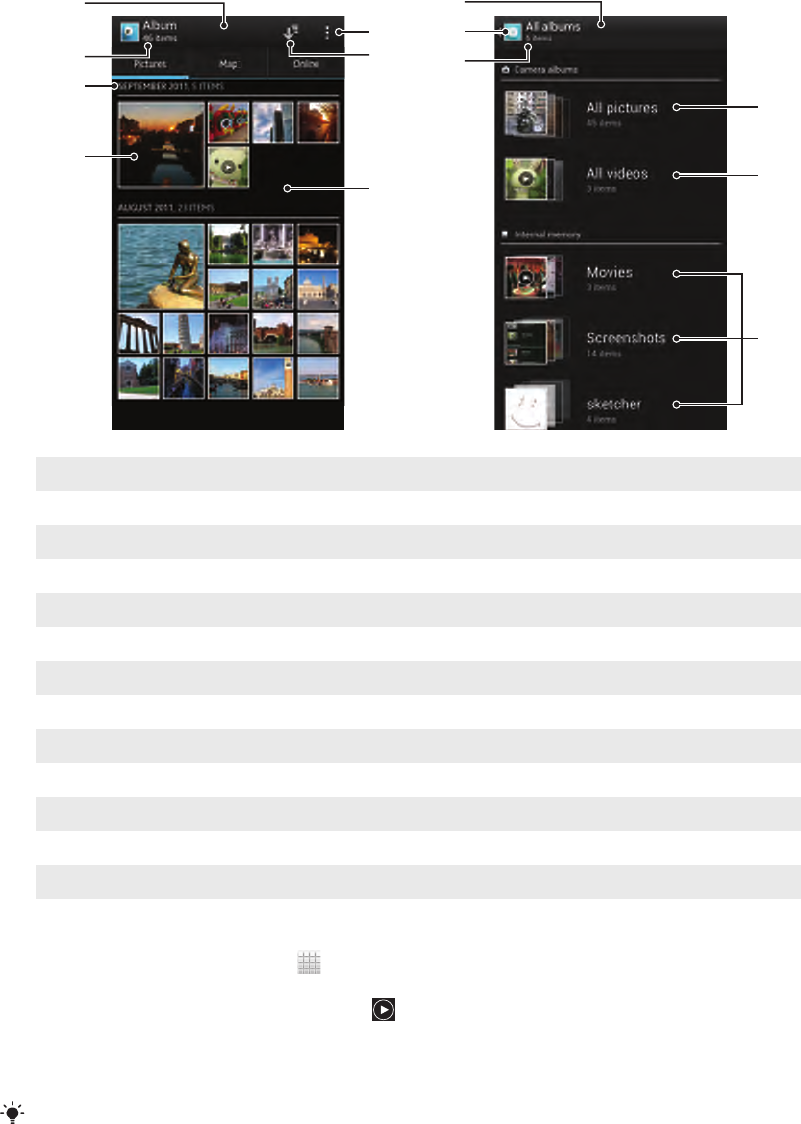
Overview of Pictures tab
7
6
5
1
2
3
4
11
12
13
8
9
10
1 Grid view of photos and videos.
2 Total number of photos and videos.
3 The date and number of items in the group below.
4 Tap a photo or video to view it.
5 Scroll up or down to view content.
6 Switch to a list view of all folders containing pictures and videos saved on your phone.
7 View menu options.
8 List view of all folders containing pictures and videos saved on your phone.
9 Tap to return to grid view in the Pictures tab.
10 The number of the folders containing pictures and videos.
11 Folder containing all pictures taken with your phone camera.
12 Folder containing all videos taken with your phone camera.
13 All other folders containing pictures and/or videos that you've downloaded or copied to your phone.
To view photos and videos in grid view
1From your Home screen, tap .
2Find and tap Album. All photos and videos are displayed in a chronologically
ordered grid. Videos are indicated by .
3Tap a photo or video to view it.
4Flick left to view the next photo or video. Flick right to view the previous photo
or video.
If the screen orientation does not change automatically when you turn the phone sideways,
mark the Auto-rotate screen checkbox under Settings > Display.
102
This is an Internet version of this publication. © Print only for private use.

To view photos and videos in list view
1From your Home screen, tap .
2Find and tap Album > Pictures.
3Tap . Folders containing photos and videos shot using the phone camera are
displayed at the top. All other folders containing pictures and videos saved on
your phone are displayed in an alphabetical list.
4Tap a folder you want to open. The folder's content appears in a
chronologically ordered grid. Videos are indicated by .
5Tap a photo or video to view it.
6Flick left to view the next photo or video. Flick right to view the previous photo
or video.
If the screen orientation does not change automatically when you turn the phone sideways,
mark the Auto-rotate screen checkbox under Settings > Display.
To change the size of the thumbnails in Album
•When viewing thumbnails of photos and videos in Album, spread two fingers
apart to zoom in, or pinch two fingers together to zoom out.
To work with batches of photos or videos in Album
1When viewing thumbnails of photos and videos in Album, press and tap
Select items to activate selection mode.
2Tap the items you want to work with. Selected items are indicated by a blue
frame.
3Use the tools in the toolbar at the top of the screen to work with your selected
items.
To activate selection mode, you can also touch and hold an item until its frame turns blue.
Then you can tap other items to select them.
Working with photos in Album
You can edit photos in Album. For example, you can crop photos, associate them
with contacts, or use them as wallpaper.
To zoom a photo
•When you are viewing a photo, double-tap the screen to zoom in. Double-tap again
to zoom out.
•When you are viewing a photo, spread two fingers apart to zoom in, or pinch two
fingers together to zoom out.
To watch a slideshow of your photos
1When you are viewing a photo, press and tap Slide show to start playing all
the photos in an album.
2Tap a photo to end the slideshow.
To rotate a photo
1When you are viewing a photo, press .
2Select Rotate left or Rotate right. The photo is saved in the new orientation.
To crop a photo
1When you are viewing a photo, press , then tap Crop.
2To adjust the crop frame, touch and hold the edge of the crop frame. When the
squares at the edges disappear, drag inward or outward to resize the frame.
3To resize all sides of the crop frame at the same time, touch and hold one of
the four corners to make the squares at the edges disappear, then drag the
corner accordingly.
4To move the crop frame to another area of the photo, touch and hold inside the
frame, then drag it to the desired position.
5To save a copy of the photo as you cropped it, tap Crop. The original
uncropped version remains on your phone's memory card.
103
This is an Internet version of this publication. © Print only for private use.

To use a photo as a contact picture
1When you are viewing a photo, press , then tap Use as > Contact picture.
2Select the contact you want to associate with the photo.
3Crop the photo, if required.
4Tap Crop.
To use a photo as wallpaper
1When you are viewing a photo, press , then tap Use as > Wallpaper.
2Crop the photo, if required.
3Tap Crop.
To edit a photo
•When you are viewing a photo, press , then tap Edit photo.
To share a photo
1When you are viewing a photo, tap the screen to display the toolbars, then tap
.
2In the menu that opens, tap the application that you want to use to share the
photo, then follow the steps to send it.
To add a geotag to a photo
1When you are viewing a photo, tap the screen to display the toolbars, then tap
to open the map screen.
2Find and tap the desired location to put the photo on the map.
3To adjust the location of the photo, tap the location on the map to where you
want to move the photo.
4When you are finished, tap OK to save the geotag and return to the photo
viewer.
When a photo is geotagged, appears along with location information. You can tap this
icon to view the photo on a map.
To delete a photo
1When you are viewing a photo, tap the screen to display the toolbars, then tap
.
2Tap OK.
Working with videos in Album
Use Album to watch videos that you’ve taken with the camera, downloaded, or
copied to your memory card. You can also share your videos with friends, or upload
them to YouTube™.
To play a video
1Open the Pictures tab in Album.
2Using grid view or list view, locate the video that you want to open.
3Tap the video to play it.
4If the playback controls are not displayed, tap the screen to display them. To
hide the controls, tap the screen again.
To pause a video
1When a video is playing, tap the screen to display the controls.
2Tap .
To fast forward and rewind a video
1When a video is playing, tap the screen to display the controls.
2Drag the progress bar marker left to rewind, or right to fast forward.
To adjust the volume of a video
•Press the volume key.
104
This is an Internet version of this publication. © Print only for private use.
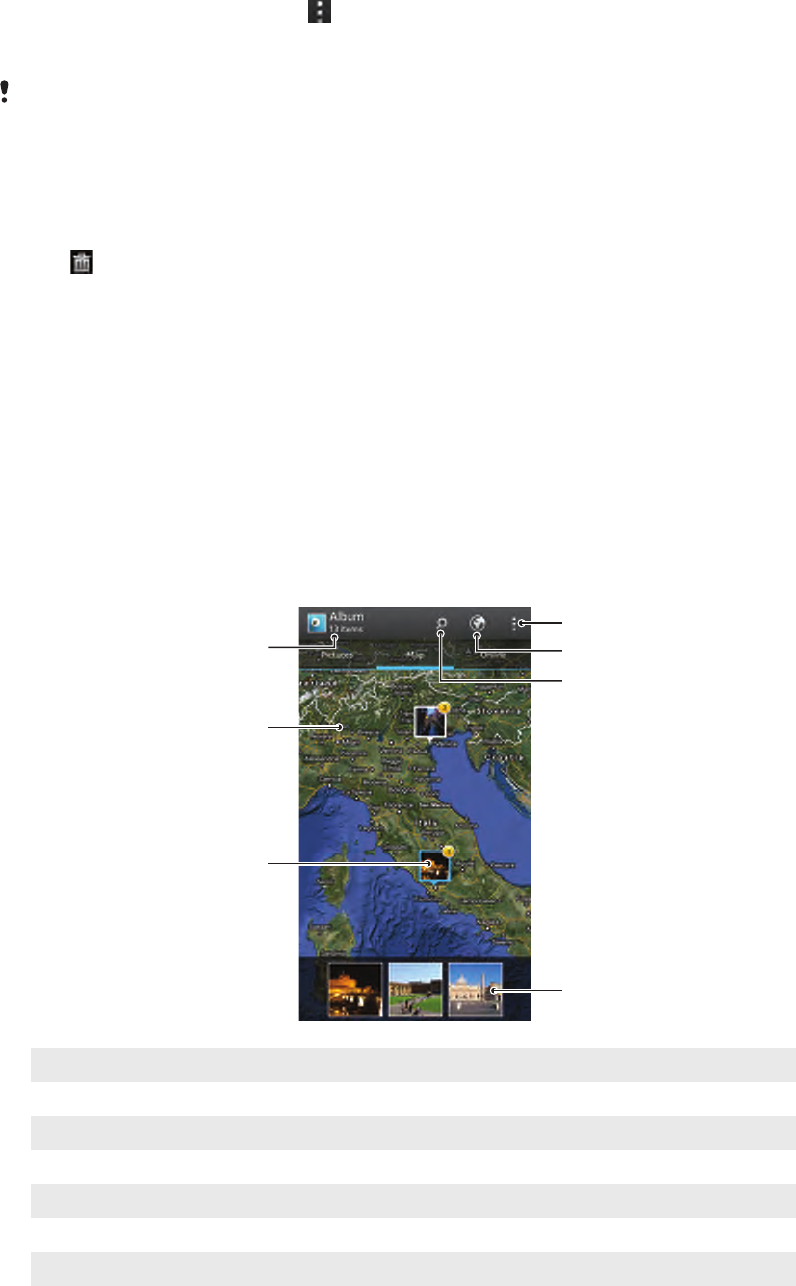
To share a video
1When a video is playing, press , then tap Share.
2In the menu that opens, tap the application that you want to use to share the
selected video, then follow the relevant steps to send it.
You might not be able to copy, send or transfer copyright-protected items. Also, some items
may not send if the file size is too large.
To delete a video
1In Album, find the video you want to delete.
2Touch and hold the video to activate selection mode. The frame of the video
thumbnail turns blue when it is selected.
3Tap , then tap OK.
Viewing your photos on a map
If you enable location detection when taking photos, you can use the information
gathered at a later stage. For example, you can view your photos on a map and show
friends and family where you were when you took the photo. Adding location
information is also referred to as geotagging. When you enable location detection,
you can select to use either GPS satellites or wireless networks, or both, to find your
position.
For more information, see Using location services to find your position on page 118.
Overview of Maps tab
1
2
3
4
5
7
6
1The number of geotagged photos and videos.
2 Double tap to zoom in. Pinch to zoom out. Drag to view different parts of the map.
3 A group of photos and/or videos geotagged with the same location.
4 Thumbnails of the selected group of photos and/or videos. Tap an item to view it in full screen.
5 Search a location on the map.
6 Switch to globe view.
7 View menu options.
To enable location detection
105
This is an Internet version of this publication. © Print only for private use.
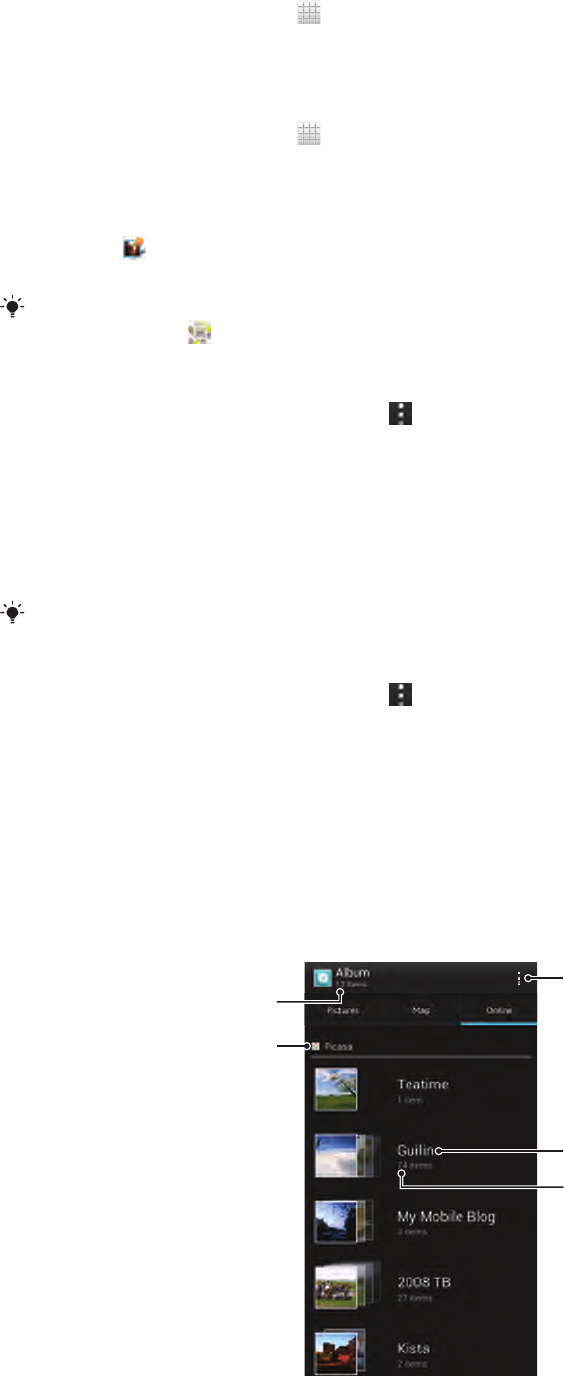
1From your Home screen, tap .
2Find and tap Settings > Location services.
3Mark the GPS satellites and/or Google's location service checkboxes.
To view geotagged photos on a map in Album
1From your Home screen, tap .
2Find and tap Album > Maps.
3Tap a photo to view it in full screen.
4If several photos were taken at the same location, only one of them appears on
the map. The total number of photos appears in the top right corner, for
example, . To view these photos, tap the cover photo and then tap one of
the thumbnails at the bottom of the screen.
When viewing a geotagged photo in the photo viewer, you can touch the screen to display the
toolbars, then tap to view the photo on the map.
To add a geotag when viewing the map in Album
1When viewing the map in Album, press , then tap Add geotag.
2Find and tap the photo to which you want to add the geotag.
3Tap the desired location on the map to set the geotag, then tap OK.
To edit the geotag of a photo in Album
1When viewing a photo on the map in Album, touch and hold the photo until its
frame turns blue.
2Drag the photo to the new location.
You can also tap the desired location on the map instead of dragging.
To change the map view in Album
•When viewing the map in Album, press , then select Classic view or Satellite view.
Viewing your online albums
In Album, you can view the photos and videos you've uploaded to online services,
such as Picasa™ and Facebook™. View comments from your friends and add your
own comments as well. You can also recommend or "Like" a photo when you view
your albums in Facebook™.
Overview of Online tab
1
2
3
4
5
106
This is an Internet version of this publication. © Print only for private use.

1 Number of available online albums.
2 Active online service.
3 Name of an online album.
4 Number of items in the online album.
5 View menu options.
To view photos from online services in Album
1Make sure you are signed in to the relevant online service, for example,
Facebook™.
2From your Home screen, tap .
3Find and tap Album > Online. All your available online albums are displayed.
4Tap any album to view its contents, then tap a photo in the album.
5In the photo viewer, flick left to view the next photo or video. Flick right to view
the previous photo or video.
To view and add comments to online album content
1When viewing a photo from an online album, tap the screen to display the
toolbars, then tap to view the comments.
2To view more comments, scroll down the screen.
3To add your own comments, enter your comments at the bottom of the screen,
then tap Post.
To recommend a photo or video on Facebook™
•While viewing a photo or video from one of your Facebook™ albums, tap the
screen to display the toolbars, then tap to show that you "Like" the item on
Facebook™.
107
This is an Internet version of this publication. © Print only for private use.

Playing video clips in Movies
Use the Movies application to play movies that you’ve copied or downloaded to your
phone. Movies also helps you get poster art, plot summaries, genre info and director
details for each movie. You can share your favourite movies with friends, for example,
via Bluetooth™ wireless technology or via online services. You can also play your
movies on other devices that are connected to the same network.
Video clips taken with your phone camera are displayed in Album, not in Movies. For more
information, see Viewing photos and videos in Album on page 101.
To play video clips in Movies
1From your Home screen, tap .
2Find and tap Movies. All movies are displayed in a grid.
3Tap the movie you want to select, then tap to play it.
4To display or hide the controls, tap the screen.
5To pause the movie, tap .
6To rewind the movie, drag the progress bar marker left. To fast forward the
movie, drag the progress bar marker right.
To play a movie in full screen
1When a movie is playing, tap the screen to display the controls.
2Tap .
To play the movie in its original size, tap .
To share a movie
1When a movie is playing, press , then tap Share.
2In the menu that opens, tap the application that you want to use to share the
selected video, then follow the relevant steps to send it.
To get movie information manually
1From your Home screen, tap .
2Find and tap Movies. All movies are displayed in a grid.
3Press , then make sure that the Online mode checkbox is marked and that
your phone has a data connection.
4Touch and hold the movie for which you want to get information, then tap
Search for info in the list that appears.
5In the search field, enter keywords for the movie, then tap . All matches are
displayed in a list.
6Tap the result you want, then tap Done. The download of the information
begins.
7When the download is finished, tap the movie to view its information. If the
information is not correct, tap and search again.
Data transmission charges may apply.
To clear the information for a movie
1From your Home screen, tap .
2Find and tap Movies. All movies are displayed in a grid.
3Touch and hold the desired movie, then tap Clear info from the list that
appears.
Playing your videos on other DLNA Certified™ devices
Using DLNA, you can share video files with another device on the same Wi-Fi®
network, such as a PC or a TV. This device must be able to function as a DLNA
108
This is an Internet version of this publication. © Print only for private use.

renderer, which means that it has a DLNA tag. If the device is a PC, it must run
Windows® 7 or higher.
The instructions described above may differ depending on the DLNA renderer used. Also refer
to the user guide for the respective device for more detailed information.
To play a video on another DLNA Certified™ devices
1Make sure that your phone and the other device are connected to the same
Wi-Fi® network.
2If the renderer device is a PC running on Windows® 7, open the Windows
Media Player, and make sure that the selected network type is Home network.
Then click Stream and enable the Allow remote control of my Player and
Automatically allow devices to play my media options.
3From your Home screen, tap , then find and tap Movies.
4Tap the video you want to play, then tap .
5Select the device that you want to share with. The video starts to play
automatically on the device that you have selected.
109
This is an Internet version of this publication. © Print only for private use.

Sharing content with DLNA Certified™
devices
You can view or play media content saved in your phone on other devices such as,
for example, a TV, a PlayStation®3, a computer, or a tablet. Such devices must be
DLNA Certified™ by the Digital Living Network Alliance and must be connected to the
same Wi-Fi® network as your phone in order for content to be shared. You can also
view or play content from other DLNA Certified™ devices on your phone.
After you set up the sharing of content between devices, you can, for example, print
files from your phone on a printer, listen to music files stored on your home computer
from your phone, or view photos taken with your phone camera on a large-screen TV.
Playing files from DLNA Certified™ devices on your phone
When you play files from another DLNA Certified™ device on your phone, this other
device acts as a server. In other words, it shares content over a network. The server
device must have its content sharing function enabled and must be connected to the
same Wi-Fi network as your phone. All server devices connected to the Wi-Fi
network are displayed in the Server list on your phone.
To play a shared media file on your phone
1Make sure the devices that you want to share files with are connected to the
same Wi-Fi® network as your phone.
2From your Home screen, tap , then find and tap Connected devices.
3Select a connected device under Server list.
4Browse the folders of the connected device and select the media file that you
want to open. The file starts playing automatically.
Preparing to play phone content on DLNA Certified™ devices
Before you can view or play media files from your phone on other DLNA Certified™
devices, you must set up file sharing on your phone. The devices you share content
with are called client devices. For example, a TV, computer or tablet can act as client
devices. Your phone works as a media server when it makes content available to
client devices. When you set up file sharing on your phone, you must also give
access permission to client devices. After you do so, such devices appear as
registered devices. Devices that are waiting for access permission are listed as
pending devices.
To set up file sharing with other DLNA Certified™ devices
1Connect your phone to a Wi-Fi® network.
2From your Home screen, tap , then find and tap Connected devices.
3Press , then tap Media server.
4Tap Change server name and edit your phone name, if desired. This name will
later appear on other client devices connected to the Wi-Fi network to identify
your phone.
5To turn on the Share content function, drag the slider. appears in the status
bar. Your phone can now work as a media server.
6Connect your computer or other devices to the same Wi-Fi® network as your
phone.
7A notification appears in the status bar of the phone. Open the notification and
set the relevant access permissions for other devices.
The instructions described above may differ depending on the client devices used. Refer to
your client device User guide for more information. If the device cannot connect, check that
your Wi-Fi network is working.
If you close the Connected devices view, the Media server function stays running in the
background.
110
This is an Internet version of this publication. © Print only for private use.

To stop sharing files with other DLNA Certified™ devices
1From your Home screen, tap , then find and tap Connected devices.
2Press , then tap Media server.
3Drag the slider to turn off the Share content function.
To set access permissions for a pending device
1From your Home screen, tap , then find and tap Connected devices.
2Press , then tap Media server.
3Select a device from the Pending devices list.
4Select an access permission level.
To change the name of a registered device
1From your Home screen, tap , then find and tap Connected devices.
2Press , then tap Media server.
3Select a device from the Registered devices list, then select Change server
name.
4Enter a new name for the device.
To change the access level of a registered device
1From your Home screen, tap , then find and tap Connected devices.
2Press , then tap Media server.
3Select a device from the Registered devices list.
4Tap Change access level and select an option.
To get help about sharing content with other DLNA Certified™ devices
1From your Home screen, tap , then find and tap Connected devices.
2Tap .
Playing phone content on other DLNA Certified™ devices
To view photos or videos from your phone on another device
1Make sure that you have correctly set up file sharing with other DLNA
Certified™ devices and that all relevant devices are connected to the same Wi-
Fi® network.
2From your Home screen, tap .
3Find and tap Album.
4Touch and hold any photo or video until a toolbar appears.
5Tap the item or items that you want to view, then tap > .
6Select a device. The selected files start playing in chronological order on the
device that you select.
You can also share a video from the Movies application on your phone by tapping the video
and then tapping .
To play a music track from your phone on another device
1Make sure that you have correctly set up file sharing with other DLNA
Certified™ devices and that all relevant devices are connected to the same Wi-
Fi® network.
2From your Home screen, tap , then find and tap .
3Tap MY MUSIC to open the music library.
4Select a music category and browse to the track that you want to share, then
tap the track.
5Press , then tap Play on device.
6Select a device. The track plays automatically on the device that you select.
111
This is an Internet version of this publication. © Print only for private use.

Bluetooth™ wireless technology
Use the Bluetooth™ function to send files to other Bluetooth™ compatible devices,
or to connect to handsfree accessories. Turn on the Bluetooth™ function in your
phone and create wireless connections to other Bluetooth™ compatible devices such
as computers, handsfree accessories, and phones. Bluetooth™ connections work
better within a 10 meter (33 foot) range, with no solid objects in between. In some
cases you have to manually pair your phone with other Bluetooth™ devices.
Remember to set your phone to "discoverable" if you want other Bluetooth™ devices
to detect it.
Interoperability and compatibility among Bluetooth™ devices can vary.
To turn on the Bluetooth™ function and make your phone visible
1From your Home screen, tap .
2Find and tap Settings.
3Tap the on-off switch beside Bluetooth to turn on the Bluetooth™ function.
4Tap Bluetooth. Your phone and a list of available Bluetooth™ devices appear.
5Tap your phone name to make your phone visible to other Bluetooth™
devices.
To adjust your phone's visibility time to other Bluetooth™ devices
1From your Home screen, tap .
2Find and tap Settings > Bluetooth.
3Press and select Visibility timeout.
4Select an option.
Naming your phone
You can give your phone a name. This name is shown to other devices after you have
turned on the Bluetooth™ function and your phone is set to visible.
To give your phone a name
1Make sure that the Bluetooth™ function is turned on.
2From your Home screen, tap .
3Find and tap Settings > Bluetooth.
4Press and select Rename phone.
5Enter a name for your phone.
6Tap Rename.
Pairing with another Bluetooth™ device
When you pair your phone with another device, you can, for example, connect your
phone to a Bluetooth™ handsfree or a Bluetooth™ car kit and use these devices to
make and receive calls.
Once you have paired your phone with a Bluetooth™ device the phone will remember
this pairing. When pairing the phone with a Bluetooth™ device, you may need to
enter a passcode. Your phone will automatically try the generic passcode 0000. If this
does not work, refer to your Bluetooth™ device documentation for the device
passcode. You do not need to re-enter the passcode the next time you connect to a
paired Bluetooth™ device.
Some Bluetooth™ devices, for example, most Bluetooth™ headsets, require you to
both pair and connect with the other device.
You can pair your phone with several Bluetooth™ devices, but you can only connect
to one Bluetooth™ profile at the same time.
112
This is an Internet version of this publication. © Print only for private use.

To pair your phone with another Bluetooth™ device
1Make sure that the device you want to pair your phone with has the
Bluetooth™ function activated and is visible to other Bluetooth™ devices.
2From the Home screen, tap .
3Find and tap Settings > Bluetooth. All available Bluetooth™ devices appear in
a list.
4Tap the Bluetooth™ device that you want to pair with your phone.
5Enter a passcode, if required. The phone and the Bluetooth™ device are now
paired.
To connect your phone to another Bluetooth™ device
1If you are connecting to a Bluetooth device that requires you to first pair your
phone before connecting, follow the relevant steps to pair your phone with that
device.
2From your Home screen, tap .
3Find and tap Settings > Bluetooth.
4Tap the Bluetooth™ device to which you want to connect your phone.
To unpair a Bluetooth™ device
1From the Home screen, tap .
2Find and tap Settings > Bluetooth.
3Under Paired devices, tap beside the name of the device that you want to
unpair.
4Tap Unpair.
Sending and receiving items using Bluetooth™ technology
Share items with other Bluetooth™ compatible devices such as phones or
computers. You can send and receive several kinds of items using the Bluetooth™
function, such as:
•Photos and videos
•Music and other audio files
•Contacts
•Web pages
To send items using Bluetooth™
1Receiving device: Make sure the Bluetooth™ device that you want to send the
item to has Bluetooth™ turned on and is visible to other Bluetooth™ devices.
2In the sending device, open the application which contains the item you want
to send and scroll to the item.
3Depending on the application and the item you want to send, you may need to,
for example, touch and hold the item, open the item or press . Other ways to
send an item may exist.
4Select a share or send menu item.
5In the menu that appears, select Bluetooth.
6Turn on Bluetooth™, if you are asked to do so.
7Tap the name of the receiving device.
8Receiving device: If asked, accept the connection.
9If asked, enter the same passcode on both devices, or confirm the suggested
passcode.
10 Receiving device: Accept the incoming item.
113
This is an Internet version of this publication. © Print only for private use.

To receive items using Bluetooth™
1Make sure there is a memory card in your phone. If you don't have a memory
card inserted, you cannot send or receive items using Bluetooth wireless
technology.
2From your Home screen, tap .
3Make sure that the Bluetooth™ function is on and is visible to other
Bluetooth™ devices.
4The sending device now starts sending data to your phone.
5If prompted, enter the same passcode on both devices, or confirm the
suggested passcode.
6When you are notified of an incoming file to your phone, drag the status bar
downwards and tap the notification to accept the file transfer.
7Tap Accept to start the file transfer.
8To view the progress of the transfer, drag the status bar downwards.
9To open a received item, drag the status bar downwards and tap the relevant
notification.
To view files you have received using Bluetooth™
1From your Home screen, tap .
2Find and tap Settings > Bluetooth.
3Press and select Show received files.
114
This is an Internet version of this publication. © Print only for private use.

Connecting your phone to a computer
Connect your phone to a computer and start transferring pictures, music and other
file types. The easiest ways to connect are using a USB cable or Bluetooth wireless
technology.
When you connect your phone to the computer using a USB cable, you are prompted
to install the PC Companion application on your computer. PC Companion helps you
access additional computer applications to transfer and organise media files, update
your phone, synchronise phone content, and more.
You might not be able to transfer some copyright-protected material between your phone and
computer.
Transferring and handling content using a USB cable
Use a USB cable connection between a computer and your phone for easy transfer
and management of your files. Once the two devices are connected, you can drag
and drop content between your phone and the computer, or between your phone's
internal storage and SD card, using the computer's file explorer.
If you're transferring music, video, pictures or other media files to your phone, it's
best to use the Media Go™ application on your computer. Media Go™ converts
media files so that you can use them on your phone.
To transfer content between a phone and computer using a USB cable To transfer
content between a computer and phone internal storage
1Using a USB cable, connect your phone to a computer. Int. storage & SD card
connected appears in the status bar.
2Computer: Open Microsoft® Windows® Explorer from the desktop and wait
until your phone's internal storage and SD card appear as external disks in
Microsoft® Windows® Explorer.
3Computer: Drag and drop the desired files between your phone and the
computer.
To transfer content between internal storage and an SD card via USB
1Using a USB cable, connect your phone to a computer. Int. storage & SD card
connected appears in the status bar on your phone screen.
2Computer: Open Microsoft® Windows® Explorer from the desktop and wait
until your phone's internal storage and your SD card appear as external disks
in Microsoft® Windows® Explorer.
3Computer: Drag and drop the desired files between the phone's internal
storage and the SD card.
Transferring files using Media transfer mode via Wi-Fi®
You can transfer files between your phone and other MTP compatible devices, such
as a computer, using a Wi-Fi® connection. Before connecting, you first need to pair
the two devices. If you're transferring music, video, pictures or other media files
between your phone and a computer, it's best to use the Media Go™ application on
the computer. Media Go™ converts media files so that you can use them on your
phone.
In order to use this feature, you need a Wi-Fi® enabled device that supports Media transfer,
for example, a computer running Microsoft® Windows Vista® or Windows® 7.
115
This is an Internet version of this publication. © Print only for private use.

To pair your phone wirelessly with a computer using Media transfer mode
1Make sure Media transfer mode is enabled on your phone. It is normally
enabled by default.
2Connect your phone to the computer using a USB cable.
3Computer: Once the phone name appears on the screen, click Network
configuration and follow the instructions to pair the computer.
4When you are finished pairing, disconnect the USB cable from both devices.
The above instructions only work if Windows® 7 is installed on your computer and the
computer is connected to a Wi-Fi® Access Point via a network cable.
To connect paired devices wirelessly in Media transfer mode
1Make sure Media transfer mode is enabled on your phone. It is normally
enabled by default.
2From your Home screen, tap .
3Find and tap Settings > Xperia™ > Connectivity.
4Tap the paired device that you want to connect to under Trusted devices.
5Tap Connect.
Make sure your phone's Wi-Fi® function is turned on.
To disconnect a wirelessly paired device in Media transfer mode
1From your Home screen, tap .
2Find and tap Settings > Xperia™ > Connectivity.
3Tap the paired device that you want to disconnect from under Trusted
devices.
4Tap Disconnect.
To remove a pairing with another device
1From your Home screen, tap .
2Find and tap Settings > Xperia™ > Connectivity.
3Tap the paired device that you want to remove.
4Tap Forget.
Media Go™
The Media Go™ computer application helps you transfer and manage media content
in your phone and computer.
You need one of these operating systems to use the Media Go™ application:
•Microsoft® Windows® 7
•Microsoft® Windows Vista®
•Microsoft® Windows® XP, Service Pack 3 or higher
To transfer content using the Media Go™ application
1Using a USB cable, connect your phone to a computer. Int. storage & SD card
connected appears in the status bar on your phone.
2Computer: Open the PC Companion application. In PC Companion, click
Media Go to start the Media Go™ application. In some cases, you may have to
wait for Media Go™ to install.
3Using Media Go™, drag and drop the desired files between your computer and
phone.
Media Go™ can also be downloaded from www.sonymobile.com.
116
This is an Internet version of this publication. © Print only for private use.

Connecting your phone to a TV set
Connect your phone to a TV set and start viewing content saved in your phone on a
larger screen. When you connect your phone to the TV set, the TV launcher
application opens. This application helps you to play media files from your phone on
TVs and other devices.
To view phone content on a TV which supports MHL™ input
1Connect your phone to the TV using an MHL cable. appears in your phone's
status bar after a connection is established.
2The TV launcher application starts automatically. Follow the instructions on
your phone screen to view your media files on the TV.
To view phone content on a TV which supports HDMI™ input
1Connect your phone to an MHL-HDMI adaptor, and connect the adaptor to a
USB power supply.
2Connect the adaptor to a TV using a HDMI™ cable. appears in your
phone's status bar after a connection is established.
3The TV launcher application starts automatically. Follow the instructions on
your phone screen to view your media files on the TV.
To view help about using the TV remote control
1While your phone is connected to the TV set, drag the status bar downwards to
open the Notification panel.
2Tap MHL connected.
You can also press the yellow button on the TV remote control to open the Notification panel.
To disconnect your phone from the TV set
•Disconnect the MHL™ cable or the MHL-HDMI adaptor from your phone.
117
This is an Internet version of this publication. © Print only for private use.
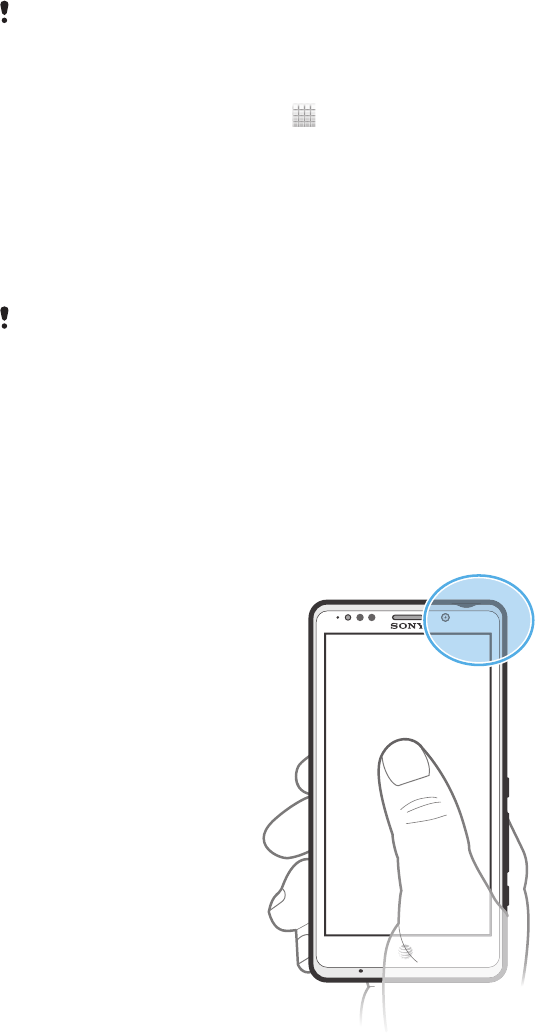
Using location services to find your
position
Use your phone to find out where you are. There are two methods: GPS and wireless
networks. Enable the wireless networks option if you only need your approximate
location, and want it fast. If you want a more exact position, and have a clear view of
the sky, enable the GPS option. In situations where the wireless network connection
is weak, you should enable both options to ensure that your location is found.
Sony does not warrant the accuracy of any location services including but not limited to
navigational services.
To enable GPS
1From your Home screen, tap .
2Tap Settings > Location services.
3Mark the GPS satellites checkbox.
Using GPS
Your phone has a global positioning system (GPS) receiver that uses satellite signals
to calculate your location.
When you use features that require the GPS receiver to find your location, make sure you have
a clear view of the sky.
Getting the best performance
The first time you use the GPS it can take 5 to 10 minutes for your location to be
found. To help the search, make sure you have a clear view of the sky. Stand still and
don't cover the GPS antenna (the highlighted area in the image). The GPS signals can
pass through clouds and plastic, but not through most solid objects such as
buildings and mountains. If your location isn't found after a few minutes, move to
another location.
118
This is an Internet version of this publication. © Print only for private use.

Google Maps™
Track your current location, view real-time traffic situations and receive detailed
directions to your destination. Before taking trips, you can download and save maps
to your memory card to avoid high roaming costs.
The Google Maps™ application requires the use of an Internet connection. You may incur data
connection charges when you connect to the Internet from your phone. Contact your network
operator for more information. The Google Maps™ application may not be available in every
market, country or region.
To use Google Maps™
1From your Home screen, tap .
2Find and tap Maps.
If you want to use Google Maps™, you have to enable one of the location methods available
under Settings > Location services.
To learn more about Google Maps™
•When you use Google Maps™, press , then tap Help.
Viewing your friends’ locations with Google Latitude™
Join Google Latitude™ to view your friends’ locations on maps and share your
location and other information with them.
Using Google Maps™ to get directions
Use the Google Maps™ application to get directions when you travel by foot, public
transportation, or car. You can add a shortcut to a destination on your Home screen
to get quick directions from wherever you are.
When you view a map, you make an Internet connection, and data is transferred to
your phone. So it's a good idea to download and save maps to your phone before
you take a trip. This way, you can avoid high roaming costs.
Sony does not warrant the accuracy of any directional services.
Using the Navigation application
Use the Navigation application in your phone to get turn-by-turn instructions on how
to get places. The directions are both spoken and displayed on the screen.
The Navigation application may not be available in every market.
To start Navigation
1From your Home screen, tap .
2Find and tap Navigation.
119
This is an Internet version of this publication. © Print only for private use.
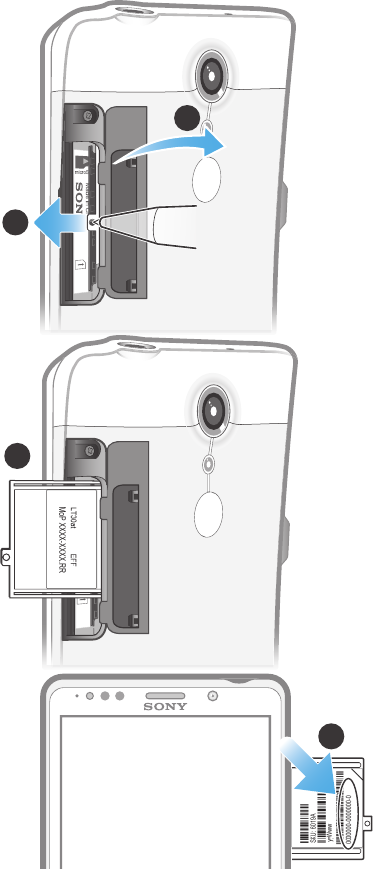
Locking and protecting your phone
IMEI number
Every phone has a unique IMEI (International Mobile Equipment Identity) number. You
should keep a copy of this number. If your phone is stolen, your network provider can
use your IMEI number to stop the phone from accessing the network in your country.
To view your IMEI number
4
1
2
3
1Open the memory card and the micro SIM card cover.
2Insert the tip of a pen or a similar object into the hole, then drag out the tray.
The IMEI number is displayed on the tray.
120
This is an Internet version of this publication. © Print only for private use.

To view the CE mark
1
2
4
3
1Open the memory card and the micro SIM card cover.
2Insert the tip of a pen or a similar object into the hole, then drag out the tray.
3Open the peel & read label to view the CE mark.
To view your IMEI number in the phone
1From your Home screen, tap .
2Find and tap Settings > About phone > Status.
3Scroll to IMEI to view the IMEI number.
SIM card protection
The SIM card lock only protects your subscription. Your phone will still work with a
new SIM card. If the SIM card lock is on, you have to enter a PIN (Personal Identity
Number). If you enter your PIN incorrectly more times than the maximum number of
attempts allowed, your SIM card will become blocked. You need to enter your PUK
121
This is an Internet version of this publication. © Print only for private use.

(Personal Unblocking Key) and then a new PIN. Your PIN, PIN2 and PUK are supplied
by your network operator.
To enable the SIM card PIN lock
1From the Home screen, tap .
2Find and tap Settings > Security > Set up SIM card lock > Lock SIM card.
3Enter the SIM card PIN and tap OK.
To change the SIM card PIN
1From the Home screen, tap .
2Find and tap Settings > Security > Set up SIM card lock > Change SIM PIN.
3Enter the old SIM card PIN and tap OK.
4Enter the new SIM card PIN and tap OK.
5Re-type the new SIM card PIN and tap OK.
To change the SIM card PIN2
1From the Home screen, tap .
2Find and tap Settings > Call settings > Fixed dialling numbers > Change
PIN2.
3Enter the old SIM card PIN2 and tap OK.
4Enter the new SIM card PIN2 and tap OK.
5Confirm the new PIN2 and tap OK.
To unblock a locked SIM card
1When Enter PUK and new PIN code appears, enter the PUK code.
2Enter a new PIN code and tap OK.
If you enter an incorrect PUK code too many times, the SIM card becomes blocked. If this
happens, contact AT&T to get a new SIM card.
Setting a screen lock
There are several ways to lock your phone screen. For example, you can use the
Face Unlock feature, which uses a picture of your face to unlock the screen. You can
also set a screen unlock pattern, a number-based PIN lock, or a text-based
password.
To set a screen lock
1From your Home screen, tap > Settings > Security > Screen lock.
2Select an option.
It is very important that you remember your screen unlock pattern, PIN or password. If you
forget this information, it may not be possible to restore important data such as contacts and
messages. Refer to Sony Customer support for more information.
To set up the Face Unlock protection
1From your Home screen, tap > Settings > Security > Screen lock.
2Tap Face Unlock, then follow the instructions in your phone to capture your
face.
3After your face is successfully captured, set up screen lock Pattern or PIN as a
backup method to unlock the screen. For more information, refer to 'To create
a screen unlock pattern' or 'To create a screen unlock PIN'.
The Face Unlock feature is less secure than a screen lock pattern, PIN, or password. Someone
who looks similar to you could unlock your phone.
For best results, capture your face in an indoor area that is well lit but not too bright and hold
the phone at eye level.
122
This is an Internet version of this publication. © Print only for private use.

To unlock the screen using the Face Unlock feature
1Activate the screen.
2Look at your phone from the same angle you used to capture your Face
Unlock photo.
If Face Unlock fails to recognise your face, you need to draw the backup pattern or PIN to
unlock the screen.
To disable the Face Unlock protection
1From your Home screen, tap > Settings > Security > Screen lock.
2Draw your backup screen unlock pattern or enter your PIN.
3Tap Slide.
To create a screen unlock pattern
1From the Home screen, tap .
2Find and tap Settings > Security > Screen lock > Pattern.
3Follow the instructions in your phone. You are asked to select a security
question that will be used to unlock the phone if you forget your screen unlock
pattern.
To unlock the screen using a screen unlock pattern
1Activate the screen.
2Draw your screen unlock pattern.
If the unlock pattern you draw on the screen is rejected five times in a row, you can select to
either wait 30 seconds and then try again, or to answer the security question you have
selected.
To change the screen unlock pattern
1From your Home screen, tap .
2Find and tap Settings > Security > Screen lock.
3Draw your screen unlock pattern.
4Tap Pattern.
5Follow the instructions in your phone.
To disable the screen unlock pattern
1From your Home screen, tap > Settings > Security > Screen lock.
2Draw the screen unlock pattern.
3Tap None or Slide.
To create a screen unlock PIN
1From your Home screen, tap > Settings > Security > Screen lock > PIN.
2Enter a numeric PIN.
3If necessary, tap to minimise the keyboard.
4Tap Continue.
5Re-enter and confirm your PIN.
6If necessary, tap to minimise the keyboard.
7Tap OK.
To disable the screen unlock PIN
1From your Home screen, tap > Settings > Security > Screen lock.
2Enter your PIN, then tap Next.
3Tap None or Slide.
123
This is an Internet version of this publication. © Print only for private use.

To create a screen lock password
1From your Home screen, tap > Settings > Security > Screen lock >
Password.
2Enter a password.
3If necessary, tap to minimise the keyboard.
4Tap Continue.
5Re-enter and confirm your password.
6If necessary, tap to minimise the keyboard.
7Tap OK.
To disable the screen unlock password
1From your Home screen, tap > Settings > Security > Screen lock.
2Enter your password and tap Next.
3Tap None or Slide.
124
This is an Internet version of this publication. © Print only for private use.

Updating your phone
Update your phone to the most recent software version to get optimal performance
and the latest enhancements.
You can use the Update center application on your phone to run a wireless update or
you can use the PC Companion application on a computer to run an update using a
USB cable connection. If you update wirelessly, then you can use either a mobile
network or a Wi-Fi® network connection. Just make sure you back up and save all
data stored on your phone before you update.
When you run an update using the Update center application, a data connection is established
and related charges may be incurred. Also, the availability of updates over a mobile network
depends on your operator. Contact your network operator for more information.
Updating your phone wirelessly
Use the Update center application to update your phone wirelessly. You can
download software updates manually, or you can allow Update service to update
your phone automatically whenever downloads become available. When the
automatic update feature is activated, a notification appears in the status bar every
time an update becomes available.
To download software updates manually from Update center
1From your Home screen, tap .
2Find and tap Update Centre.
3Select the desired application or system update and tap Download, or tap
Update all to download all application updates.
Application updates launch automatically after download. With system updates, wait for your
phone to restart, then install the update manually. Also, You may incur data connection
charges when downloading updates over 3G/mobile networks.
To activate automatic software updates using the Update Center application
1From your Home screen, tap .
2Find and tap Update Centre.
3Press , then tap Settings.
4Mark the Allow automatic update: checkbox, then tap OK. Updates are now
downloaded automatically as soon as they become available.
You may incur data connection charges when downloading updates over 3G/mobile networks.
To install system updates
1From your Home screen, tap .
2Find and tap Update Centre.
3Select a system update you want to install, then tap Install.
Updating your phone using a USB cable connection
Some updates are not available for wireless download. Notifications appear in the
status bar to inform you of such updates. To download and run the updates, you
need a USB cable and a computer running the PC Companion application. You can
install PC Companion on the computer using installation files saved on your phone,
or you can download the application directly from www.sonymobile.com.
125
This is an Internet version of this publication. © Print only for private use.

To download the PC Companion application from your phone
1Connect your phone to a computer using a USB cable.
2When prompted, follow the instructions in the phone to launch the installation
of PC Companion on the computer.
PC Companion can also be downloaded from www.sonymobile.com.
To download software updates using a USB cable connection
1Install the PC Companion application on the computer you are using, if it is not
already installed.
2Connect your phone to the computer using a USB cable.
3Computer: Launch the PC Companion application. After a few moments, PC
Companion detects your phone and searches for new phone software.
4Phone: When notifications appear in the status bar, follow the on-screen
instructions to carry out the relevant software updates.
To update your phone using an Apple® Mac® computer
1Install the Bridge for Mac application on the Apple® Mac® computer you are
using, if it is not already installed.
2Using a USB cable, connect your phone to the Apple® Mac® computer.
3Computer: Launch the Bridge for Mac application. After a few moments,
Bridge for Mac detects your phone and searches for new phone software.
4Computer: If a new phone software update is detected, a popup window
appears. Follow the on-screen instructions to carry out the relevant software
updates.
The Bridge for Mac application is downloadable from www.sonymobile.com.
126
This is an Internet version of this publication. © Print only for private use.

Phone settings overview
Get to know the settings in your phone so that you can personalise them to your own
requirements.
Wi-Fi Turn Wi-Fi® on or off, scan available Wi-Fi® networks, or add the
Wi-Fi® network.
Bluetooth Turn Bluetooth™ on or off, search for available Bluetooth™
devices, and make your phone visible or invisible to other
Bluetooth™ devices.
Data usage Turn the mobile data traffic on or off, and keep track of your data
usage details over a specified period of time.
More… Turn Airplane mode on or off, configure settings for VPN and
mobile networks, and enable your phone to share its mobile data
connection as a portable Wi-Fi® hotspot, or through USB
tethering or Bluetooth™ tethering.
Call settings Manage and configure settings for fixed dialing numbers,
voicemail and Internet calls.
Sound Configure how your phone rings, vibrates, or alerts you when you
receive communications. You can also use these settings to set
the volume level for music, video, games or other media with
audio, and to make related adjustments.
Display Enable your phone screen to switch orientation when you rotate
your phone. You can also set the brightness, font size, wallpaper
and screen timeout.
Storage Check out the available space on your phone's internal storage
and on the SD card. You can also erase the SD card, or unmount
it for safe removal.
Battery View your phone battery and see how different applications
consume battery power.
Apps Manage running applications, downloaded applications and
applications on the SD card.
Xperia™ Configure the USB connection mode, network connection type
and Internet settings. You can also enable Facebook features
inside applications.
Accounts &
sync Enable your phone to synchronise data with the synchronisation
accounts that you add.
Location
services Enable or disable Google's location service, GPS satellites, and
Location & Google search.
Security Protect your phone by setting up different locks and passwords.
You can also allow the installation of applications not from Google
Play™.
Language &
input Select the phone language, adjust text input options, add words
to the personal dictionary and configure speech settings.
Backup & reset Back up your data and reset your phone. You can use the factory
data reset function to erase all data on your phone, or use the
settings reset function to reset your phone to its original settings
without erasing user data.
Date & time Set the time and date, or choose the network-provided values.
Select your preferred date and hour format.
127
This is an Internet version of this publication. © Print only for private use.

Accessibility Enable your installed accessibility services and adjust related
settings.
Developer
options Set options for application development. For example, you can
show CPU usage on the phone display. You can also set the
phone to enter debug mode when USB connections are active.
About phone View information about your phone, such as the model number,
firmware version, phone number and signal. You can also update
your software to the latest version.
128
This is an Internet version of this publication. © Print only for private use.

Status and notification icons overview
Status icons
The following status icons may appear on your screen:
Signal strength
No signal
Roaming
EDGE is available
4G is available
4G LTE is available
Battery status
The battery is charging
GPS is activated
Airplane mode is activated
The Bluetooth™ function is activated
Connected to another Bluetooth™ device
The SIM card is not inserted
The microphone is muted
The speakerphone is on
Silent mode
Vibrate mode
An alarm is set
Synchronisation is ongoing
Problem with sign-in or synchronisation
A Wi-Fi® connection is enabled and wireless networks are available
USB tethering is activated
A portable Wi-Fi hotspot is activated
NFC is activated
TTY is on
Wi-Fi Direct is on
Notification icons
The following notification icons may appear on your screen:
New email message
New text message or multimedia message
129
This is an Internet version of this publication. © Print only for private use.

New voicemail
An upcoming calendar event
A song is playing
The phone is connected to a computer via a USB cable
Warning message
Error message
Missed call
Call ongoing
Call on hold
Call forwarding on
Software updates available
Downloading data
Uploading data
Data traffic is disabled
More (undisplayed) notifications
130
This is an Internet version of this publication. © Print only for private use.
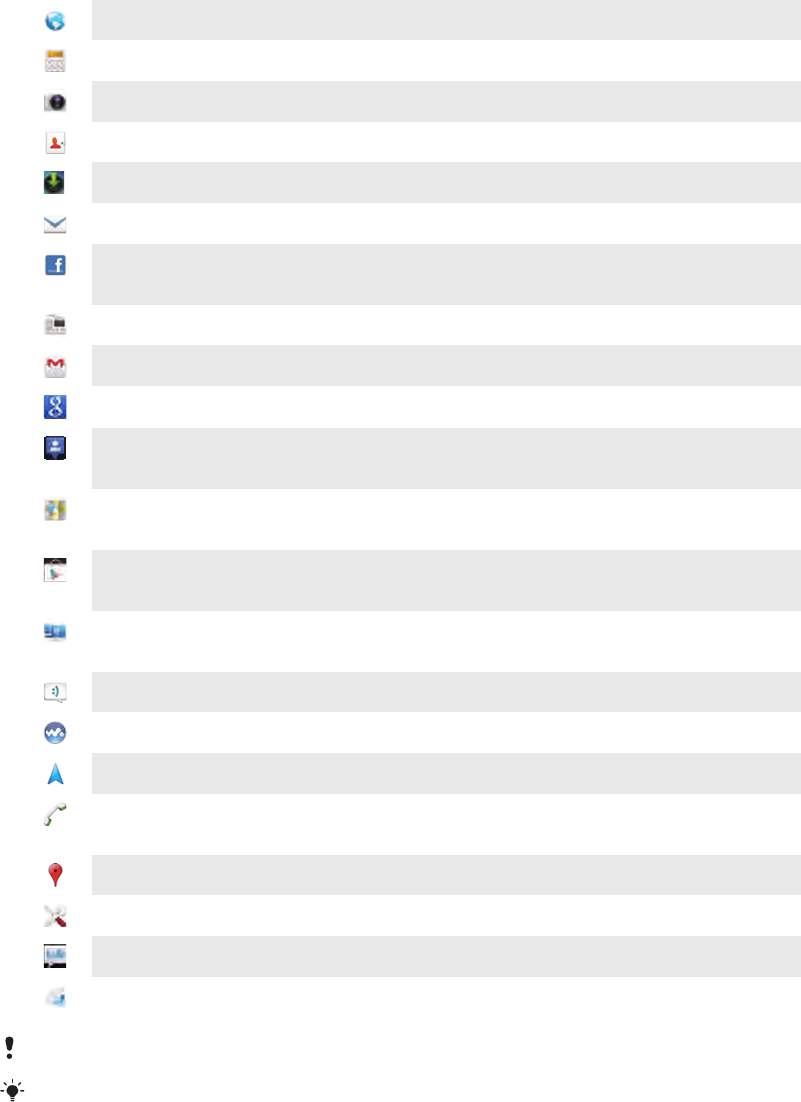
Application overview
Browser Browse the web
Calculator Perform basic calculations
Camera Take photos and record video clips
Contacts Keep track of your friends and colleagues
Downloads Access your downloaded applications
Email Send and receive emails
Facebook™ Connect with your friends, family members and colleagues
around the world
FM radio Listen to the radio in your phone
Gmail™ An email application that supports Gmail™
Google Search Find information in your phone and on the web
Latitude View your friends’ locations on Google™ maps and share
your location and other information with them
Maps View your current location, find other locations and calculate
routes
Play Store Go to Android Market™ to download free and paid
applications for your phone
Connected devices Share media files in your phone with other devices over a
shared Wi-Fi® connection
Messaging Send and receive text and multimedia messages
Music player Play music and playlists
Navigation Navigate using spoken, turn-by-turn driving instructions
Phone Make and receive calls, switch between calls, set up
conference calling and view your call history
Places Search for places, for example, restaurants and cafés
Settings Tailor phone settings to your own liking
Talk Chat online
Timescape™ Keep track of all daily communication
Some applications are not supported by all networks and/or service providers in all areas.
Your phone is pre-loaded with certain AT&T specific applications.
131
This is an Internet version of this publication. © Print only for private use.
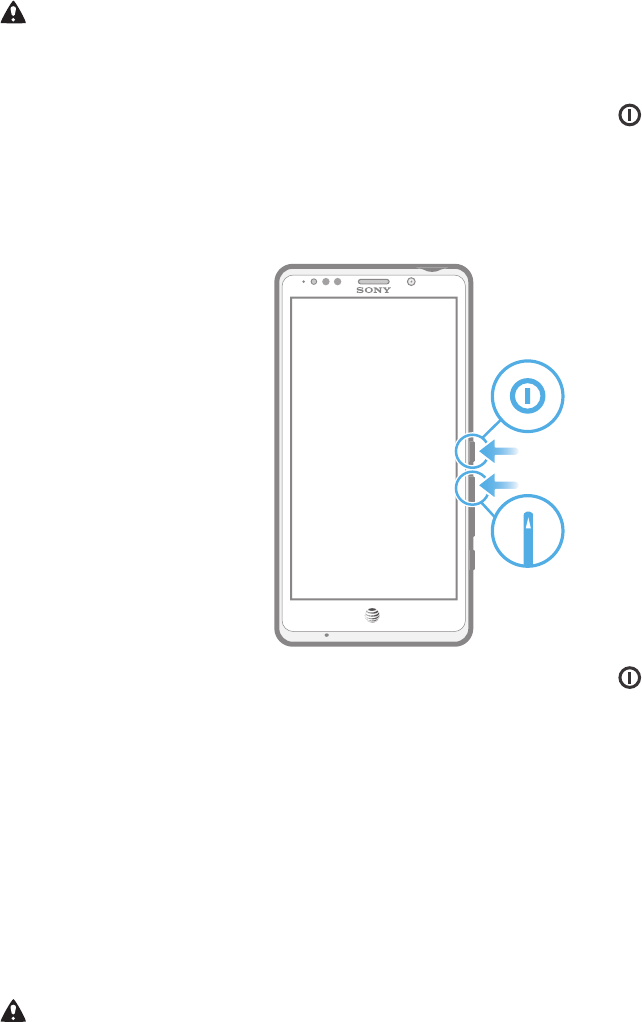
Troubleshooting
My phone is not working as expected
If you experience problems with your phone, check these tips before you try anything
else:
•Restart your phone.
•Remove and re-insert the SIM card. Then restart your phone.
•Force a restart of the phone if the phone hangs and can't be restarted normally.
•Update your phone. Updating your phone ensures optimal performance and provides
the latest enhancements. See Updating your phone on page 125 for more
information.
•Reset your phone.
Be patient while resetting your phone. Restarting the phone during a reset procedure may
damage the phone permanently.
To force the phone to shut down
1Press and hold down both the volume up key and the power key for 10
seconds.
2After your phone vibrates three times, release the keys. The phone turns off
automatically.
To force the phone to restart
1Press and hold down both the volume up key and the power key for five
seconds.
2After your phone vibrates once, release the keys. The phone restarts
automatically.
Resetting the phone
You can reset your phone to its original settings. When you perform a factory data
reset, you reset the phone to the state it was in before you turned it on for the first
time, and all personal data is erased. You can also reset the phone to the original
settings without erasing your personal data. Before you perform a reset, make sure to
back up any important data saved on your phone.
To reset the phone without erasing personal data
To avoid permanent phone damage, do not restart the phone while a reset procedure is
underway.
132
This is an Internet version of this publication. © Print only for private use.

1From your Home screen, tap .
2Find and tap Settings > Backup & reset.
3Tap Settings reset > Reset phone.
4To confirm, tap Reset settings.
To perform a factory data reset
To avoid permanent phone damage, do not restart the phone while a reset procedure is
underway.
1From your Home screen, tap .
2Find and tap Settings > Backup & reset.
3Tap Factory data reset > Reset phone.
4To confirm, tap Erase everything.
No battery charging icon appears when phone starts
charging
It may take a few minutes before the battery icon appears on the screen.
The battery performance is low
Follow our smart tips on how to get more out of your battery. See Improving battery
performance on page 14.
My wired headset does not work
•Make sure the wired headset that you are using complies to the CTIA standard. Your
phone supports the CTIA standard, and may not be fully compatible with other
standards such as OMTP.
•If you have a wireless headset that is compatible with your phone, try using that
instead.
I cannot transfer content between my phone and the
computer, when using a USB cable
The software or the USB drivers have not been properly installed. Go to
www.att.com/tutorials for more detailed installation instructions and troubleshooting
information.
Error messages
No network coverage
•Your phone is in Airplane mode. Make sure Airplane mode is turned off.
•Your phone is not receiving any network signal, or the received signal is too weak.
Contact AT&T and make sure that the network has coverage where you are.
•The SIM card is not working properly. Insert your SIM card in another phone. If this
works, it is probably your phone that is causing the problem. In this case, contact the
nearest Sony service center.
Emergency calls only
You are within range of a network, but you are not allowed to use it. However, in an
emergency, some network operators allow you to call the international emergency
number 112. See Emergency calls on page 35 for more information.
SIM card locked
You have entered your PIN incorrectly 3 times in a row. To unlock the phone, you
need the PUK provided by your operator.
133
This is an Internet version of this publication. © Print only for private use.
SIM card is PUK locked
You have entered your PUK (Personal Unblocking Key) incorrectly 10 times in a row.
Please contact AT&T.
134
This is an Internet version of this publication. © Print only for private use.

Hearing Aid Compatibility
Your phone is designed for Hearing Aid Compatibility (HAC) and can be used with
hearing aids.
Hearing Aid Settings
You can choose the setting in the phone to match the setting in your hearing aid
before making or receiving calls.
To select a phone setting for HAC
1From the Home screen, tap .
2Find and tap Settings > Call settings.
3Mark the Hearing aids checkbox to turn on hearing aid compatibility.
Hearing Aid Compatibility Information
This phone has been tested and rated for use with hearing aids for some of the
wireless technologies that it uses. However, there may be some newer wireless
technologies used in this phone that have not been tested yet for use with hearing
aids. It is important to try the different features of this phone thoroughly and in
different locations, using your hearing aid or cochlear implant, to determine if you
hear any interfering noise. Consult your service provider or the manufacturer of this
phone for information on hearing aid compatibility. If you have questions about return
or exchange policies, consult your service provider or phone retailer.
Hearing Aid Compatibility Rating
This model handset was designed to comply with the requirements set forth in
Section 20.19 of the Federal Communication Commission's (FCC) rules governing
hearing aid compatibility (HAC), for the reduction of RF interference and magnetic
coupling (T-coil) to hearing aids. The Microphone (M) rating and T-coil (T) rating is
defined and labeled on the handset box. Devices meeting HAC compliance must
have a minimum M3 and/or T3 rating or above as defined by the FCC in accordance
with the latest ANSI Standard C63.19. The (M) rating refers to lower RF emission
levels of the handset. The (T) rating refers to the magnetic coupling between the
handset and the T-coil compatible hearing aid. Some hearing aids are also provided
an (M) rating, and are more immune than others to interference. To determine the (M)
rating of your hearing aid, please contact your hearing health professional. More
information about digital wireless devices and hearing aid compatibility can be found
at www.sonyericsson-snc.com.
135
This is an Internet version of this publication. © Print only for private use.
Recycling your phone
Got an old phone lying around the house? Why not recycle it? By doing so, you will
help us reuse its materials and components, and you’ll protect the environment, too!
Find out more about the recycling options in your region at www.sonymobile.com.
136
This is an Internet version of this publication. © Print only for private use.
Legal information
Sony LT30at
This User guide is published by Sony Mobile Communications AB or its local affiliated company, without any
warranty. Improvements and changes to this User guide necessitated by typographical errors, inaccuracies of
current information, or improvements to programs and/or equipment, may be made by Sony Mobile
Communications AB at any time and without notice. Such changes will, however, be incorporated into new
editions of this User guide.
©Sony Mobile Communications AB, 2012.
All rights reserved.
Publication number: 1266-7528.1
Your mobile phone has the capability to download, store and forward additional content, for example,
ringtones. The use of such content may be restricted or prohibited by rights of third parties, including but not
limited to restriction under applicable copyright laws. You, and not Sony, are entirely responsible for additional
content that you download to or forward from your mobile phone. Prior to your use of any additional content,
please verify that your intended use is properly licensed or is otherwise authorized. Sony does not guarantee
the accuracy, integrity or quality of any additional content or any other third party content. Under no
circumstances will Sony be liable in any way for your improper use of additional content or other third party
content.
This User guide may reference services or applications provided by third parties. Use of such programming or
services may require separate registration with the third party provider and may be subject to additional terms
of use. For applications accessed on or through a third-party website, please review such websites’ terms of
use and applicable privacy policy in advance. Sony does not warrant or guarantee the availability or
performance of any third-party websites or offered services.
All product and company names mentioned herein are the trademarks or registered trademarks of their
respective owners. Any rights not expressly granted herein are reserved. All other trademarks are property of
their respective owners.
The Liquid Identity and Liquid Energy logos, Xperia, and Timescape are trademarks or registered trademarks of
Sony Mobile Communications AB.
4G speeds delivered by HSPA+ with enhanced backhaul. Available in limited areas. Availability increasing with
ongoing backhaul deployment. Learn more at att.com/network. 4G used in connection with the Sony Xperia™
TL product name refers to the fact that the Xperia™ TL is capable of operating on AT&T’s HSPA+ network
with enhanced backhaul described herein. Service provided by AT&T Mobility.
©2012 AT&T Intellectual Property. All rights reserved. AT&T, the AT&T logo and all other AT&T marks
contained herein are trademarks of AT&T Intellectual Property and/or AT&T affiliated companies. All other
marks contained herein are the property of their respective owners.
Visit www.sonymobile.com for more information.
All illustrations are for illustration purposes only and may not accurately depict the actual phone.
This product is protected by certain intellectual property rights of Microsoft. Use or distribution of such
technology outside of this product is prohibited without a license from Microsoft.
Content owners use Windows Media digital rights management technology (WMDRM) to protect their
intellectual property, including copyrights. This device uses WMDRM software to access WMDRM-protected
content. If the WMDRM software fails to protect the content, content owners may ask Microsoft to revoke the
software's ability to use WMDRM to play or copy protected content. Revocation does not affect unprotected
content. When you download licenses for protected content, you agree that Microsoft may include a
revocation list with the licenses. Content owners may require you to upgrade WMDRM to access their content.
If you decline an upgrade, you will not be able to access content that requires the upgrade.
This product is licensed under the MPEG-4 visual and AVC patent portfolio licenses for the personal and non-
commercial use of a consumer for (i) encoding video in compliance with the MPEG-4 visual standard
("MPEG-4 video") or the AVC standard ("AVC video") and/or (ii) decoding MPEG- 4 or AVC video that was
encoded by a consumer engaged in a personal and non-commercial activity and/or was obtained from a video
provider licensed by MPEG LA to provide MPEG-4 and/or AVC video. No license is granted or shall be implied
for any other use. Additional information including that relating to promotional, internal and commercial uses
and licensing may be obtained from MPEG LA, L.L.C. See http://www.mpegla.com. MPEG Layer-3 audio
decoding technology licensed from Fraunhofer IIS and Thomson.
Your phone is designed to make it easy for you to access a wide variety of content. For your protection, we
want you to be aware that some applications that you enable may involve the location of your phone being
shared. For applications available through AT&T, we offer privacy controls that let you decide how an
application may use the location of your phone and other phones on your account. However, the AT&T privacy
tools do not apply to applications available outside of AT&T. Please review the terms and conditions and the
associated privacy policy for each location-based service to learn how location information will be used and
protected. In addition, your AT&T phone may be used to access the Internet and to download, and/or
purchase goods, applications, and services from AT&T or elsewhere from third parties. AT&T provides tools for
you to control access to the Internet and certain Internet content. These controls may not be available for
certain devices which bypass AT&T controls.
137
This is an Internet version of this publication. © Print only for private use.
Index
A
accounts ....................................................................9
Exchange Active Sync® ....................................9
Facebook™ .....................................................10
Google™ ...........................................................9
adjusting volume .....................................................81
Airplane mode .........................................................31
alarm ........................................................................62
Album ....................................................................101
map ...............................................................105
online albums ................................................106
opening .........................................................101
pictures ..........................................................102
thumbnail size ...............................................103
viewing ..........................................102, 105, 106
viewing local content .....................................101
viewing online photos ....................................107
Android™ ..................................................................7
animated wallpaper .................................................19
answering service ....................................................37
applications ...............................................................7
arranging .........................................................22
overview ........................................................131
screen ..............................................................20
sorting .............................................................22
audio ........................................................................84
adjusting volume .............................................81
playing .............................................................80
playing tracks in random order .......................85
audio content
related content ................................................83
B
backing up
contacts ...........................................................45
battery .....................................................................12
Bluetooth™ wireless technology ...........................112
BRAVIA® Engine ...................................................101
brightness ................................................................31
business cards
sending ............................................................44
C
calendar ...................................................................62
create an event ................................................62
calling ......................................................................33
calls ...................................................................35, 39
barring .............................................................38
diverting .....................................................38, 39
emergency .......................................................35
forwarding .......................................................39
log ....................................................................36
missed .............................................................36
multiple ............................................................37
reject ................................................................38
settings ............................................................38
waiting .............................................................37
camera ...................................................90, 92, 93, 98
closing .............................................................90
controls ...........................................................90
face detection ............................................91, 92
geotagging ......................................................92
icons ................................................................98
overview ..........................................................90
recording videos ..............................................97
screen ..............................................................90
self-portraits ....................................................91
settings ......................................................93, 98
smile detection ................................................92
taking photos ......................................90, 91, 92
using the flash .................................................91
video ................................................................97
viewing photos ................................................91
viewing videos .................................................98
zoom ................................................................91
caps lock .................................................................24
charging ...................................................................12
chat ..........................................................................53
conference calls ......................................................37
contacts ...................................................................40
backing up .......................................................45
copying ............................................................45
favourite ...........................................................44
groups .............................................................44
importing from SIM card .................................41
joining contact information ..............................43
picture .............................................................43
sending ............................................................44
sharing .............................................................44
transferring ......................................................41
using a photo with .........................................104
corporate email, calendar and contacts ..................66
cropping
photos ...........................................................103
D
data traffic ...............................................................33
date
format ..............................................................30
deleting ....................................................................82
an alarm ...........................................................62
photos ...........................................................104
tracks ...............................................................82
videos ............................................................105
driving directions ...................................................119
E
editing
photos ...........................................................104
email ........................................................................48
more than one account ...................................51
emergency numbers ................................................35
equalizer ............................................................81, 82
events
calendar ...........................................................62
in Timescape™ ...............................................56
Explore by Touch ....................................................54
extensions ...............................................................18
F
face detection ....................................................91, 92
Facebook™ .............................................................89
Facebook™ integration ...................................66
logging in to .....................................................56
status update ..................................................56
synchronisation ...............................................66
favourites
moving between in the radio ...........................88
removing radio channels as ............................88
saving radio channels as .................................88
filter
events in Timescape™ ....................................56
fixed dialling ............................................................39
flash
using when taking photos ...............................91
Flight mode - See Airplane mode ............................31
138
This is an Internet version of this publication. © Print only for private use.
FM radio
favourites .........................................................88
selecting a channel ..........................................87
force restart ...........................................................132
front camera ............................................................90
G
geotagging
of photos .........................................................92
gesture input ...........................................................26
Gmail™ ....................................................................51
Google Latitude™ .................................................119
Google Maps™ .....................................................119
Google Play™ .........................................................60
Google Talk™ ..........................................................53
Google™ account setup .........................................52
Google™ synchronisation .......................................65
GPS .......................................................................118
H
headset ....................................................................33
using ................................................................33
hearing aid compatibility .......................................135
Home screen ...........................................................18
customising .....................................................19
I
icons ......................................................................129
in the camera ...................................................98
importing SIM contacts ...........................................41
improving photos with Mobile BRAVIA® Engine ..101
infinite button ...........................................................83
in Timescape™ ...............................................57
instant messaging ...................................................53
Internet
web browser ....................................................74
K
keyboard .................................................................24
settings ............................................................28
keys .........................................................................12
L
language ..................................................................31
writing ..............................................................28
Latitude .................................................................119
LCD backlight control ..............................................31
"Like" a photo on Facebook™ ..............................107
"Like" a track on Facebook™ .................................82
"Like" a video on Facebook™ ...............................107
live wallpaper ...........................................................19
location ............................................................92, 118
locks
activating the screen .........................................9
locking the screen .............................................9
screen lock ........................................................9
lockscreen
viewing missed calls ........................................17
viewing new text messages ............................17
M
Maps ......................................................................119
media files
copying to a memory card ..............................80
Media Go™ ...........................................................116
memory card
inserting .............................................................8
MHL .......................................................................117
micro SIM card
inserting .............................................................8
Microsoft® Exchange synchronisation ...................66
Mobile BRAVIA® Engine .......................................101
movies ...................................................................108
multimedia
copying to a memory card ..............................80
music .................................................................33, 80
adjusting volume .............................................81
changing tracks ...............................................81
copying to a memory card ..............................80
copying to/from a computer ...........................80
downloading music information ......................84
hearing protection ...........................................80
My playlists ......................................................85
pausing a track ................................................81
playing .............................................................80
podcasts ..........................................................80
sharing .............................................................82
shortcuts .........................................................84
using a headset ...............................................33
Visualizer ...................................................82, 83
N
Navigation application ...........................................119
new services ............................................................56
notification .............................................................129
light ..................................................................22
panel ................................................................23
ringtone ...........................................................30
setting ..............................................................23
O
on-screen keyboard ................................................24
overview
phone ..............................................................81
P
pausing a track ........................................................81
personal information ................................................40
phone
battery .............................................................14
performance ....................................................14
update ...........................................................125
phonebook ..............................................................40
Phonepad ..........................................................24, 27
photo albums
viewing ..........................................................101
photos ...................................................................104
adding a geotag ............................................104
adding the geographical position ....................92
associating with a contact ..............................43
copying to/from a computer ...........................80
cropping ........................................................103
deleting ..........................................................104
editing ............................................................104
photo viewer ..................................................102
rotating ..........................................................103
selecting ........................................................103
sharing ...........................................................104
slideshow ......................................................103
taking ...................................................90, 91, 92
using as a contact picture .............................104
using as wallpaper ........................................104
viewing ....................................91, 101, 102, 103
viewing on a map ..........................................105
viewing same location .....................................92
zooming .........................................................103
PIN .................................................................120, 121
playing
music ...............................................................80
playlists ....................................................................85
adding a track .................................................85
creating ...........................................................85
deleting ............................................................85
139
This is an Internet version of this publication. © Print only for private use.
playing your own .............................................85
removing tracks ...............................................85
power saver .............................................................14
activating .........................................................15
changing settings ............................................15
deactivating .....................................................15
displaying notifications ....................................15
power saving mode .................................................14
powering off ..............................................................8
powering on ...............................................................8
presets
removing radio channels as ............................88
saving radio channels as .................................88
protective plastic sheet ...........................................15
PUK ...............................................................120, 121
R
radio ........................................................................87
favourites .........................................................88
listening to with the speaker ...........................88
mono sound ....................................................88
moving between channels ..............................87
opening ...........................................................87
searching for channels ....................................88
selecting a channel ..........................................87
stereo sound ...................................................88
using with Facebook™ ....................................89
receiving items using Bluetooth™ .........................113
recently used applications window .........................21
recommending music ..............................................82
recommending photos and videos ........................107
recording videos ......................................................90
using the camera key ......................................97
recycling your phone .............................................136
resetting .................................................................132
resizing
photos ...........................................................103
ringtone ...................................................................62
rotating
photos ...........................................................103
S
screen ......................................................................31
cracked ............................................................15
glass ................................................................15
screen unlock pattern ....................................120
warranty ...........................................................15
self-portrait ..............................................................90
sending
business cards ................................................44
contacts ...........................................................44
sending items using Bluetooth™ ..................113
SensMe™ channels ................................................84
services .....................................................................9
settings
call ...................................................................38
camera ......................................................93, 98
data usage .......................................................33
quick settings ..................................................22
still camera ......................................................93
Timescape™ ...................................................57
video camera ...................................................98
sharing
music ...............................................................82
photos ...........................................................104
shuffle music ...........................................................85
silent mode ..............................................................29
SIM card ........................................................120, 121
exporting contacts to ......................................45
importing contacts from ..................................41
slideshow ..............................................................103
smile detection ........................................................92
SOS - See emergency numbers
status .....................................................................129
bar ...................................................................22
still camera ..............................................................90
settings ............................................................93
surround sound .......................................................82
symbols ...................................................................24
synchronising ..........................................................65
Facebook™ contacts, calendar, photos .........66
Google™ contacts, calendar, email ................65
with Microsoft® Exchange ..............................66
T
taking photos ...........................................................90
by tapping .......................................................91
self-portraits ....................................................91
using face detection ........................................92
using smile detection ......................................92
using the camera key ......................................90
TalkBack service .....................................................54
telephony - See calls
text input method ....................................................24
themes .....................................................................19
tiles ..........................................................................55
time ..........................................................................30
time management ....................................................62
Timescape™ .....................................................55, 56
filter icons ........................................................56
infinite button in ...............................................57
screen overview ..............................................55
settings ............................................................57
Timescape™ Feed widget ..............................57
Timescape™ Friends widget ...........................58
Timescape™ Share widget .............................59
widgets ......................................................58, 59
transferring
contacts ...........................................................41
troubleshooting .....................................................132
turning off ..................................................................8
turning on ..................................................................8
Twitter™
logging in to .....................................................56
status update ..................................................56
U
update
status ...............................................................56
updating phone .....................................................125
USB connection ....................................................115
using the equalizer ..................................................81
V
vibration .............................................................30, 62
video albums
viewing ..........................................................101
video camera ...............................................90, 97, 98
recording videos ..............................................97
settings ............................................................98
video player
pausing a video .............................................104
videos ....................................................................104
adjusting volume ...........................................104
copying to/from a computer ...........................80
deleting ..........................................................105
fast forwarding and rewinding .......................104
pausing ..........................................................104
playing ...........................................................104
recording .........................................................97
selecting ........................................................103
sending ..........................................................105
sharing ...........................................................105
140
This is an Internet version of this publication. © Print only for private use.
viewing ....................................98, 101, 102, 103
viewing
movies ...........................................................108
photos .............................................................91
videos recorded using the camera ..................98
voice input ...............................................................29
voice recognition .....................................................29
voicemail .................................................................37
volume
adjusting video ..............................................104
key ...................................................................29
W
Walkman™ player ...................................................84
adding tracks to playlists ................................85
creating playlists .............................................85
deleting tracks .................................................82
Friends’ music .................................................84
minimising .......................................................82
My music .........................................................83
overview ..........................................................83
player overview ...............................................81
playing tracks in random order .......................85
playlists ...........................................................85
SensMe™ channels ........................................84
using the equalizer ....................................81, 82
Walkman™ player widget .......................................85
wallpaper .................................................................19
using a photo as ............................................104
web browser ............................................................74
managing bookmarks ......................................76
settings ............................................................78
Wi-Fi® ...............................................................70, 72
widgets ....................................................................18
resizing ............................................................19
Timescape™ Feed ....................................57, 58
Timescape™ Friends ......................................58
Timescape™ Share .........................................59
wireless networks ..................................................118
Z
zoom ........................................................................91
zooming
photos ...........................................................103
141
This is an Internet version of this publication. © Print only for private use.

Important information
Sony Consumer Web site
On www.sonymobile.com/support there is a support section where help
and tips are only a few clicks away. Here you will find the latest computer
software updates and tips on how to use your product more efficiently.
Service and support
You have access to a portfolio of exclusive service advantages such as:
•Global and local Web sites providing support.
•A global network of Contact Centers.
•An extensive network of Sony service partners.
•A warranty period. Learn more about the warranty conditions in
theLimited warrantysection.
At www.sonymobile.com/support, you can find the latest support tools
and information. For operator-specific services and features, please
contact your network operator.
You can also contact our Contact Centers. If your country/region is
not represented in the list below, please contact your local dealer. (Calls
are charged according to national rates, including local taxes, unless the
phone number is a toll-free number.)
If your product needs service, please contact the dealer from whom it
was purchased, or one of our service partners. For warranty claims, save
proof of purchase.
Guidelines for Safe and Efficient Use
Please follow these guidelines. Failure to do so might entail a
potential health risk or product malfunction. If in doubt as to its
proper function, have the product checked by a certified service
partner before charging or using it.
Recommendations for care and safe use of our products
•Handle with care and keep in a clean and dust-free place.
• Warning! May explode if disposed of in fire.
•Do not expose to liquid or moisture or excess humidity.
•For optimum performance, the product should not be
operated in temperatures below +14°F(-10°C) or above
+113°F(+45°C). Do not expose the battery to temperatures
above +140°F(+60°C).
2
•Do not expose to flames or lit tobacco products.
•Do not drop, throw or try to bend the product.
•Do not paint or attempt to disassemble or modify the
product. Only Sony authorized personnel should perform
service.
•Consult with authorized medical staff and the instructions of the
medical device manufacturer before using the product near
pacemakers or other medical devices or equipment.
•Discontinue use of electronic devices, or disable the radio transmitting
functionality of the device, where required or requested to do so.
•Do not use where a potentially explosive atmosphere exists.
•Do not place the product, or install wireless equipment, in the area
above an air bag in a car.
• Caution: Cracked or broken displays may create sharp edges or
splinters that could be harmful upon contact.
•Do not use the Bluetooth Headset in positions where it is
uncomfortable or will be subject to pressure.
Children
Warning! Keep out of the reach of children. Do not allow children
to play with phones or accessories. They could hurt themselves or
others. Products may contain small parts that could become detached
and create a choking hazard.
Power supply (Charger)
Connect the charger to power sources as marked on the product. Do
not use outdoors or in damp areas. Do not alter or subject the cord to
damage or stress. Unplug the unit before cleaning it. Never alter the
plug. If it does not fit into the outlet, have a proper outlet installed by an
electrician. When power supply is connected there is a small drain of
power. To avoid this small energy waste, disconnect the power supply
when the product is fully charged. Use of charging devices that are not
Sony branded may impose increased safety risks.
Battery
New or idle batteries can have short-term reduced capacity. Fully charge
the battery before initial use. Use for intended purpose only. Charge the
battery in temperatures between +41°F (+5°C) and +113°F (+45°C). Do
not put the battery into your mouth. Do not let the battery contacts touch
another metal object. Turn off the product before removing the battery.
Performance depends on temperatures, signal strength, usage patterns,
3
features selected and voice or data transmissions. Only Sony service
partners should remove or replace built-in batteries. Use of batteries that
are not Sony branded may pose increased safety risks. Replace the
battery only with another Sony battery that has been qualified with the
product per the standard IEEE-1725. Use of an unqualified battery may
present a risk of fire, explosion, leakage or other hazard.
Personal medical devices
Phones may affect implanted medical equipment. Reduce risk of
interference by keeping a minimum distance of 6 inches (15 cm) between
the phone and the device. Use the phone at your right ear. Do not carry
the phone in your breast pocket. Turn off the phone if you suspect
interference. In the event of use in proximity to personal medical devices,
please consult a physician and the device manufacturer.
Driving
Some vehicle manufacturers forbid the use of phones in their vehicles
unless a handsfree kit with an external antenna supports the installation.
Check with the vehicle manufacturer's representative to be sure that the
phone or Bluetooth handsfree will not affect the electronic systems in the
vehicle. Full attention should be given to driving at all times and local laws
and regulations restricting the use of wireless devices while driving must
be observed.
GPS/Location based functions
Some products provide GPS/Location based functions. Location
determining functionality is provided “As is” and “With all faults”. Sony
does not make any representation or warranty as to the accuracy of
such location information.
Use of location-based information by the device may not be
uninterrupted or error free and may additionally be dependent on
network service availability. Please note that functionality may be
reduced or prevented in certain environments such as building interiors
or areas adjacent to buildings.
Caution: Do not use GPS functionality in a manner which causes
distraction from driving.
Emergency calls
Calls cannot be guaranteed under all conditions. Never rely solely upon
phones for essential communication. Calls may not be possible in all
4
areas, on all networks, or when certain network services and/or phone
features are used.
Antenna
Use of antenna devices not marketed by Sony could damage your
phone, reduce performance, and produce SAR levels above the
established limits. Do not cover the antenna with your hand as this
affects call quality, power levels and can shorten talk and standby times.
Radio Frequency (RF) exposure and Specific Absorption
Rate (SAR)
When the phone or Bluetooth handsfree is turned on, it emits low levels
of radio frequency energy. International safety guidelines have been
developed through periodic and thorough evaluation of scientific studies.
These guidelines establish permitted levels of radio wave exposure. The
guidelines include a safety margin designed to assure the safety of all
persons and to account for any variations in measurements.
Specific Absorption Rate (SAR) is used to measure radio frequency
energy absorbed by the body when using a phone. The SAR value is
determined at the highest certified power level in laboratory conditions,
but because the phone is designed to use the minimum power
necessary to access the chosen network, the actual SAR level can be
well below this value. There is no proof of difference in safety based on
difference in SAR value.
Products with radio transmitters sold in the US must be certified by
the Federal Communications Commission (FCC). When required, tests
are performed when the phone is placed at the ear and when worn on
the body. For body-worn operation, the phone has been tested when
positioned a minimum of 15 mm from the body without any metal parts
in the vicinity of the phone or when properly used with an appropriate
Sony accessory and worn on the body. When operation with “Hotspot”
functionality is engaged, a separation distance of 10mm is used.
For more information about SAR and radio frequency exposure, go to:
www.sonymobile.com/health.
Flight mode
Bluetooth and WLAN functionality, if available in the device, can be
enabled in Flight mode but may be prohibited onboard aircraft or in other
areas where radio transmissions are prohibited. In such environments,
please seek proper authorization before enabling Bluetooth or WLAN
functionality even in Flight mode.
5
www.sonymobile.com
Sony Mobile Communications AB
SE-221 88 Lund, Sweden
1223-9693.7
Malware
Malware (short for malicious software) is software that can harm your
phone or other computers. Malware or harmful applications can include
viruses, worms, spyware, and other unwanted programs. While your
device does employ security measures to resist such efforts, Sony does
not warrant or represent that your device will be impervious to
introduction of malware. You can however reduce the risk of malware
attacks by using care when downloading content or accepting
applications, refraining from opening or responding to messages from
unknown sources, using trustworthy services to access the Internet, and
only downloading content to your phone from known, reliable sources.
Accessories
Use only Sony branded original accessories and certified service
partners. Sony does not test third-party accessories. Accessories may
influence RF Exposure, radio performance, sound loudness, electric
safety and other areas. Third-party accessories and parts may pose a
risk to your health or safety or decrease performance.
Accessible Solutions/Special Needs
In the US, compatible Sony Xperia phones may offer compatibility with
TTY terminals (with use of necessary accessory). For more information
call the Sony Special Needs Center on 877 878 1996 (TTY) or
877 207 2056 (voice), or go to www.sonyericsson-snc.com.
Disposal of old electrical and electronic equipment
and batteries
This symbols on the electronic product or on its packaging indicates that
the electronic product, including the battery, should not be treated as
household waste. Instead, it should be handed over to the applicable
collection point for the recycling of electrical and electronic equipment.
Do not attempt to remove internal batteries. Internal batteries must only
be removed by a waste treatment facility or trained service professional.
By ensuring this product is disposed of correctly, you will help prevent
potential negative consequences for the environment and human health,
which could otherwise be caused by inappropriate waste handling of this
product. The recycling of materials will help to conserve natural
resources. For more detailed information about recycling of this product,
please contact your local city office, your household waste disposal
service or the shop where you purchased the product, by calling a Sony
Contact Center or at www.sonymobile .com/recycling.
6
Memory card
If the product comes complete with a removable memory card, it is
generally compatible with the handset purchased but may not be
compatible with other devices or the capabilities of their memory cards.
Check other devices for compatibility before purchase or use. If the
product is equipped with a memory card reader, check memory card
compatibility before purchase or use.
Memory cards are generally formatted prior to shipping. To reformat
the memory card, use a compatible device. Do not use the standard
operating system format when formatting the memory card on a PC. For
details, refer to the operating instructions of the device or contact
customer support.
SIM card
If your phone is equipped with a standard-sized SIM card slot, inserting
an incompatible SIM card (for example, a micro SIM card, a micro SIM
card with a non-Sony adapter, or a standard SIM card cut into a micro
SIM card size) in the SIM card slot may damage your SIM card or your
phone permanently. Sony does not warrant and will not be responsible
for any damage caused by use of incompatible or modified SIM cards.
For Devices Supporting 3D Viewing capabilities
In viewing 3D images shot with this phone on a 3D-compatible monitor,
you may experience discomfort in the form of eye strain, fatigue, or
nausea. To prevent these symptoms, we recommend that you take
regular breaks. However, you need to determine for yourself the length
and frequency of breaks you require, as they vary according to the
individual. If you experience any type of discomfort, stop viewing the 3D
images until you feel better, and consult a physician as necessary. Also
refer to the operating instructions supplied with the device or software
you have connected or are using with this phone. Note that a child’s
eyesight is still at the development stage (particularly children below the
age of 6). Consult a pediatrician or ophthalmologist before letting your
child view 3D images, and make sure he/she observes the above
precautions when viewing such images.
Warning!
If the device requires an adapter for insertion into the handset or another
device, do not insert the card directly without the required adapter.
7
Precautions on memory card use
•Do not expose the memory card to moisture.
•Do not touch terminal connections with your hand or any metal object.
•Do not strike, bend, or drop the memory card.
•Do not attempt to disassemble or modify the memory card.
•Do not use or store the memory card in humid or corrosive locations or
in excessive heat such as a closed car in summer, in direct sunlight or
near a heater, etc.
•Do not press or bend the end of the memory card adapter with
excessive force.
•Do not let dirt, dust, or foreign objects get into the insert port of any
memory card adapter.
•Check you have inserted the memory card correctly.
•Insert the memory card as far as it will go into any memory card
adapter needed. The memory card may not operate properly unless
fully inserted.
•We recommend that you make a backup copy of important data. We
are not responsible for any loss or damage to content you store on the
memory card.
•Recorded data may be damaged or lost when you remove the memory
card or memory card adapter, turn off the power while formatting,
reading or writing data, or use the memory card in locations subject to
static electricity or high electrical field emissions.
Protection of personal information
Erase personal data before disposing of the product. To delete data,
perform a master reset. Deleting data from the phone memory does not
ensure that it cannot be recovered. Sony does not warrant against
recovery of information and does not assume responsibility for disclosure
of any information even after a master reset.
Loudness warning!
Avoid volume levels that may be harmful to your hearing.
End User License Agreement
Software delivered with this device and its media is owned by Sony
Mobile Communications AB, and/or its affiliated companies and its
suppliers and licensors.
Sony grants you a non-exclusive limited license to use the Software
solely in conjunction with the Device on which it is installed or delivered.
8
Ownership of the Software is not sold, transferred or otherwise
conveyed.
Do not use any means to discover the source code or any component
of the Software, reproduce and distribute the Software, or modify the
Software. You are entitled to transfer rights and obligations to the
Software to a third party, solely together with the Device with which you
received the Software, provided the third party agrees in writing to be
bound by the terms of this License.
This license exists throughout the useful life of this Device. It can be
terminated by transferring your rights to the Device to a third party in
writing.
Failure to comply with any of these terms and conditions will terminate
the license immediately.
Sony and its third party suppliers and licensors retain all rights, title
and interest in and to the Software. Sony, and, to the extent that the
Software contains material or code of a third party, such third party, shall
be entitled third party beneficiaries of these terms.
This license is governed by the laws of Sweden. When applicable, the
foregoing applies to statutory consumer rights.
In the event Software accompanying or provided in conjunction with
your device is provided with additional terms and conditions, such
provisions shall also govern your possession and usage of the Software.
Export regulations
Export regulations: Goods delivered under this Agreement may be the
subject to import and export regulations of the European Union, the
United States and other countries. Purchaser will comply with these
applicable laws and regulations and will obtain and maintain any export
and import license required for the delivery of goods to Purchaser under
this Agreement. Without limiting the foregoing, and as an example,
Purchaser will not knowingly export or re-export goods to destinations
identified pursuant to Articles in Chapter II of European Council
Regulation (EC) 428/2009 and specifically, and without limitation,
Purchaser will also comply with U.S. government Export Administration
Regulations (“EAR”, 15 C.F.R. §§ 730-774, http://www.bis.doc.gov/)
administered by Department of Commerce, Bureau of Industry and
Security and economic sanctions regulations (30 C.F.R. §§ 500 et. seq.,
http://www.treas.gov/offices/enforcement/ofac/) administered by the
U.S. Department of Treasury, Office of Foreign Assets Control.
9
June 27, 2012 13:41:03
Legal-Leaflets---Generic_AE (12M)_1223-9693.7.pdf 1 of 2

Limited Warranty
Sony Mobile Communications AB, SE-221 88 Lund, Sweden, (Sony) or
its local affiliated company, provides this Limited Warranty for your
phone, original accessory delivered with your phone, and/or your mobile
computing product (hereinafter referred to as “Product”).
Should your Product need warranty service, please return it to the
dealer from whom it was purchased, or contact your local Sony Contact
Center (national rates may apply) or visit www.sonymobile.com to get
further information.
Our warranty
Subject to the conditions of this Limited Warranty, Sony warrants this
Product to be free from defects in design, material and workmanship at
the time of its original purchase by a consumer. This Limited Warranty
will last for a period of one (1) year as from the original date of purchase
of the Product.
What we will do
If, during the warranty period, this Product fails to operate under normal
use and service, due to defects in design, materials or workmanship,
Sony authorized distributors or service partners, in the country* where
you purchased the Product, will, at their option, either repair or replace
the Product in accordance with the terms and conditions stipulated
herein.
Sony and its service partners reserve the right to charge a handling fee
if a returned Product is found not to be under warranty according to the
conditions below.
Please note that some of your personal settings, downloads and other
information may be lost when your Sony Product is repaired or replaced.
At present Sony may be prevented by applicable law, other regulation or
technical restrictions from making a backup copy of certain downloads.
Sony does not take any responsibility for any lost information of any kind
and will not reimburse you for any such loss. You should always make
backup copies of all the information stored on your Sony Product such
as downloads, calendar and contacts before handing in your Sony
Product for repair or replacement.
Conditions
1. This Limited Warranty is valid only if the original proof of purchase for
this Product issued by a Sony authorized dealer specifying the date of
10
purchase and serial number**, is presented with the Product to be
repaired or replaced. Sony reserves the right to refuse warranty service
if this information has been removed or changed after the original
purchase of the Product from the dealer.
2. If Sony repairs or replaces the Product, the repair for the defect
concerned, or the replaced Product shall be warranted for the
remaining time of the original warranty period or for ninety (90) days
from the date of repair, whichever is longer. Repair or replacement may
involve the use of functionally equivalent reconditioned units. Replaced
parts or components will become the property of Sony.
3. This warranty does not cover any failure of the Product due to normal
tear and wear, or due to misuse, including but not limited to use in
other than the normal and customary manner, in accordance with the
Sony instructions for use and maintenance of the Product. Nor does
this warranty cover any failure of the Product due to accident, software
or hardware modification or adjustment, acts of God or damage
resulting from liquid.
A rechargeable battery can be charged and discharged more than a
hundred times. However, it will eventually wear out – this is not a defect
and corresponds to normal wear and tear. When the talk-time or
standby time is noticeably shorter, it is time to replace your battery.
Sony recommends that you use only batteries and chargers approved
by Sony.
Minor variations in display brightness and color may occur between
the phones. There may be tiny bright or dark dots on the display. It
occurs when individual dots have malfunctioned and cannot be
adjusted. Two defective pixels are deemed acceptable.
Minor variations in camera image appearance may occur between
phones. This is nothing uncommon and is not regarded as a defective
camera module.
4. Since the cellular system on which the Product is to operate is
provided by a carrier independent from Sony, Sony will not be
responsible for the operation, availability, coverage, services or range of
that system.
5. This warranty does not cover Product failures caused by installations,
modifications, or repair or opening of the Product performed by a non-
Sony authorized person.
6. The warranty does not cover Product failures which have been caused
by use of accessories or other peripheral devices which are not Sony
branded original accessories intended for use with the Product.
7. Tampering with any of the seals on the Product will void the warranty.
11
8. THERE ARE NO EXPRESS WARRANTIES, WHETHER WRITTEN OR
ORAL, OTHER THAN THIS PRINTED LIMITED WARRANTY. ALL
IMPLIED WARRANTIES, INCLUDING WITHOUT LIMITATION THE
IMPLIED WARRANTIES OF MERCHANTABILITY OR FITNESS FOR A
PARTICULAR PURPOSE, ARE LIMITED TO THE DURATION OF THIS
LIMITED WARRANTY. IN NO EVENT SHALL SONY OR ITS
LICENSORS BE LIABLE FOR INCIDENTAL OR CONSEQUENTIAL
DAMAGES OF ANY NATURE WHATSOEVER, INCLUDING BUT NOT
LIMITED TO LOST PROFITS OR COMMERCIAL LOSS; TO THE FULL
EXTENT THOSE DAMAGES CAN BE DISCLAIMED BY LAW.
Some countries/states do not allow the exclusion or limitation of
incidental or consequential damages, or limitation of the duration of
implied warranties, so the preceding limitations or exclusions may not
apply to you.
The warranty provided does not affect the consumer's statutory rights
under applicable legislation in force, nor the consumer's rights against
the dealer arising from their sales / purchase contract.
*Geographical scope of the warranty
If you have purchased your Product in a country member of the
European Economic Area (EEA) or in Switzerland or the Republic of
Turkey, and such Product was intended for sale in the EEA or in
Switzerland or in Turkey, you can have your Product serviced in any EEA
country or in Switzerland or in Turkey, under the warranty conditions
prevailing in the country in which you require servicing, provided that an
identical Product is sold in such country by an authorized Sony
distributor. To find out if your Product is sold in the country you are in,
please call the local Sony Contact Center. Please observe that certain
services may not be available outside the country of original purchase,
for example, due to the fact that your Product may have an interior or
exterior which is different from equivalent models sold in other countries.
Please note in addition that it may sometimes not be possible to repair
SIM-locked Products.
** In some countries/regions additional information (such as a valid
warranty card) may be requested.
Trademarks and acknowledgements
The Liquid Identity logo and Xperia are trademarks or registered
trademarks of Sony Mobile Communications AB.
Sony is a trademark or a registered trademark of Sony Corporation.
12
Ericsson is a trademark or registered trademark of
Telefonaktiebolaget LM Ericsson.
Bluetooth is a trademark or a registered trademark of Bluetooth SIG
Inc. and any use of such mark by Sony is under license.
Other product and company names mentioned herein may be the
trademarks of their respective owners.
Any rights not expressly granted herein are reserved.
13
Anguilla 1-800-080-9518
(Toll Free)
questions.CO@support.sonymobile.com
Antigua and
Barbuda
1-800-081-9518
(Toll Free)
questions.CO@support.sonymobile.com
Argentina 0800-333-7427
(número gratuito)
questions.CO@support.sonymobile.com
Australia 1300 650-050
(Toll Free)
questions.AU@support.sonymobile.com
The
Bahamas
1-800-205-6062
(Toll Free)
questions.CO@support.sonymobile.com
Barbados 1-800-082-9518
(Toll Free)
questions.CO@support.sonymobile.com
Belgique/
België
02-0745 1611 questions.BE@support.sonymobile.com
Belize AN 815, PIN
5597 (Toll Free)
questions.CO@support.sonymobile.com
Bermuda 1-800-083-9518
(Toll Free)
questions.CO@support.sonymobile.com
Bolivia 800-100-542
(número gratuito)
questions.CO@support.sonymobile.com
Brasil 4001-0444
(Capitais e
regiões
metropolitanas)
0800 884 0444
(Demais regiões)
questions.BR@support.sonymobile.com
Canada 1 866 766 9374
(Toll Free / sans
frais)
questions.CA@support.sonymobile.com
Cayman
Islands
1-800-084-9518
(Toll Free)
questions.CO@support.sonymobile.com
14
Central and
Southern
Africa
+27 11 506 0123 questions.CF@support.sonymobile.com
Česká
republika 844 550 055 questions.CZ@support.sonymobile.com
Chile 800-646-425
(número gratuito)
questions.CO@support.sonymobile.com
Colombia 01800-0966-080
(número gratuito)
questions.CO@support.sonymobile.com
Costa Rica 0 800 011 0400
(número gratuito)
questions.CO@support.sonymobile.com
Danmark 3331 2828 questions.DK@support.sonymobile.com
Deutschland 0180 534 2020
(ortsübliche
Gebühren)
questions.DE@support.sonymobile.com
Dominica 1-800-085-9518
(Toll Free)
questions.CO@support.sonymobile.com
Ecuador 1-800-0102-50
(número gratuito)
questions.CO@support.sonymobile.com
Eesti 06 032 032 questions.EE@support.sonymobile.com
Egypt/رصم 16727 questions.EG@support.sonymobile.com
Ελλάδα 801 11 810 810
+30 210 899 19 19
(από κινητό
τηλέφωνο)
questions.GR@support.sonymobile.com
El Salvador 800-6323
(número gratuito)
questions.CO@support.sonymobile.com
España 902 180 576
(tarifa local)
questions.ES@support.sonymobile.com
France 09 69 32 21 21
09 69 32 21 22
(Xperia™
uniquement)
questions.FR@support.sonymobile.com
Guatemala 1-800-300-0057
(número gratuito)
questions.CO@support.sonymobile.com
15
Haïti/Ayiti AN 193, PIN
5598 (numéro
gratuit / nimewo
gratis)
questions.CO@support.sonymobile.com
Honduras AN 8000122,
PIN 5599
(número gratuito)
questions.CO@support.sonymobile.com
Hong Kong/
香港
+852 8203 8863 questions.HK@support.sonymobile.com
Hrvatska 062 000 000 questions.HR@support.sonymobile.com
India/भारत 1800 11 1800
(Toll Free)
+91 (011)
39011111
questions.IN@support.sonymobile.com
Indonesia +62 21 2935
7669
questions.ID@support.sonymobile.com
Ireland 1850 545 888
(Local rate)
questions.IE@support.sonymobile.com
Italia 06 48895206
(tariffa locale)
questions.IT@support.sonymobile.com
Jamaica 1-800-442-3471
(Toll Free)
questions.CO@support.sonymobile.com
Κύπρος/
Kıbrıs 0800 90 909 questions.CY@support.sonymobile.com
Latvija 67 21 43 01 questions.LV@support.sonymobile.com
Lietuva 8 700 55030 questions.LT@support.sonymobile.com
Magyarorsz
ág
01 880 47 47 questions.HU@support.sonymobile.com
Malaysia 1 800-88-7666 questions.MY@support.sonymobile.com
Maroc/برغملا +212 2 2958 344 questions.MA@support.sonymobile.com
México 0 1800 000 4722
(número gratuito)
questions.MX@support.sonymobile.com
Nederland 0900 8998318 questions.NL@support.sonymobile.com
16
Nederlandse
Antillen
001-866-509-86
60 (gratis
nummer)
questions.CO@support.sonymobile.com
New
Zealand
0800-100-150
(Toll Free)
questions.NZ@support.sonymobile.com
Nicaragua AN 1800-0166,
PIN 5600
(número gratuito)
questions.CO@support.sonymobile.com
Norge 815 00 840
(lokaltakst)
questions.NO@support.sonymobile.com
Österreich 0810 200 245 questions.AT@support.sonymobile.com
Pakistan/
ناتسکاپ 021 - 111 22 55
73
questions.PK@support.sonymobile.com
Panamá 00800-787-0009
(número gratuito)
questions.CO@support.sonymobile.com
Paraguay 009 800 54
20032 (número
gratuito)
questions.CO@support.sonymobile.com
Perú 0800-532-38
(número gratuito)
questions.CO@support.sonymobile.com
Philippines/
Pilipinas
+632 479 9777
or 1800 1 853
7669
questions.PH@support.sonymobile.com
Polska +48 22 22 77
444
questions.PL@support.sonymobile.com
Portugal 808 204 466
(chamada local)
questions.PT@support.sonymobile.com
República
Dominicana
1-800-751-3370
(número gratuito)
questions.CO@support.sonymobile.com
România +40 21 401 0401 questions.RO@support.sonymobile.com
Saint Kitts
and Nevis
1-800-087-9518
(Toll Free)
questions.CO@support.sonymobile.com
Saint
Vincent and
1-800-088-9518
(Toll Free)
questions.CO@support.sonymobile.com
17
the
Grenadines
Schweiz/
Suisse/
Svizzera
0848 824 040 questions.CH@support.sonymobile .com
Singapore +65 6744 0733 questions.SG@support.sonymobile.com
Slovenia 0800 81291 questions.si@support.sonymobile.com
Slovensko 02 5443 6443 questions.SK@support.sonymobile.com
South Africa 0861 632222 questions.ZA@support.sonymobile.com
South Κorea/
대한민국
(+82) 1588 4170 questions.KO@support.sonymobile.com
Suomi 09 299 2000 questions.FI@support.sonymobile.com
Sverige 013 24 45 00
(lokal taxa)
questions.SE@support.sonymobile.com
Thailand 001 800 852
7663 or 02401
3030
questions.CO@support.sonymobile.com
Trinidad and
Tobago
1-800-080-9521
(Toll Free)
questions.CO@support.sonymobile.com
Türkiye +90 212 473 77
77
questions.TR@support.sonymobile.com
United
Kingdom
08705 237 237
(Local rate)
questions.GB@support.sonymobile.com
United
States
1 866 766 9374 questions.US@support.sonymobile.com
Uruguay 000-401-787-01
3 (número
gratuito)
questions.CO@support.sonymobile.com
Venezuela 0-800-1-00-2250
(número gratuito)
questions.CO@support.sonymobile.com
Việt Nam 1900 1525 (miễn
phí)
questions.VN@support.sonymobile .com
България 0800 1 8778 questions.BG@support.sonymobile.com
18
Россия 8-800-1008022 questions.RU@support.sonymobile.com
Україна +38 044 590
1515
questions.UA@support.sonymobile.com
+971 4 3919 880 questions.JO@support.sonymobile.com
+971 4 3919 880
(UAE)
questions.AE@support.sonymobile.com
+971 4 3919 880 questions.KW@support.sonymobile.com
800-8200-727 questions.SA@support.sonymobile.com
中国 +86 400 810
0000
questions.CN@sonymobile.com
台灣 +886 2
25625511
questions.TW@support.sonymobile.com
ไทย 02 2483 030 questions.TH@support.sonymobile.com
19
June 27, 2012 13:41:05
Legal-Leaflets---Generic_AE (12M)_1223-9693.7.pdf 2 of 2

SAR Information
FCC Statement
Declaration of Conformity
Sony LT30at
UMTS HSPA Band 1 2 4 5 GSM GPRS/EDGE
850/900/1800/1900 LTE Band 2 4 5 17
Important Information
United States & Canada
THIS PHONE MODEL HAS BEEN CERTIFIED IN
COMPLIANCE WITH THE GOVERNMENT’S REQUIREMENTS
FOR EXPOSURE TO RADIO WAVES.
The Series mobile phones have been designed to comply
with applicable safety requirements for exposure to radio
waves. Your wireless phone is a radio transmitter and receiver.
It is designed to not exceed the limits* of exposure to radio
frequency (RF) energy set by governmental authorities. These
limits establish permitted levels of RF energy for the general
population. The guidelines are based on standards that were
developed by international scientific organizations through
periodic and thorough evaluation of scientific studies. The
standards include a safety margin designed to assure the
safety of all individuals, regardless of age and health.
The radio wave exposure guidelines employ a unit of
measurement known as the Specific Absorption Rate (SAR).
Tests for SAR are conducted using standardized methods with
the phone transmitting at its highest certified power level in all
used frequency bands. While there may be differences
between the SAR levels of various phone models, they are all
designed to meet the relevant guidelines for exposure to radio
waves. For more information on SAR, please refer to the safe
and efficient use chapter in the User Guide.
The highest SAR value as reported to the authorities for this
phone model when tested for use by the ear is 0.96 W/kg*,
and when worn on the body is 1.13 W/kg* for speech and
1.32 W/kg* for data calls. For body-worn operation, the phone
has been tested when positioned a minimum of 15 mm from
the body without any metal parts in the vicinity of the phone or
when properly used with an appropriate Sony accessory and
worn on the body. For devices which include “WiFi hotspot”
functionality, SAR measurements for the device operating in
WiFi hotspot mode were taken using a separation distance of
2
This is an Internet version of this publication. © Print only for private use.
10mm. Use of third-party accessories may result in different
SAR levels than those reported.
**Before a phone model is available for sale to the public in
the US, it must be tested and certified by the Federal
Communications Commission (FCC) that it does not exceed
the limit established by the government-adopted requirement
for safe exposure*. The tests are performed in positions and
locations (i.e., by the ear and worn on the body) as required by
the FCC for each model. The FCC has granted an Equipment
Authorization for this phone model with all reported SAR levels
evaluated as in compliance with the FCC RF exposure
guidelines. While there may be differences between the SAR
levels of various phones, all mobile phones granted an FCC
equipment authorization meet the government requirement for
safe exposure. SAR information on this phone model is on file
at the FCC and can be found under the Display Grant section
of http://www.fcc.gov/oet/fccid after searching on FCC
ID PY7PM-0140. Additional information on SAR can be found
on the Cellular Telecommunications & Internet Association
(CTIA) website at http://www.phonefacts.net.
* In the United States and Canada, the SAR limit for mobile
phones used by the public is 1.6 watts/kilogram (W/kg)
averaged over one gram of tissue. The standard incorporates a
margin of safety to give additional protection for the public and
to account for any variations in measurements.
**This paragraph is only applicable to authorities and
customers in the United States.
3
This is an Internet version of this publication. © Print only for private use.
Renseignements importants
États-Unis et Canada
CE MODÈLE DE TÉLÉPHONE A ÉTÉ CERTIFIÉ CONFORME
AUX EXIGENCES GOUVERNEMENTALES RELATIVES À
L'EXPOSITION AUX ONDES RADIOÉLECTRIQUES.
Les téléphones mobiles de la ont été conçus pour répondre
aux normes de sécurité en vigueur en matière d'exposition aux
ondes radioélectriques. Votre téléphone sans fil est un émetteur
et un récepteur radio. Il est conçu de manière à ne pas dépasser
les limites* d'exposition à l'énergie des fréquences radio (RF)
établies par les autorités gouvernementales. Ces limites fixent les
niveaux maximaux d'énergie RF auxquels peut être soumis le
grand public. Ces lignes directrices sont basées sur des normes
qui ont été élaborées par des organisations scientifiques
internationales par le biais d'évaluations périodiques et
approfondies des études scientifiques. Ces normes prévoient
une marge de sécurité visant à assurer la protection de tous les
individus, peu importe leur âge et leur état de santé.
Les lignes directrices relatives à l'exposition aux ondes
radioélectriques utilisent une unité de mesure appelée « Taux
d'absorption spécifique » (TAS). Les tests de TAS sont effectués
selon des méthodes standardisées dans lesquelles le téléphone
émet dans toutes les bandes de fréquences utilisées, à la plus
forte puissance pour laquelle il a été homologué. Bien que le
TAS puisse être différent d'un modèle de téléphone à un autre,
tous les appareils sont conçus pour respecter les lignes
directrices relatives aux ondes radioélectriques. Pour en savoir
plus sur le TAS, reportez-vous au chapitre sur l'utilisation
efficace et sans danger du guide de l'utilisateur.
Le TAS le plus élevé relevé par les autorités pour ce modèle de
téléphone est de 0.96 W/kg* lorsqu'il est testé en utilisation près
de l'oreille, et de 1.13 W/kg* pour les appels vocaux et de
1.32 W/kg* pour les transmissions de données lorsqu'il est porté
sur le corps. En mode d’utilisation porté sur le corps, le
téléphone a été testé lorsqu’il est à au moins 15 mm du corps et
à l’écart de toute pièce en métal, ou lorsqu’il est utilisé de façon
4
This is an Internet version of this publication. © Print only for private use.
adéquate avec un accessoire Sony et porté sur le corps. Pour
les appareils munis de la fonctionnalité « point d'accès WiFi »,
les mesures du TAS de l'appareil en mode WiFi ont été prises à
une distance de sécurité de 10 mm. L'utilisation d'accessoires
tiers peut produire des niveaux de TAS différents de ceux
relevés.
**Avant qu'un modèle de téléphone ne soit mis en vente
auprès du public aux États-Unis, la Commission fédérale des
communications (CFC) doit le tester et certifier qu'il respecte les
limites fixées dans les exigences gouvernementales d'exposition
sans danger*. Pour chaque modèle, les tests sont effectués en
position et aux endroits d'usage (c.-à-d. près de l'oreille et porté
sur le corps), tel que requis par la CFC. La CFC a accordé une
autorisation d'équipement pour ce modèle de téléphone, après
que tous les niveaux de TAS indiqués aient été évalués et
considérés conformes aux lignes directrices de la CFC en
matière d'exposition aux radiofréquences. Même s'il peut y avoir
des différences entre les niveaux de TAS des différents
téléphones, tous les téléphones mobiles auxquels la CFC a
accordé une autorisation d'équipement répondent aux normes
gouvernementales en matière d'exposition sans danger. La CFC
conserve dans ses dossiers l'information relative aux TAS relevés
pour ce modèle de téléphone. Vous pouvez la consulter au
http://www.fcc.gov/oet/fccid sous la rubrique « Display Grant »,
après avoir effectué une recherche sur CFC ID PY7PM-0140.
Vous trouverez des renseignements supplémentaires concernant
le TAS sur le site Web de la Cellular Telecommunications &
Internet Association (CTIA) au http://www.phonefacts.net.
* Aux États-Unis et au Canada, la limite de TAS des
téléphones mobiles utilisés par le public est de 1,6 watt/kg
(W/kg) en moyenne sur un gramme de tissus. Cette norme
comporte une marge importante de sécurité afin d'assurer une
protection supplémentaire et de tenir compte de toute variation
dans les mesures.
**Ce paragraphe ne concerne que les autorités et les clients
des États-Unis.
5
This is an Internet version of this publication. © Print only for private use.
Información importante
Estados Unidos y Canadá
ESTE MODELO DE TELÉFONO HA SIDO CERTIFICADO
CONFORME A LOS REQUISITOS GUBERNAMENTALES PARA
LA EXPOSICIÓN A ONDAS DE RADIO.
Los teléfonos móviles de la Serie han sido diseñados según
los requisitos de seguridad aplicables para la exposición a ondas
de radio. Su teléfono inalámbrico es un transmisor y receptor de
radio. Está diseñado para no superar los límites* de exposición a
energía de radiofrecuencia (RF) fijados por las autoridades
gubernamentales. Estos límites establecen los niveles permitidos
de energía de RF para la población general. Las especificaciones
se basan en los estándares desarrollados por organizaciones
científicas internacionales mediante evaluaciones periódicas y
minuciosas de estudios científicos. Los estándares incluyen un
margen de seguridad destinado a garantizar la seguridad de
todas las personas, independientemente de la edad y de la
salud.
Las especificaciones de la exposición a ondas de radio
emplean una unidad de medida conocida como la Tasa
específica de absorción (SAR, por su sigla en inglés). Las
pruebas de SAR se llevan a cabo mediante el uso de métodos
estandarizados con la transmisión telefónica al más alto nivel de
energía registrado en todas las bandas de frecuencia utilizadas.
Aunque es posible que haya diferencias entre los niveles de SAR
de los diferentes modelos de teléfonos, todos están diseñados
para cumplir con las especificaciones correspondientes de la
exposición a ondas de radio. Para obtener más información
sobre SAR, consulte el capítulo sobre uso seguro y eficaz que se
encuentra en la Guía del usuario.
Según se reportó a las autoridades, el valor más alto de SAR
de este modelo de teléfono cuando se probó usándolo cerca del
oído es de 0.96 W/kg* y al usarlo en el cuerpo es de 1.13 W/kg*
para hablar y 1.32 W/kg* para llamadas de datos. Para su uso
cerca del cuerpo, el teléfono ha sido probado para su
funcionamiento a una distancia mínima de 15 mm (0,59 pulg.)
6
This is an Internet version of this publication. © Print only for private use.
del cuerpo, sin que haya piezas metálicas cerca del teléfono o
cuando se utiliza correctamente con el accesorio adecuado
Sony. En lo que respecta a los dispositivos que cuentan con la
funcionalidad “Zona activa WiFi”, las medidas SAR del
dispositivo que funciona, en modo de zona activa WiFi, se
tomaron mediante el uso de una distancia de separación de 10
mm. El uso de accesorios de terceros puede resultar en niveles
de SAR diferentes a aquellos que se reportaron.
**Antes de que un modelo de teléfono se encuentre disponible
para la venta al público en los Estados Unidos, la Comisión
federal de telecomunicaciones (FCC) debe aprobarlo y certificar
que no supera el límite establecido por el requisito adoptado por
el gobierno para una exposición segura*. Las pruebas se llevan a
cabo en posiciones y ubicaciones (es decir, cerca del oído y
cerca del cuerpo) según lo requiere la FCC para cada modelo.
La FCC ha otorgado una Autorización de equipo para este
modelo de teléfono con todos los niveles de SAR reportados, los
cuales fueron evaluados conforme a las especificaciones de
exposición a RF de la FCC. Aunque es posible que haya
diferencias entre los niveles de SAR de los diferentes teléfonos,
todos los teléfonos móviles que cuentan con una autorización de
equipo de la FCC cumplen con los requisitos gubernamentales
para la exposición segura. La información sobre SAR de este
modelo de teléfono está archivada en la FCC y puede
encontrarla en la sección Display Grant (Mostrar subvención) en
http://www.fcc.gov/oet/fccid después de buscar la
ID PY7PM-0140 de la FCC. Puede encontrar información
adicional sobre SAR en el sitio Web de la Asociación de
Telecomunicaciones Celulares e Internet (CTIA) en
http://www.phonefacts.net.
* En los Estados Unidos y Canadá, el límite de SAR de los
teléfonos móviles utilizados por el público es de 1.6
watts/kilogramo (W/kg) promediados sobre un gramo de tejido.
El estándar incluye un margen de seguridad para proporcionarle
una protección adicional al público y para tomar en cuenta
cualquier variación en las medidas.
7
This is an Internet version of this publication. © Print only for private use.
**Este párrafo se aplica únicamente a autoridades y clientes de
los Estados Unidos.
8
This is an Internet version of this publication. © Print only for private use.
Important Information
Latin & South America
Radio wave exposure and Specific Absorption Rate (SAR)
information
The Series mobile phones have been designed to comply
with applicable safety requirements for exposure to radio
waves. These requirements are based on scientific guidelines
that include safety margins designed to assure the safety of all
persons, regardless of age and health.
The radio wave exposure guidelines employ a unit of
measurement known as the Specific Absorption Rate, or SAR.
Tests for SAR are conducted using standardised methods with
the phone transmitting at its highest certified power level in all
used frequency bands.
While there may be differences between the SAR levels of
various phone models, they are all designed to meet the
relevant guidelines for exposure to radio waves.
For more information on SAR, please refer to the safety
chapter in the User Guide.
SAR data information for residents in countries that have
adopted the SAR limit recommended by the International
Commission on Non-Ionizing Radiation Protection (ICNIRP),
which is 2 W/kg averaged over ten (10) gram of tissue (for
example European Union, Japan, Brazil and New Zealand):
The highest SAR value for this model phone when tested by
Sony for use at the ear is 0.70 W/kg (10g).
9
This is an Internet version of this publication. © Print only for private use.
Información importante
Latinoamérica y América del Sur
Información acerca de la exposición a ondas de radio y la
Tasa específica de absorción (SAR)
El teléfono móvil ha sido diseñado para cumplir con los
requisitos de seguridad aplicables de exposición a las ondas de
radio. Dichos requisitos se basan en directrices científicas que
establecen márgenes de seguridad con el fin de evitar perjuicos
a todas las personas, independientemente de su edad o estado
de salud.
Las directrices de exposición a ondas de radio utilizan una
unidad de medida denominada coeficiente de absorción
específica o SAR. Las pruebas de SAR se líevan a cabo
utilizando métodos normalizados, con el teléfono transmitiendo
en el nivel más elevado de potencia autoridado en todas las
bandas de frecuencia utilizadas.
Aunque puede existir diferencias entre los niveles de SAR de
diferentes modelos de teléfono, todos han sido diseñados para
cumplir las directrices pertinentes sobre exposición a ondas de
radio.
Para obtener más información sobre el SAR, consulte el
capítulo sobre seguridad en la guía del usuario.
Información sobre datos de SAR para residentes de países en
los que se haya adoptado el limite de SAR recomendado por la
International Commission on Non-Ionizing Radiation Protection
(ICNIRP, Comisión internacional de protección contra la
radiación no ionizantes (ICNIRP, International Commission on
Non-Ionizing Radiation Protection), es 2 W/kg promedio por
cada diez (10) gramos de tejido (por ejemplo, la Unión Europea,
Japón, Brasil y Nueva Zelanda):
El valor de SAR más elevado para este modelo de teléfono
cuando Sony realizó la prueba para su uso en la oreja era de
0,70 W/kg (10g).
10
This is an Internet version of this publication. © Print only for private use.
Informação importante
América do Sul e Latina
Informações sobre SAR (Taxa de Absorção Específica) e
exposição à radiofreqüência
O celular foi projetado para cumprir os requisitos de
segurança aplicáveis para exposição à radiofreqüência. Esses
requisitos têm como base diretrizes científicas que incluem as
margens de segurança para garantir a segurança de todas as
pessoas, independentemente da idade e da saúde.
As diretrizes de exposição à radiofreqüência usam uma
unidade de medida conhecida como SAR ou Taxa de Absorção
Específica. Os testes de SAR são conduzidos por métodos
padronizados com a transmissão telefônica em seu nível
certificado de energia mais alto em todas as faixas de freqüência
usadas.
Embora possa haver diferenças entre os níveis de SAR de
vários modelos de telefone, todos foram projetados para atender
as diretrizes relevantes de exposição à radiofreqüência.
Para obter mais informações sobre SAR, consulte o capítulo
de segurança do Guia do Usuário.
Informações sobre os dados de SAR para moradores de
países que adotaram o limite SAR recomendado pelo ICNIRP
(International Commission on Non-Ionizing Radiation Protection)
que é o limite médio de 2 W/kg em dez (10) gramas de tecido
(por exemplo, União Européia, Japão, Brasil e Nova Zelândia).
Quando testado pela Sony, o valor de SAR mais alto para este
modelo de telefone para uso junto ao ouvido foi de
0,70 W/kg (10g).
11
This is an Internet version of this publication. © Print only for private use.

FCC Statement
This device complies with Part 15 of the FCC rules.
Operation is subject to the following two conditions:
(1) This device may not cause harmful interference,
and (2) This device must accept any interference received,
including interference that may cause undesired operation.
Any change or modification not expressly approved by Sony
may void the user's authority to operate the equipment.
This equipment has been tested and found to comply with
the limits for a Class B digital device, pursuant to Part 15 of
the FCC Rules. These limits are designed to provide
reasonable protection against harmful interference in a
residential installation. This equipment generates, uses and
can radiate radio frequency energy and, if not installed and
used in accordance with the instructions, may cause harmful
interference to radio communications. However, there is no
guarantee that interference will not occur in a particular
installation.
If this equipment does cause harmful interference to radio or
television reception, which can be determined by turning the
equipment off and on, the user is encouraged to try to correct
the interference by one or more of the following measures:
•Reorient or relocate the receiving antenna.
•Increase the separation between the equipment and
receiver.
•Connect the equipment into an outlet on a circuit different
from that to which the receiver is connected.
•Consult the dealer or an experienced radio/TV technician for
help.
12
This is an Internet version of this publication. © Print only for private use.
Industry Canada Statement
This device complies with RSS-210 of Industry Canada.
Operation is subject to the following two conditions: (1) this
device may not cause interference, and (2) this device must
accept any interference, including interference that may cause
undesired operation of the device.
This Class B digital apparatus complies with Canadian
ICES-003.
Cet appareil numérique de la classe B est conforme à la
norme NMB-003 du Canada.
Avis d’industrie Canada
Le présent appareil est conforme aux CNR d'Industrie Canada
applicables aux appareils radio exempts de licence.
L'exploitation est autorisée aux deux conditions suivantes:
(1) l'appareil ne doit pas produire de brouillage, et, and (2)
l'utilisateur de l'appareil doit accepter tout brouillage
radioélectrique subi, même si le brouillage est susceptible
d'en compromettre le fonctionnement.
13
This is an Internet version of this publication. © Print only for private use.

Declaration of Conformity for LT30at
We, Sony Mobile Communications AB of
Nya Vattentornet
SE-221 88 Lund, Sweden
declare under our sole responsibility that our product
Sony type PM-0140-BV
and in combination with our accessories, to which this
declaration relates is in conformity with the appropriate
standards EN 301 511:V9.0.2, EN 301 908-1:V5.2.1, EN 301
908-2:V5.2.1, EN 300 328:V1.7.1, EN 300 440-2:V1.4.1, EN
301 489-3:V1.4.1, EN 301 489-7:V1.3.1, EN 301 489-17:V2.1.1,
EN 301 489-24:V1.5.1, EN 301 893:V1.6.1, EN 302
291-2:V1.1.1, EN 301 908-13:V5.2.1, EN 62 209-1:2006 and
EN 60 950-1:2006+A11:2009+A1:2010+A12:2011 following the
provisions of, Radio Equipment and Telecommunication
Terminal Equipment directive 1999/5/EC.
Lund, August 2012
Pär Thuresson,
Quality Officer, Head of Quality & Validation
We fulfil the requirements of the R&TTE Directive (1999/5/EC).
Ce produit est conforme aux directives de R&TTE (1999/5/EC).
Cumplimos con los requisitos de la Directiva R&TTE – Normas
sobre equipos de terminales de radio y telecomunicaciones
(1999/5/EC).
14
This is an Internet version of this publication. © Print only for private use.
Atendemos aos requisitos da Diretriz R&TTE (1999/5/EC).
15
This is an Internet version of this publication. © Print only for private use.

www.sonymobile.com
Sony Mobile Communications AB
SE-221 88 Lund, Sweden